





BY REETI MALHOTRA AND ADELE HAEG STAFF REPORTERS
Yale Police Chief Anthony Campbell ’95 DIV ’09 will leave the Yale Police Department to lead the Harvard University Police Department next semester, both universities announced on Thursday. Campbell began his career in law enforcement in 1998 at the New Haven Police Department, ultimately rising to chief of the department in 2016. He was sworn in as chief of Yale’s police department in 2022, after joining the department as assis -
BY JAEHA JANG STAFF REPORTER
Tamar Gendler ’87, the former inaugural dean of Yale’s Faculty of Arts and Sciences, will return to the classroom next semester after over a decade away from full-time teaching. According to Yale’s course search website, Gendler will teach two courses in the spring: a Directed Studies section on philosophy and “Intelligence: Human, Animal, Artificial,” a seminar on what the course description calls “intelligence across species, centuries, and systems.” The courses will mark the first time Gendler teaches in a fulltime capacity since spring 2013, before her deanship.
SEE GENDLER PAGE 5
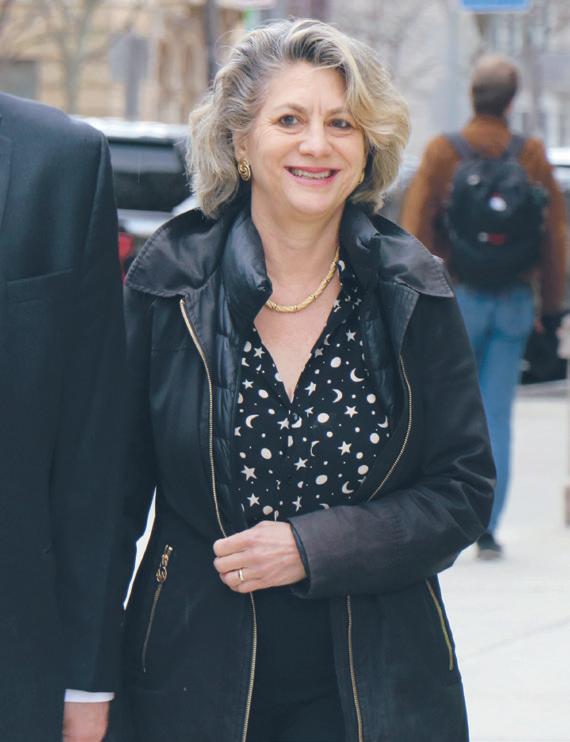
tant chief in 2019, according to Lovello’s email to the University.
During his tenure, Campbell oversaw the arrests of dozens of students and other protesters participating in a pro-Palestinian encampment on Beinecke Plaza, including two forceful arrests of individuals not affiliated with Yale.
“To have the opportunity to serve at the oldest institution of higher learning in the United States, Harvard University, as chief of police is truly a dream come true,” Campbell said in a statement in Harvard’s news release. The former Harvard University Police
BY JERRY GAO AND HANNAH LIU STAFF REPORTER,
CONTRIBUTING REPORTER
Yale’s chapter of the Student/ Farmworker Alliance began circulating a petition on Sunday that asks Yale Hospitality to join the Fair Food Program, an initiative that works with agricultural buyers and producers to protect workers’ rights.
Over 150 signatures were collected within the first 24 hours, according to organizer Arjun Warrior ’26. Students with the alliance will meet with Yale Hospitality in mid-November to discuss a partnership between Yale Hospitality and the Fair Food Program, though its representatives will not be present.
“No Yale student wants the food in our dining halls to come from farms committing human rights abuses,” Warrior wrote in an email to the News. “We know that all our fellow students will stand with farmworkers who are calling on Yale Hospitality to solve this problem by joining the Fair Food Program.”
The petition is part of the alliance’s efforts to ask Yale to become a signatory of the Fair Food Program. The group previously held a film screening in September and organizers published an op-ed in the News last week calling for Yale to become a signatory.
SEE FOOD PAGE 5
department chief, Victor Clay, resigned last May amid allegations of mismanagement of the department, according to reporting by the Harvard Crimson.
According to Head of Public Safety Duane Lovello, who announced Campbell’s departure Thursday afternoon in an email to Yale community members, Campbell will continue leading the Yale Police Department until Jan. 2, 2026. Until Campbell’s successor is named, Lovello will oversee the department, he wrote in an announcement.
BY OLIVIA WOO STAFF REPORTER
Yale College Dean Pericles Lewis announced on Wednesday morning that the two non-competitive opportunities for undergraduates receiving financial aid to obtain funding to travel abroad, participate in internships or conduct research will be reduced to one after summer 2026.
Beginning in summer 2027, the International Study Award and the Summer Experience Award will be replaced by a non-competitive, one-time-use Summer Experience Grant, which will fund “one approved summer program, including Yale Summer Session Abroad, research and internships,” according to Lewis’ email announcement. The change is a part of Yale College’s effort to reduce its budget in anticipation of the endowment tax hike, Lewis wrote in the announcement.
“You could reduce financial aid during the academic year, but that would mean that some students who were needy would either have to pay more or might choose to go to one of our peer institutions that was more generous,” Lewis said in an interview. “I figured among all of the options, the best option was to reduce summer support rather than support during the academic year.”
The Summer Experience
Grant will not fund the non-Yale study abroad programs typically covered by the International Study Award, such as the popular London School of Economics Summer School. It also will not cover the international professional experiences currently eligible for Summer Experience Award funding. In the Tuesday interview, Lewis explained that the anticipated endowment tax hike has placed budgetary pressures on financial aid offerings within the College, forcing administrators to find ways to reallocate funds.
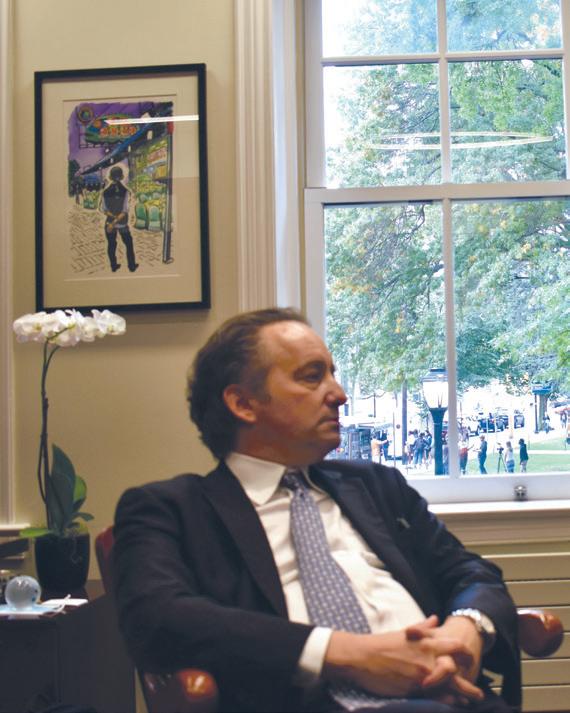
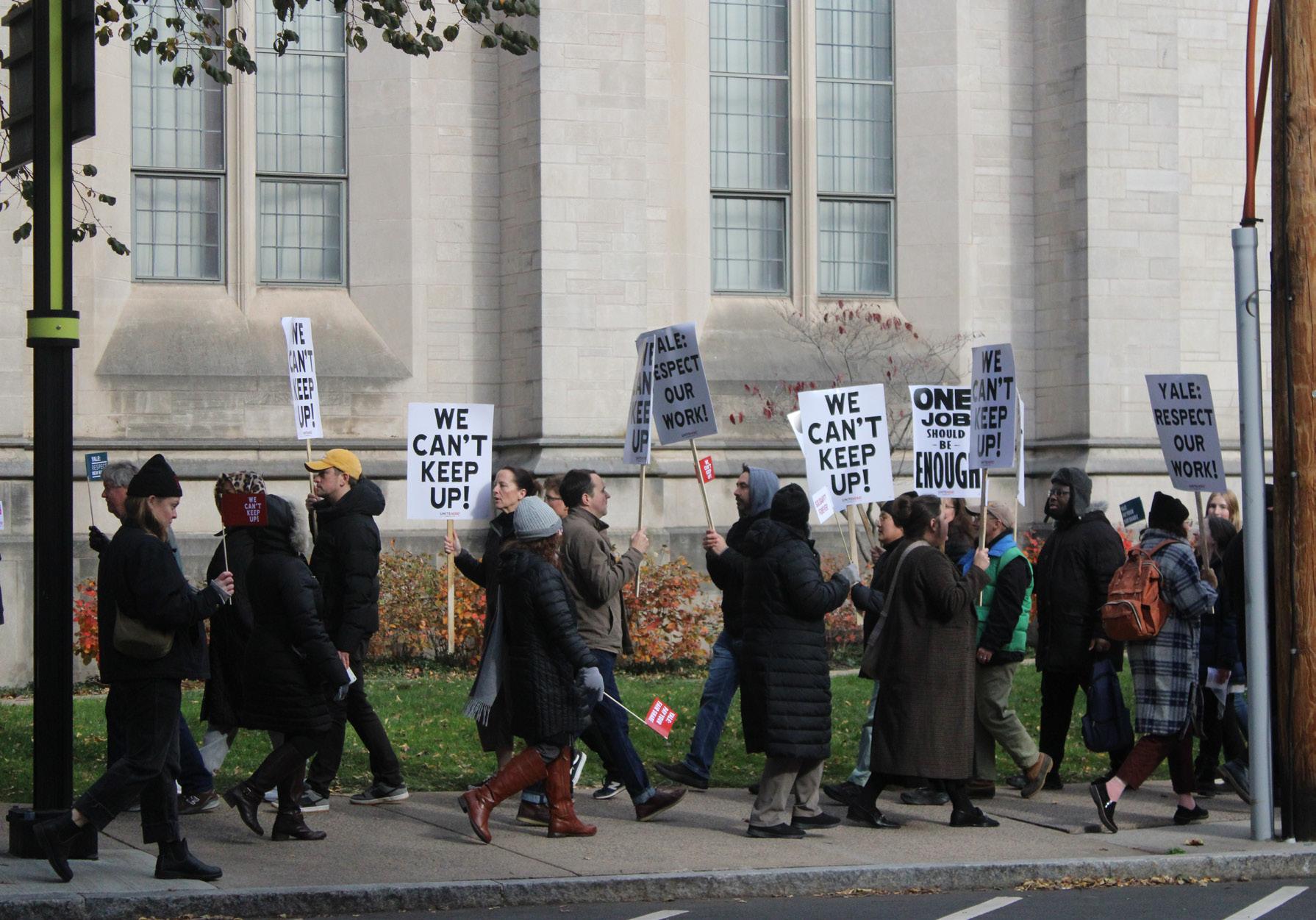
BY JAEHA JANG, OLIVIA WOO AND NELLIE KENNEY, STAFF REPORTERS AND CONTRIBUTING REPORTER
Hundreds of members of UNITE HERE Local 34, Yale’s clerical and technical workers union, gathered at two campus locations on Wednesday for lunchtime rallies to call for higher wages in their upcoming contract.
Local 34’s existing contract will expire in January 2027, and the union has been negotiating a subsequent contract with the University since July, according to organizers. On Wednesday, protesters outside of Sheffield-Sterling-Strathcona Hall
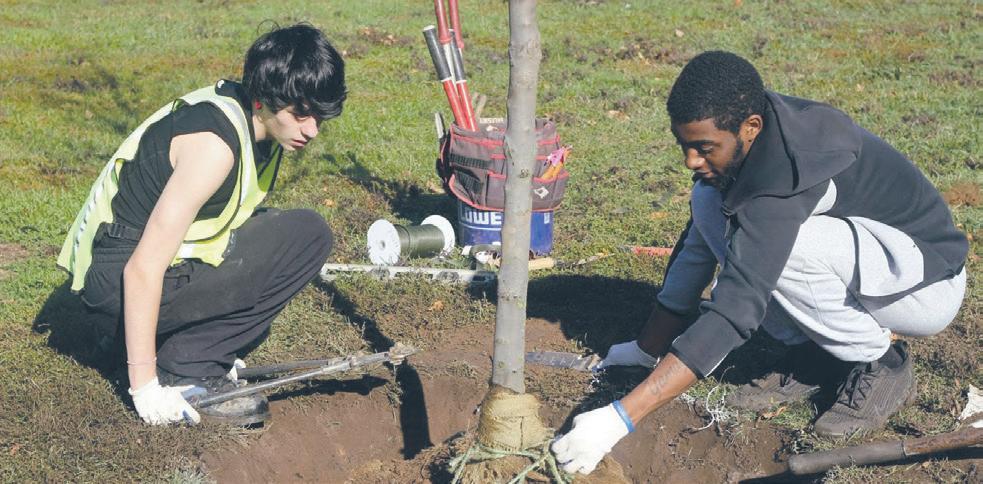
and the School of Medicine demanded that the University offer higher wages that keep pace with inflation.
“When we show up in the streets, that’s when we have power in the negotiating room,” Ian Dunn, the communications director of Local 34, said in an interview with the News.
Tina Posterli, a University spokesperson, wrote in a statement to the News that Yale “looks forward to a positive, productive process that results in a fair agreement for all parties.” Local 34 previously held a “We Can’t Keep Up” march from the New Haven Green to the School of Medicine in September.
More than 300 union members attended Thursday’s rally outside of Sheffield-Sterling-Strathcona Hall. Ellen Cupo, the central campus vice president of Local 34 and a member of the Board of Alders representing Wooster Square’s Ward 8, estimated that between 600 and 700 union members rallied across both locations.
The News could not independently verify the attendance at the rally outside of the medical school.
Protesters emphasized the importance of wages keeping up with inflation, hoisting signs like
November 14, 1917 / Yale Committee Sets New Goal of $40,000 for YMCA War Fund
Yale University raised $29,137.99 in just two days during the YMCA War Work Fund campaign, surpassing its original $25,000 quota and setting a new goal of $40,000 to be reached by Saturday night. Yale now leads all other universities in contributions toward the $1,000,000 national target, with more than $500,000 already pledged across the county. The sophomore class raised the largest amount at $1,645.63, supported by major gifts such as a $10,000 faculty donation and numerous Liberty Loan bond pledges.
Undergraduate contributions averaged $20 per student, totaling over $8,200, while New Haven residents added $135,000 toward a separate local goal of $150,000, recently raised to $250,000. The campaign committee pledged to reach every Yale student before the drive’s end and emphasized that each donation should represent a personal sacrifice, highlighting the university’s leading role in the national wartime fundraising effort.
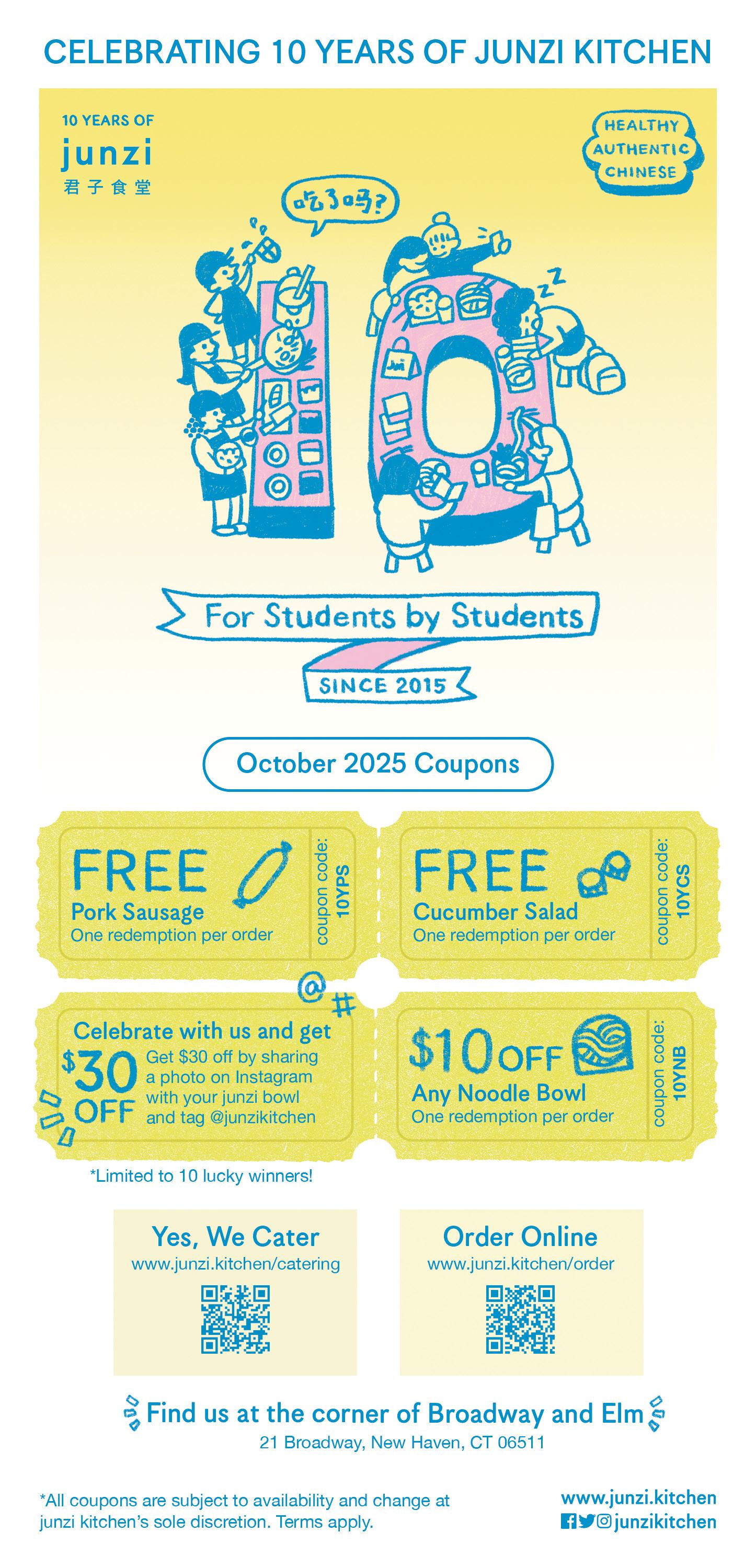

By Jaeha Jang, Olivia Woo and Nellie Kenney
Jaeha and Olivia were 25 minutes into a 11:35 a.m. intermediate microeconomics lecture in room 114 of Sheffield-Sterling-Strathcona Hall when we started hearing lively but unintelligible chants from outside. Curious about where the chants were coming from, we exited class and dove into the scene at the corner of Prospect and Grove. We found ourselves in the middle of a Local 34 protest. As we interviewed protesters, hearing passing cars and trucks honk for protesters and receiving business cards from media relations officers, we ran into our fellow reporter, Nellie. Meanwhile, the doors to SSS were subsequently “redlit,” preventing us from returning to our lecture. We were thus outside to witness as the union members packed up their picket signs and headed back in unison to their places of work. Just as suddenly as the rally had begun, it ended — on schedule.
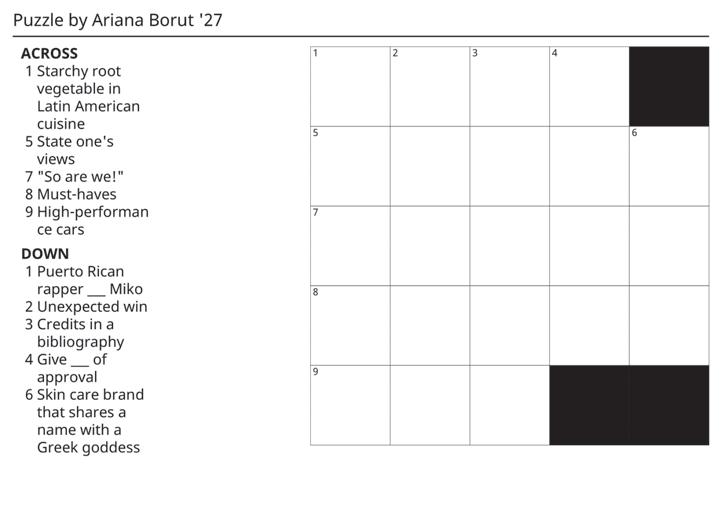
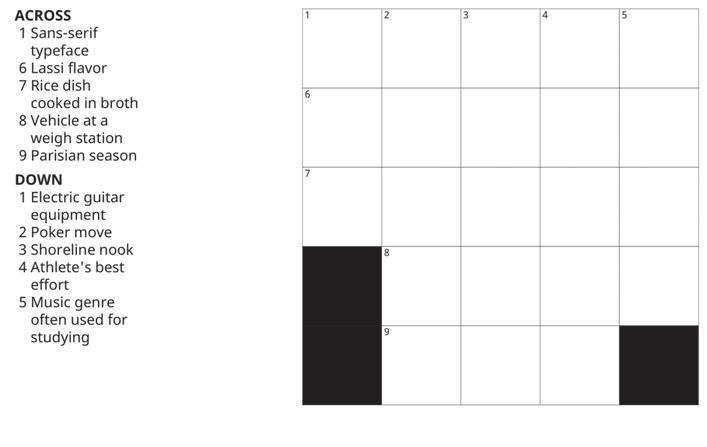

MELANIE TROTOCHAUD
The Yale Young Global Scholars program is a unique opportunity for many. High school students from all over the world stay at Yale for two-week sessions of academic enrichment. YYGS was split into four academic tracks: Literature, Philosophy & Culture; Innovations in Science & Technology; Politics of Law & Economics; and Solving Global Challenges.
For the forthcoming year, Yale has cut the humanities track, known as LPC.
As an instructor for YYGS last summer, I taught original seminars in which I advised students through the process of making a collaborative creative capstone project, and encouraged reflective and social exploration in a global setting. This program allowed eleventh and twelfth grade students from over 150 countries to experience their educational interests in a higher-level setting. Eliminating the humanities track’s unique opportunity for critical intellectual exploration sends a troubling message, especially from a university often called the “humanities Ivy.”
The only cause YYGS cited for the cut is to “increase seats in our remaining tracks.” Though the reasoning remains opaque, the decision reflects how society’s focus on education as a means to a financial end in a dismal job market has impacted both student and institutional decisions.
While it’s true that students have been increasingly shifting towards STEM degrees due to more promising job opportunities, Yale of all institutions should know the persistent importance of humanities careers and of humanities skills for life outside of jobs. Considering YYGS is for intellectual enrichment and not for credit, YYGS is the perfect opportunity to engage in the humanities regardless of where students end up in their careers.
Yale is a school many students look to, trusting Yale still knows the value of investing in the humanities. Many enroll specifically because of its strong humanities programs. It’s worth noting that this year’s reunion for past participants in YYGS who now attend Yale was, anecdotally, almost entirely made up of former LPC students.
The freedom of the LPC’s project-based style was profound for my students as it ushered them into an academic environment that went beyond perfunctory high school regurgitation — they worked in groups of unfamiliar peers making an imaginative project that gave analytical commentary on a given topic.
I had a group that made a video where each of them reflected on experiences where they’d felt “outside of the circle” and what they’d learned about themselves in the process. While in progress, they expressed embarrassment
and nervousness about their project; but after presenting, many in the audience thanked them for their vulnerability, identifying with sentiments the project expressed. The students told me afterward that they felt much more confident in themselves, in being creative and in being sincere.
I know what it is like to be a high schooler interested in the humanities, disheartened by the lack of opportunities and appreciation for my interests. The average high schooler’s exposure to humanities differs significantly from what can be found in higher education. It’s easy to believe that learning history is useless when all you have ever been taught in history classes were seemingly insignificant facts.
These kids were starved for the humanities. Very few high schools offer classes where they get to think critically about the history, art and culture of their lives and world. Very few high schools teach how to think about the implications of historical changes and trends on the lives of people like us, and how the threads of history have shaped everything about the world around us.
If we do not give students the opportunity to ask the important questions through their education, how can we blame them for treating education like a passionless tool? Students everywhere receive so much pressure to direct their intellectual interests towards profit.
I’ve seen so many of my peers following instructions to “go into computer science, study economics, look at the degrees with the highest return on investment” as if education is only a transaction, and not part of our journey of exploration throughout our one human life. Through YYGS, not only did my students get to see what it’s like to have a career in the humanities, they also learned what it means to incorporate humanities and critical thinking into their engagement with the world in everyday life.
Yale, out of all prominent universities, should know what’s at stake. It is Yale’s responsibility to have a role in preserving vulnerable studies. In a country where critical thinking and social studies have been under attack for years, what hope are we giving future generations to invest in understanding themselves and the world’s cultures, history and art? If even Yale is telling high schoolers that their academic interests in the humanities have no place, what hope do they have? Nobody should have to fight for the right to simply exist.
MELANIE TROTOCHAUD is a master’s student at Yale Divinity School studying Religion and the Arts. She can be reached at melanie.trotochaud@yale.edu.

ALEXIS RICHARD
On Thursday, Nov. 6, the United States Supreme Court handed down a decision that will reverberate across the country and deeply impact the Yale community. In Trump v. Orr, the Court ruled that all federal identification — including passports, visas and Global Entry cards — must reflect a person’s sex assigned at birth.
The ruling stems from a series of lawsuits surrounding Executive Order 14168: “Defending Women from Gender Ideology Extremism and Restoring Biological Truth to the Federal Government.” Yet, as a Yale student and future health professional, I can say with certainty that this order does the opposite of what it claims. It does not “defend women” — it weaponizes gender to control and divide. It threatens the freedoms of all Americans who believe in privacy and equality under the law.
At Yale, this decision hits close to home. In July 2025, Yale quietly discontinued its youth medical gender-affirming care services. This move left many students, alumni and community members feeling abandoned. I, for one, came to Yale to pursue that exact field and proudly discussed Yale’s Gender Program in my interviews for the Physician Associate Program. For an institution that prides itself on advancing health equity, this retreat contradicts its stated mission.
After Executive Order 14168 was issued, lawsuits by the ACLU and others ruled it violated the Administrative Procedure Act, the Due Process and Equal Protection Clauses of the Constitution and the right to travel. That decision briefly allowed trans and gender-diverse individuals to continue accessing identification that reflects their affirmed gender identities.
But on Nov. 6, the Supreme Court reversed that progress in a 6–3 decision, with Justices Jackson, Kagan and Sonia Sotomayor LAW ’79 dissenting. Requiring individuals to carry identification listing their sex assigned at birth is forced outing. It dangerously infringes upon privacy and increases the risk of harassment, discrimination and violence. This policy puts
millions at risk, including many Yale international students who come from the 65 countries where LGBTQ+ identities are criminalized, 12 of which punish these identities by death.
According to the National Alliance on Mental Illness, LGBTQ+ people already face disproportionately high rates of mental health challenges — not because of their identities, but because of the relentless stigma, rejection and violence they endure. Forcing people to carry
IT DOES NOT “DEFEND WOMEN” — IT WEAPONIZES GENDER TO CONTROL AND DIVIDE. IT THREATENS THE FREEDOMS OF ALL AMERICANS WHO BELIEVE IN PRIVACY AND EQUALITY.
IDs that contradict their lived identities, and legitimizing those who oppose gender-affirming care as Yale has done, adds another layer of psychological distress, one known to correlate with suicidality and trauma.
According to Yale’s demographic data, 314 students across undergraduate, graduate and professional programs identify as nonbinary, transgender, or report “N/UNK” for gender identity, which is likely a significant undercount. At a minimum, that is 314 people in our classrooms, labs, and clinics whose existence and safety deserve more than passive acknowledgment. As a community committed to “Lux et Veritas,” Yale must stand with them through meaningful action, not silence.
As a student training in public health and medicine, I see the effects of policy decisions like these in both data and lived experience. They have measurable consequences for health, safety, and well-being. If Yale is truly
sincere about its nondiscrimination statement, then it should reinstate its gender-affirming care services, incorporate mandatory genderbased curricula in all schools, partner with students to develop evidence-based solutions and end its deafening silence.
Contrary to the claims of the Trump administration and its allies, trans people exist, and always have, on the natural spectrum of human diversity. Efforts to erase trans existence are neither new nor accidental; they are part of a long tradition of authoritarian control through social division.
Today, one about percent of adults in the United States identify as transgender, and another two percent identify as gender-diverse. These are not abstract numbers. They represent millions of Americans: our coworkers, classmates, professors, friends and family members. This is not a fringe issue. It is a civil rights crisis, and Yale must take a stand to defend its community and its values.
The Trump v. Orr ruling raises urgent questions: Will our institutions uphold the principle that all people deserve to live safely and authentically? Will universities like Yale, with its resources and influence, truly stand for the communities they claim to serve?
The promise of equality under the law and in medicine is not partisan. It is foundational. Ensuring that transgender and gender-diverse people can carry accurate identification, access affirming care and live openly is not just about gender. It is about liberty, safety and survival.
As Yale students, we are taught to pursue truth and justice. That responsibility extends beyond the classroom. It is on us as scholars, future clinicians and advocates to ensure that our university and our nation do the same.
Nobody should have to fight for the right to simply exist.
ALEXIS RICHARD is a firstyear PA/MPH candidate at the Yale School of Medicine and Yale School of Public Health, studying in the Social and Behavioral Sciences Department with a concentration in U.S. Health Justice. They can be reached at alexis.richard@yale.edu.
Having taught Yale College students for 20 years (from 1999 -2020), and having graduated from the all-male, mostly white Yale in 1969, I’ve learned that freedoms of expression can be suppressed by many different stereotypes and presumptions, some “conservative,” others “progressive.” The recent YDN report, “Christakis’ Defenders See Freer Campus Discourse,” tells one half of that story in its account of what happened at Yale in 2015.
Leftist-liberal presumptions about racism, sexism, and “diversity” do sometimes run amok, as I showed in my book Liberal Racism in 1997. But to claim that they did so at Yale in 2015 needs to be qualified. A relatively few students did overreact furiously to Professors Nicholas and Erica Christakis’ defense of transgressive Halloween costumes. An infamous video of a female Yale student cursing out Nicholas Christakis while roughly 20 other students snapped their fingers in support of her was shot by Greg Lukianoff, president of the Foundation for Individual Rights in Education. It became a media sensation and was reposted by the conservative propagandist Tucker Carlson’s Daily Caller under a headline, “Meet the Privileged Yale Student Who Shrieked at Her Professor.”
What the video didn’t show were hundreds of white Yalies having their first frank conversations about race with minority classmates. A thousand
students of all colors joined a vibrant “march of resilience,” some of them leaving my seminar for the day to join the march. A thousand convened in Battell Chapel, where classmates and professors spoke from their deepest humanity, without malevolence or duplicity.
THE VIDEO DIDN’T SHOW WERE HUNDREDS OF WHITE YALIES HAVING THEIR FIRST FRANK CONVERSATIONS ABOUT RACE WITH MINORITY CLASSMATES.
It was a perfect example of the way a good college is a civil society on training wheels: Students, many away from home and in “adult” society for the first time, may try out defensive ethnoracial flag waving, religious and political dogmatism, athletic and fraternal self-segregation, and premature career-ladder climbing. But they’re also learning how and how not to stand up for themselves and to restrain themselves in deference to others.
If some collegiate civil societies are lurching into ditches now, as MAGA enthusiasts and sensationchasing media claim, that’s partly because Trump is accelerating a swift, dark current in the larger society. But most of what I witnessed at Yale in 2015 and often ever since have been constructive public reckonings across racial and ideological lines.
Yale graduates should be known for stimulating such reckonings. The progressives among them shouldn’t give right-wing propagandists and Trump excuses to suppress freedoms of expression against racism and sexism, as Trump is doing by imposing duplicitous anti-“diversity” compacts upon academic freedom. Conservatives shouldn’t “dine out” on exposing leftliberal follies so often that they forget how to cook something nourishing for the rest of us and end up abandoning their kitchen to demagogues. The Yale experience should balance career training with truth-seeking and responsible power-wielding in a civic-republican spirit, instead of teaching adversaries to be right only about how their adversaries are wrong.
JIM SLEEPER ’69 was a lecturer in political science and ethics, politics and economics from 1999 to 2020.
CAMPBELL FROM PAGE 1
Campbell said in a phone interview Thursday evening that he had been approached by a recruitment firm that encouraged him to apply for the position at Harvard in August. He decided to leave Yale because he wanted to get out of his “comfort zone,” he said. In the interview, he also explained that he would get a “pay raise” at Harvard, though he would not specify how much.
“This was definitely a punch in the gut,” Mike Hall, president of the Yale Police union, said in a phone interview Thursday afternoon. “The sentiment among the membership is totally, you know, this is Yale’s loss and Harvard’s gain.”
According to Hall, the Yale Police union received word of Campbell’s departure on Thursday, though members had previously heard unconfirmed “rumblings” of his potential departure.
An “advance notice” email Lovello sent to the Yale Police union about Campbell’s departure obtained by the News said that Campbell had “accepted a new position outside of Yale University.” Yale Police union members received the email at 12:50 p.m. Thursday — about half an hour before the announcement was sent to the Yale community.
In the email to union members, Lovello wrote that the Uni -
versity expects “several members of the YPD command staff to take advantage of retirement incentives offered by the university.”
According to Hall, as part of the University’s new contract with the Yale Police Department, managerial and professional employees are eligible for retirement incentives. Hall anticipates that the YPD “will be losing many of its supervisors who are eligible for the program,” he wrote in a text message.
“This period of transformation will provide an opportunity to shape the future of public safety services at a diverse, world-class academic institution,” Lovello wrote. “Our partnership with the New Haven Police Department also provides space to explore new synergies and the best use of resources.”
In an email sent to Yale Police on Thursday — just minutes before the Yale community learned of his departure — Campbell wrote that it “has been a privilege, an honor, and a blessing to serve with you at America’s oldest campus police department.”
“This is a deeply bittersweet moment. Professionally, this is a tremendous opportunity for me to bring the skills, talents, and gifts that God has placed in me to another historic institution,” he wrote in the email.
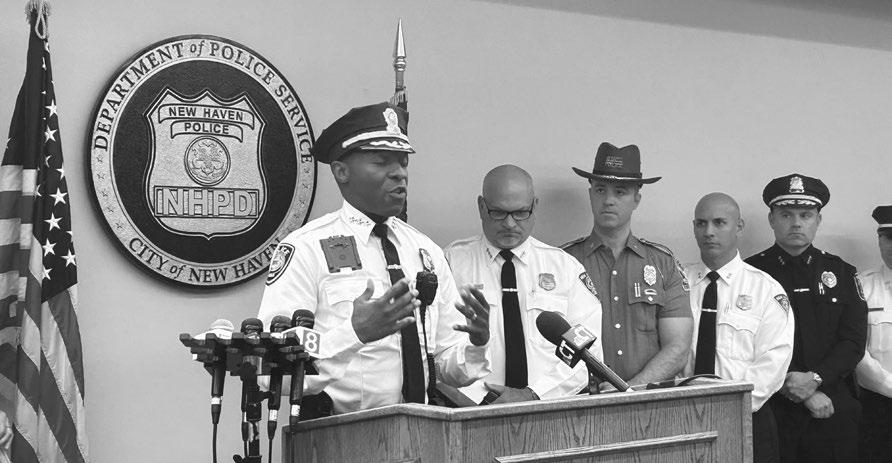
Referring to Cambridge, Campbell wrote, “I don’t know the culture of its community in the same way that I know the culture and community here in New Haven.” He added that “there are so many things here that are just second nature that won’t be there.” In the phone interview, Campbell said that he met his wife at Yale, and all three of his
children were born at Yale-New Haven Hospital.
“It's the place where I learned, really, how to be a man who serves his community,” Campbell said. “So many relationships, so many things that have made me who I am are right here in New Haven.”
When asked who he will be cheering for at the Yale-Harvard football game this year, Campbell said, “Bulldogs all day long.”
Campbell will begin his new role at Harvard on Jan. 5, 2026, according to the university’s announcement.
Anayah Accilien contributed reporting.
Contact REETI MALHOTRA at reeti.malhotra@yale.edu and ADELE HAEG at adele.haeg@yale.edu.
GRANTS FROM PAGE 1
Lewis said in an October interview that though the increased tax on endowment returns “means a permanent reduction in the amount of money available for financial aid,” the University will keep aid packages constant for every currently enrolled undergraduate student for as long as they attend Yale.
“So when we say that financial aid is threatened, we’re not really saying your individual financial aid is threatened,” Lewis said last month. “We’re saying financial aid as a general priority is threatened.”
Wednesday’s announcement came as a surprise to many students who had considered both the International Study Award and Summer Experience Award as potential sources of non-competitive financial support for upcoming summers.
Hours after Lewis’ email, the Yale College Council president, vice president and speaker of the senate circulated an email criticizing administrators’ decision not to brief the YCC on the changes beforehand, describing the choice as “inappropriate.”
The YCC leaders wrote that they planned to “request a formal expla-
nation” from the Yale College Dean’s Office about the rationale behind the changes in a Friday meeting. They requested that students send testimony “about the importance of summer funding at Yale” to help the YCC “compile lost Yale experiences.” Students who have used either the International Study Award or Summer Experience Award in a previous summer may still apply for the other award for summer 2026 if they have not yet used it. Beginning in summer 2027, the Summer Experience Grant will provide one opportunity for students on financial aid to receive non-competitive University funding, though it will not be available to students who have used non-competitive awards in the past. Dorothy Ha ’28, who used International Study Award funding to study abroad through a non-Yale program in Paris and Rome over the summer, said that the changes announced Wednesday have led her to reevaluate her options for future summer experiences.
“Now, I’m like, ‘Oh, I have to lock in this summer to use my SEA so I can maximize the opportunities given to me by Yale,’” Ha said in an interview,
referring to the Summer Experience Award.
Ha expressed frustration about the timing of Wednesday’s announcement and that the Summer Experience Grant will no longer fund nonYale programs abroad.
“It’s just kind of a sudden decision, right? This is coming kind of near the end of the semester when people have already started to look at programs,” Ha said. “I feel like it’s just unfair to the freshmen because there’s so many programs outside the scope of the Yale programs.”
Lewis said on Tuesday that he has asked the Office of International and Summer Programs to “expand” offerings of international Yale Summer Session programs, particularly those in “less commonly taught languages.” These programs will be eligible for Summer Experience Grant funding.
Kelly McLaughlin, the director of study abroad, wrote in an email that the office is planning to launch several programs beginning in summer 2026.
“While further details will be available by early December,” McLaughlin wrote. “I am happy to share that the locations we have in mind include Barcelona, Florence,

Stockholm, Cape Town and London.”
Ha and Naomi Obasa ’29 both acknowledged the financial pressures on the University that prompted the decision to discontinue International Study Award and Summer Experience Award funding. Still, Obasa was disappointed by the decision.
“I think it’s kind of hard, especially when you don’t have infinite resources from where you come from, to be able to find internships and opportunities to better yourself, right? And that’s the point of coming to Yale,” Obasa said. Details about the application process for the 2027 Summer Experience Grant will be announced in summer 2026, according to Yale’s fellowships and funding office.
Contact OLIVIA WOO at olivia.woo@yale.edu.
“We Can’t Keep Up” and “One Job Should Be Enough.”
According to Dunn, clerical and technical workers’ salaries in recent years have not kept pace with the rising costs of groceries, rent and electricity. Some union
members have had to move in with other family members or take on second jobs — “things we never did before on a Yale job,” he said.
“Inflation has eaten away our raises,” Dunn said. “Right now, people are making less than they were in 2020 after you adjust for inflation, and we just need a contract that
reflects that and keeps up with the cost of living.”
Mishelle Raza, a senior administrative assistant at the David Geffen School of Drama, said the rally’s high turnout demonstrates Local 34 members’ conviction that they deserve a higher wage.
“We want to stand by what we are

asking for. It’s not just we’re asking for in paper and behind the scenes, but we truly believe in it with conviction,” she said in an interview at the rally. “And these are those people who can make it out in lunch break.”
Jennifer Garcia, the secretary-treasurer of Local 34, agreed that the high turnout shows that union members are “really, really ready to fight for this contract.”
The University disabled swipe access into Sheffield-Sterling-Strathcona Hall during the rally.
Posterli, the spokesperson, wrote that “the university typically redlights buildings to avoid potential disruptions.”
Protesters described the mood at Wednesday’s rally as enthusiastic and energizing.
“I feel great. I feel excited,” Alex Franqui, a project coordinator for the Yale Alumni Fund, said in an inteview at the rally. “There’s a lot of energy here for our contracts, and people are really hyped up to get a good contract this time around.”
Garcia added that protesting in the daytime was significant because “we know the administration is here.”
University President Maurie McInnis’s office is located in Sheffield-Sterling-Strathcona Hall.
Garcia said it’s also important for Yale students to hear Local 34 members’ demands because Local 34’s upcoming contract will set the standard for all workers at Yale, including
students.
“Local 34, Local 35 works with our students, graduate workers of Local 33, Students Unite Now, which are our undergraduates,” Garcia said in an interview with the News. “So we’re not just fighting for Local 34 members, but we know that the contract that we get raises the standard at Yale for all workers, whether they belong to our union, any union or no union.”
Franqui said he is “really happy” with what he described as Yale’s good-faith negotiations with union representatives thus far, adding that he hopes negotiations continue that way. While protesters acknowledged that the University is facing increased financial pressure due to the increased federal tax on endowment returns, they kept the pressure on administrators to increase workers’ wages.
“Sure, there’s a few difficulties going on,” Raza said. “Every phase of government has its own challenges. But we still have to bear bills. Everybody does.”
Local 34 has nearly 4,000 members, according to its website.
Contact JAEHA JANG at jaeha.jang@yale.edu , OLIVIA WOO
“My music is like a baby pink frosted cake with sprinkles, but when you cut into it, there's a gooey, dark chocolate center..”
SINGER
MELANIE MARTINEZ
The Fair Food Program is operated by the Coalition of Immoka lee Workers, a farmworkers’ rights organization. Buyers that participate in the Fair Food Program buy produce from farms in the program that guarantee certain worker protections and abide by a code of conduct. Buyers also agree to pay a premium of one cent per pound picked, which goes to farmworker wages.
Warrior — who is a member of the Student/Farmworker Alliance steering committee, its main organizing body — said that the group has been seeking to meet with Yale Hospitality throughout the semester and invited them to the September film screening.
“We contacted Yale Hospitality to discuss the Fair Food Program in July, but Hospitality only agreed to a meeting in mid-November, more than four months after our request,” Warrior wrote. “When Hospitality raised
questions about the technical details of the FFP, we offered to include expert representatives from the FFP in our meeting –which Hospitality refused.”
According to Warrior, the alliance will be tabling in Yale dining halls across campus to bring more visibility to their cause, but did not specify when.
A Yale Hospitality spokesperson confirmed an upcoming “November meeting scheduled with members of the Student/ Farmworker Alliance” in an
email to the News, adding that Yale Hospitality aims to increase tomato purchases from Fair Food Program-affiliated growers.
According to the spokesperson, because Yale Hospitality purchases food from third-party distributors, those organizations may be better entities for the Student/ Farmworker Alliance to approach about the Fair Food Program. The spokesperson said Hospitality “can help facilitate those connections.”
Bena Feng ’29 said in an interview that she feels most Yale
students are not informed about where Yale’s food comes from.
“I don’t know a lot about it, but I hope that we can continue to support fair labor,” Feng said. The Student/Farmworker Alliance was first organized in 2000 following a march led by the Coalition of Immokalee Workers, per the alliance’s website.
Contact JERRY GAO at jerry.gao@yale.edu and HANNAH LIU at hannah.liu@yale.edu.
“One of the challenges about the job I had for a decade is that, pretty much, administration took up a large proportion of my time, so I couldn’t do a lot of writing, and I couldn’t do much teaching,” Gendler said in a Zoom interview with the News. “I’m super duper happy about the prospect of being able to do two of the other things that I really, really love about universities.”
Gendler said her seminar on human, animal and artificial intelligence, which she said is intended for seniors, brings together topics on behavioral science and artificial intelligence that she explored during a sabbatical she is currently spending at Stanford University. She also said she was excited to return to teaching the first-year Directed Studies program, which she described as “the greatest course in the world to be able to teach.”
“In the spring, I’m teaching both ends of the Yale spectrum in terms of career cohort,” she said. “I love meeting students on their way in, and I love meeting students on their way out.”
While Gendler taught “Public Plato: Ancient Wisdom in the Digital Age” during a medical leave in spring 2023, she said the standard expec-
tation for full-time faculty in the Humanities division is to teach two courses a semester. She added that she sees no reason why she wouldn’t continue to teach full-time in the fall and the upcoming years.
Gendler, who graduated from Yale College summa cum laude in 1987 with distinctions in the humanities and the mathematics and philosophy majors, served as the University’s Deputy Provost for the Humanities and Initiatives from 2013 to 2014 and the Dean of the Faculty of Arts and Sciences from 2014 to 2024.
In an interview with the News that was published in December 2024, Gendler said she was one of the top contenders to succeed former University President Peter Salovey, whose tenure as president ended in June 2024. She also said she was interested in leading one of the four Ivy League universities that at the time did not have permanent presidents and thought she was passed over for the Yale position because she is uninhibited in her public speaking.
Gendler said that her administrative experience will make her “more imaginative and more effective” in the classroom. Serving as dean — working with the Poorvu Center and reading about tenure cases — familiarized her with other professors’ innovations in teaching, she said.
Since the end of her term last December, Gendler said, she has been spending her sabbatical at the Stanford Institute for Human-Centered Artificial Intelligence and the Center for Advanced Study in the Behavioral Sciences at Stanford. She also said she wrote a book that is “basically an introduction to philosophy in the voice of a stand-up comic,” which she hopes to publish in the “reasonably near future.”
“Imagine Socrates were to give a TED Talk on Comedy Central. That’s the book,” Gendler said. “In some ways, this year that I spent writing a non-academic, popular book was an effort to teach a really, really large audience. Now I’m thrilled to go to the interpersonal part of just teaching students again.”
Gendler said her course on human, animal and artificial intelligence struck her as “the perfect way” to bring together everything she’s learned during her sabbatical. The fundamental question of the course, she said, is “What is it, intelligently, to make sense of the world?”
The first two-thirds of the course will focus on well-developed topics in human and animal intelligence, she said, while the last third will explore “literature that’s literally being written while we are teaching and taking the course.” The course
is cross-listed in the cognitive science, humanities, philosophy and psychology departments.
Gendler is also returning to teaching Directed Studies, the first-year Great Books program that includes two semester-long courses on historical and political thought, literature and philosophy. She said she taught DS for the first time in 1996 and several more times between 2006 and 2013.
She said Directed Studies is the “one course at Yale where you don’t have to write the play and direct the play” and compared teaching the program to writing within the constraints of the sonnet form.
Gendler praised Yale College Dean Pericles Lewis’ plan to expand the program starting next year. To make for a “nice knitting together” of the first-year class, she said, every first year should be one degree of separation from a DS student — just as every student should be one degree of separation from a varsity athlete, an international student and a first-generation student.
Lewis said that Gendler’s return to the classroom — like former Yale College Dean Marvin Chun now teaching and Salovey’s plans to teach next year — is “a sign that they stay connected to the academic enterprise.”
“She’s just a very widely read, knowledgeable person,” Lewis said of Gendler in a Tuesday interview. “Obviously, she’s a philosopher, but she’s very knowledgeable about literature and history and politics as well. So I think she’ll be a terrific teacher of Directed Studies.”
Cognitive science professor
Laurie Santos, who has hosted a podcast episode with Gendler in 2020, wrote in an email to the News that “Tamar is an amazing teacher and I think it’ll be wonderful for students to have her back in the classroom.”
Ariella Kristal ’14, who took “Philosophy and the Science of Human Nature” with Gendler in 2011, wrote in an email to the News that Yalies are “incredibly lucky” to have the opportunity to learn from Gendler again. Kristal recounted Gendler’s passion for teaching, recalling a discussion section when she brought in cake to illustrate John Rawls’ “I cut, you choose” principle.
Robert Nozick, the American philosopher, was one of Gendler’s three doctoral advisors at Harvard.
Olivia Woo contributed reporting. Contact JAEHA JANG at jaeha.jang@yale.edu
BY JAEHA JANG STAFF REPORTER
Jonathan Haidt ’85, a social psychologist who recently published the bestselling “The Anxious Generation,” warned of technology’s harmful effects on Generation Z and urged students to reclaim their attention at a Wednesday afternoon lecture sponsored by University President Maurie McInnis.
Speaking to a packed audience in Battell Chapel, Haidt argued that social media platforms and technological developments have caused a mental health crisis among young people, disrupted American democracy and eroded trust in universities.
“The story I’m going to tell is incredibly dark and pessimistic,” Haidt said to the audience, which
included McInnis, Yale College
Dean Pericles Lewis and former University President Peter Salovey in the front row.
The lecture, titled “How to be a Student in an Era of Anxiety and Political Polarization,” was the second event in McInnis’ Presidential Lecture Series. Raj Chetty, a Harvard economics professor, spoke at the first lecture in February.
Haidt spoke about Yale’s prominent role in shaping national discussions about free speech on college campuses, specifically mentioning speaker disinvitations at Yale Law School and widespread outcry about racial inclusivity at Yale after Halloween in 2015.
Haidt, the professor of ethical leadership at NYU’s Stern School of Business, is the author of three
New York Times bestsellers: “The Coddling of the American Mind,” “The Anxious Generation” and “The Righteous Mind.”
In her introduction, McInnis invoked the spirit of William Blake, the 18th-century artist whose work is currently on display at the Yale Center for British Art.
To McInnis, Blake’s spirit mirrors the spirit of the university, which she described as “the freedom to oppose without ostracism, the freedom to be opposed without being ostracized, that is the creative friction that sparks originality.”
McInnis — highlighting Haidt’s ability to tackle topics such as morality and identity politics — said that his work demonstrates that “we should be able to disagree fundamentally with -

out flinging cranberry sauce or mashed potatoes at each other.”
She said Haidt’s work effectively spotlights the perils of not being able to agree civilly.
Haidt began his talk by referencing a 2022 article he wrote in the Atlantic called “Why the Last Ten Years of American Life Have Been Uniquely Stupid.” Using the Tower of Babel as an analogy, Haidt explained that he had observed a large technology-based shift in culture, politics and mental health in the early 2010s.
Haidt connected developments such as the iPhone gaining a front-facing camera, Instagram launching the “like” button and Twitter adding the “retweet” function to rising anxiety, depression and self-harm in Gen Z. Haidt linked the mental health crisis to changes on university campuses, where students began requesting trigger warnings, safe spaces and speaker disinvitations at unprecedented rates. Videos of campus protests and speaker disruptions went “super viral on the right,” contributing to the collapse in public confidence in higher education, he said.
“The president is attacking us, extorting us, threatening to destroy — you know — grabbing scientific research, saying ‘I’m gonna take away, not your future funding but your payroll next week.’ So incredible things are happening to us and we don’t have the support of the country,” Haidt said. Haidt partially attributed those actions to viral events which “alienated a lot of the country.”
While Haidt acknowledged that Yale has long experienced tension over free speech, he also praised Yale’s recent initiatives, including a partnership with the Constructive Dialogue Institute — which Haidt co-founded with Caroline Mehl — that required first-year students to complete a training about how to consider opposing views.
Shifting from diagnosing the problem to potential solutions, Haidt called on universities to return to their “telos” — their essential purpose — which he identified as the discovery of truth.
Haidt went further and told members of Gen Z that to regain their diminishing attention spans, they should remove addictive apps like TikTok and Instagram from their phones, read entire books and avoid consuming short-form video content.
“Your phone should be a digital Swiss Army knife,” Haidt said. “If you make it a slot machine with companies that give you variable ratio reinforcement, you’re gonna get addicted to your phone.”
During the question-and-answer session moderated by McInnis, Haidt expressed cautious optimism about Gen Z’s future, noting that “Gen Z is not in denial” about technology’s effects.
In an interview after the lecture, Oriana Dunker ’29 said she appreciated both his critical analysis and his hopeful perspective.
“What I took away from the actual lecture itself is that A, I should go home and delete TikTok, and B, that there is a lot of hope for our generation,” Dunker said.
Teddy McGuire ’29 said he enjoyed reading Haidt’s work in high school and was excited to meet him and take a photo after the event.
Another attendee told Haidt after the lecture that Haidt’s work helped her and her boyfriend communicate with one another, adding, “I’m getting married because of you.”
In an interview with the News, Haidt emphasized that individual actions would be insufficient in response to the many challenges he laid out. He said that forming communities and friendships is also necessary and encouraged students to do activities together without their phones, rather than just talking. He concluded his lecture by encouraging the audience to repeat together: “I will give less offense. I will take less offense. I will pass on less offense.”
The Presidential Lecture Series will continue in the spring, though the next speaker has yet to be announced.
Contact JAEHA JANG at jaeha.jang@yale.edu
“It’s a piece of cake until you get to the top. You find you can’t stop playing the game the way you’ve always played.”
BY OLIVIA CYRUS STAFF REPORTER
A group of international students gathered on Wednesday to discuss navigating healthy romantic and sexual relationships at Yale.
The event, organized by the Office of International Students and Scholars, invited students to share their own experiences and outlooks. Attendees reflected on cultural miscommunications in romantic relationships.
“I think with dating culture, people feel like nobody else is experiencing the same thing that they are or having the same questions and being afraid to ask those questions,” Molly Hampton, the office’s associate director for engagement, assessment and operations, said. “So I’m hoping people feel like they’re not as alone in this and that they have resources that they can go to, even if it’s somebody that they met at the session.”
The Office of International Students and Scholars co-hosted “Breakthrough the Bubble: Explore Dating Cultures Across the U.S.” alongside the Sexual Harassment and Assault Response & Education, or SHARE, Center. The event offered attendees pizza
and featured presentations, videos and small group discussions about how to navigate healthy romantic and sexual relationships as international students.
About 20 people attended. One attendee said that talking about romance and sex is more taboo in China than it is in the United States. Another, from Zimbabwe, stated that the freedom to date in their home country is similar to the United States.
Some participants brought up the frequency of “open relationships” in America and how rules and regulations such as “don’t kiss on the first date” can complicate the dating scene at Yale.
Following an introduction from Hampton, Becca Geiger Wallen, a clinician and prevention specialist at SHARE, prompted attendees to split into discussion groups and consider how they discuss sex and dating in their culture and how American expectations of relationships are portrayed in the media.
“When we think about dating and making connections and relationships, we like to think of it as something with a very fixed, set structure,” Wallen said. “But in reality, dating, romance and friendships — all of these things
are influenced by our various cultures and the places in which we get our various values and beliefs.”
Hampton noted that the event originated from the members of the community talking about challenges and their curiosity about how to navigate the dating scene at Yale.
Wallen proceeded to share a video with the group titled “Dating in Australia: Stories from International Students,” where international students discussed queer dating, using social media such as Facebook and dating apps like Tinder and understanding social norms in Australia.
“You have to decide for you what those deal-breakers are and what we should expect from relationships when you should be looking for healthy relationships,” Wallen said.
The final component of the talk entailed a discussion on consent. Wallen offered the New Haven pizza-themed acronym “SLICE” to guide the international students on how to navigate socialization and sexual boundaries. “SLICE,” stands for specific, lack of force, threats or coercion, informed, continual process and enthusiastic.
Cindy Chen GRD ’26, was
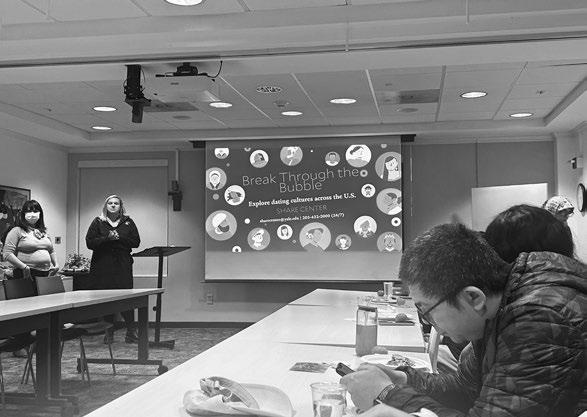
enticed to attend the event after seeing it on Yale Connect. She found the talk “interesting, inspiring, and educational.”
“We explored the concept of consent and dating and sex cultures from places around the world and how to deal with maybe difficult situations that regard intimacy,” Chen said, admitting that she planned to use the lessons
going forward when dating at Yale. Hampton said she was “pleasantly surprised” by how vocal and vulnerable attendees were at the event. In the fall of 2024, 11 percent of Yale College students were international.
Contact OLIVIA CYRUS at olivia.cyrus@yale.edu .
BY JAEHA JANG STAFF REPORTER
Since ChatGPT launched in November 2022, professors have adopted varying methods to address the use of artificial intelligence in the classroom.
Neither of the two introductory lectures in Yale’s most popular major — Economics 1115, or “Introductory Microeconomics,” and Economics 1116, or “Introductory Macroeconomics” — has a policy prohibiting AI use. Instead, the current professors of both courses told the News that they have shifted their classroom policies in accordance with advances in AI technology: They allow AI use in problem sets and grade them for completion rather than correctness.
“In ECON 1116, we explicitly embrace the use of AI,” economics professor Michael Peters, who teaches “Introductory Macroeconomics,” wrote in an email to the News. “I think using AI can be quite effective. Being able to discuss question with a chat -
bot and/or getting a starting point into a new literature and topic is useful.”
Professors of both introductory courses told the News that recent developments in AI technology prompted them to change their problem set grading systems.
Considering the progress of AI technology, Peters wrote, AI can answer problem sets “mostly in a flawless way.” If anything, grading for correctness would punish students who attempt to solve problem sets on their own, he added.
“We now grade for completion and I explicitly tell my students that it is all about trying the problem set by yourself,” Peters wrote. “So far, this seems to be working ok, but this is the first time I am doing that and I will need to experiment more.”
Economics professor Cormac O’Dea, who teaches “Introductory Microeconomics,” also wrote that since he does not ban AI use in class, some students will “understandably use LLMs to check steps,” referring to large language models that power chatbots like ChatGPT.
Grading based on completion, O’Dea wrote, allows him to use problem sets as “low-stakes practice” where students can struggle and learn. Seeking any assistance too quickly — whether from him, a teaching assistant or a large language model — can “short-circuit the slow work where real problem-solving skills form,” he added.
“You won’t have AI in the exam room, and if you lean on it too soon or too often, you’ll be lost when it counts,” this semester’s “Introductory Microeconomics” syllabus notes.
The syllabus also advises students that AI will be part of their college and professional careers and that they should learn how to use AI to “complement your own skills, not replace them.”
Both O’Dea and Peters emphasized that overreliance on AI can hinder learning.
“I think AI can be genuinely helpful for certain tasks, but it cannot replace learning how to reason with economics,” O’Dea wrote in an email to the News.
Peters also wrote that he wor-
ries AI technology might generate disparities between students who use it to complement their learning and those who “take the easy route and learn less than they used to.” It requires considerable effort from students to use AI technology in a productive manner, he added.
The “Introductory Macroeconomics” syllabus for this semester warns that AI chatbots can “hallucinate” and provide inaccurate answers, adding that the ability to judge a chatbot’s answer is only acquired with expertise in both chatbot technology and the relevant class material. It also recommends that, when stuck on a problem, students ask AI for a hint instead of the answer.
O’Dea and Peters also emphasized the importance of flexibility when it comes to AI policy in economics courses.
Giovanni Maggi, the department’s director of undergraduate studies, wrote in an email to the News that AI policies in economics courses are “left entirely to the instructors.”
“My approach currently suits
the course I am teaching, and it may not suit other courses,” O’Dea wrote. “I am glad our department allows instructors to tailor policies to their courses.”
Economics professor Ray Fair, who teaches “Applied Econometrics: Politics, Sports, Microeconomics,” told the News that he gives students “an open ticket to use Chat as much as they want,” referring to ChatGPT.
While ChatGPT can help students develop ideas for their projects, Fair added, it cannot do the exact empirical research and regression-based analysis that he looks for in their papers.
“Chat is now very good at answering problem sets, making up essays, and things of that sort,” Fair said in a phone interview with the News. “That’s not something that I need to worry about.”
This fall, 528 students are enrolled in “Introductory Microeconomics” and 81 are enrolled in “Introductory Macroeconomics.”
Contact JAEHA JANG at jaeha.jang@yale.edu.
BY ARIA LYNN-SKOV CONTRIBUTING REPORTER
Safety upgrades to one crashprone New Haven intersection are part of a city-wide strategy to improve transportation safety.
The Willow and Nicoll intersection in East Rock has seen 18 crashes since January 2022, according to the Connecticut Crash Data Repository — a figure that does not include a fatal collision near the intersection in 2023. Locals’ advocacy efforts, particularly a crash analysis studio session that detailed the causes of a November 2024 crash, were
important for securing the safety upgrades. East Rock residents expressed appreciation for the safety updates, particularly due to the intersection’s proximity to Wilbur Cross High School, the largest comprehensive high school in New Haven.
“This is part of our overall strategy across the city to improve safety for residents,” New Haven Mayor Justin Elicker said in a phone interview.
Ward 9 Alder Caroline Tanbee Smith ’14 SOM ’25 announced the planned safety improvements to the intersection in a LinkedIn post two weeks ago.
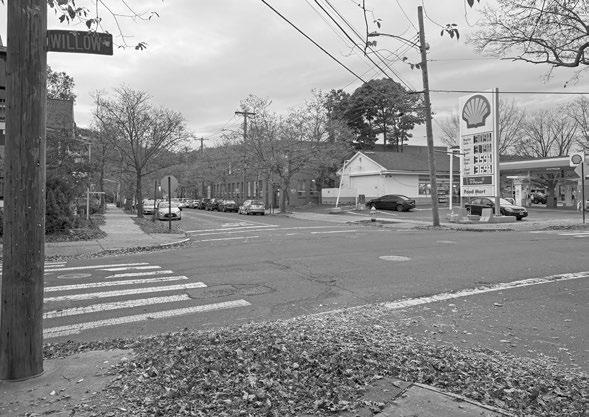
The post listed the various modifications, which include sidewalk bump-outs at each corner, flashing pedestrian lights and visible markings and signage.
In May, a Strong Towns article reported that over 28 crashes have happened at the intersection in the last five years. Strong Towns is a national nonprofit that prioritizes urban development through civic engagement, and the local chapter, Stronger Haven, formed in January.
Peter Clarke — who lives in East Rock — has been involved with Stronger Haven since it was founded, and was one of the East Rock residents who helped run the crash analysis.
“A lot of people feel unsafe driving and walking through there, and there’s been a lot of crashes in the area, so we decided to go ahead and collect data at that intersection,” Clarke explained.
The data he and another neighbor collected for the community-led study included drivers’ speeds, road width and visibility.
“Based on that we could make design recommendations to say these are things that make this street design less safe, and here are some ways we could change it,” Clarke explained. “Our idea is really about advocating for change by looking at the root cause of the problem in the design.”
Clarke said he hopes that city planners can focus on identifying the root causes of crashes instead of solely looking for the cause of the crash in the drivers, which
would allow for more intentional street design improvements.
“That would be a great approach to making some of our streets safer,” he said. New Haven City Engineer Giovanni Zinn ’05 led a recent community meeting attended by around 30 people about the improvements to the intersection, according to Elicker.
“It was a good conversation,” Elicker said. “People raised some other suggestions and ideas, and a lot of them, for various reasons, are not viable at this intersection, but I think having the engineer there to explain our thought process and the design was really helpful to give residents a comfort level that it will be a huge addition to the neighborhood.” Tanbee Smith and Ward 10 Alder Anna Festa also attended the meeting. The Willow and Nicoll intersection is on the border of Wards 9 and 10, so the improvements have been a priority for both alders.
“This has been a priority since the start of the term,” Tanbee Smith said about improving the intersection. “I’ve been talking to neighbors on Nicoll Street and Willow who have been talking about this intersection and it being a real challenge and dangerous for the last 10-plus years.” She and Festa started a petition asking for a redesign that got 200 signatures from neighbors, according to Tanbee Smith.
“Whether you’re a pedestrian or a cyclist or a car, it’s a confusing and
concerning intersection,” she said.
Willow and Nicoll is just a few blocks away from Wilbur Cross High School.
“We prioritize areas that have sensitive populations, like around the school, around the senior home, or have a lot of pedestrian foot traffic,” Elicker said. “I hope people understand that when you look citywide, there’s an incredible need all around the city and that we’re slowly working to address every location that we’ve identified as having a need.”
Charlotte Herzog, a senior at Wilbur Cross High School who, like many students in East Rock, walks to school, described having to wait at the Willow and Nicoll intersection for five minutes every day while people speed through. She said people don’t pay attention to the stop signs or the yield signs, and she was pleased to hear about the safety updates.
Describing the corner as “dangerous,” she said she sees drivers speeding through the intersection frequently and recalled a crash that resulted in the death of a speeding driver two years ago.
“I’m glad that something’s happening,” she said, adding that it’s good to see “that people suggesting things actually works.”
The city aims to begin construction on the intersection in the spring, according to Elicker.
Contact ARIA LYNN-SKOV at aria.lynn-skov@yale.edu .
“Because the sweeter the cake, the more bitter the jelly can be.”
LADY GAGA SINGER
Ex-executive sues Yale New Haven Hospital for nearly $1 million
BY HARI VISWANATHAN STAFF REPORTER
A former chief operating officer of Yale New Haven Hospital sued the hospital last week, alleging that the hospital owes him $994,000 for breaching a contract to pay a series of post-termination payments after his resignation.
According to the complaint filed by former COO Michael D. Holmes on Nov. 5, the hospital failed to issue the first payment of $248,000 — which the complaint says was due on Sep. 3, 2025 —and has refused to make any future payments, claiming that Holmes “failed to provide sufficient notice of his intent to resign.”
“We are aware of the lawsuit that has been filed. Yale New Haven Health denies the allegations and intends to vigorously defend against them,” Yale New Haven Health System spokesperson Carmen Chau wrote in a statement to the News.
The complaint claims that Yale New Haven Hospital agreed to provide a series of post-termination payments, known as covenant payments, if Holmes abided by the terms of a non-compete agreement. According to Holmes’ complaint, the hospital has not claimed that Holmes violated the non-compete agreement.
Holmes signed the noncompete in 2013, when he joined the hospital as its senior vice president of operations. The agreement calls for three payments over 18 months after his
termination date to “incentivize not joining a competitor.”
Holmes’ filing claims he began searching for new employment in 2024 due to “YNHH’s increasing mismanagement of its healthcare system and due to a number of resignations of senior leaders caused by that mismanagement.”
Holmes did not respond to a request for comment.
He was offered a position as senior vice president and Gainesville regional president at the University of Florida Health System on Jan. 30, 2025, and accepted the position on Jan. 31, the lawsuit says.
In a Jan. 31 letter included as an exhibit in Holmes’ complaint, YNHH Chief Human Resources Officer Melissa Turner told Holmes that he had failed to give three months’ notice of his resignation, as required under his employment agreement and was therefore ineligible for any payments.
In his lawsuit, Holmes argues that the hospital is pointing to an agreement completely separate from the non-compete agreement.
“To justify its flagrant breach of its contractual obligations, defendant points to an entirely separate employment agreement that has no relevance whatsoever to defendant’s obligation to render payments under the noncompete agreement,” Holmes’ complaint reads. “The NonCompete Agreement does not contain any provisions that
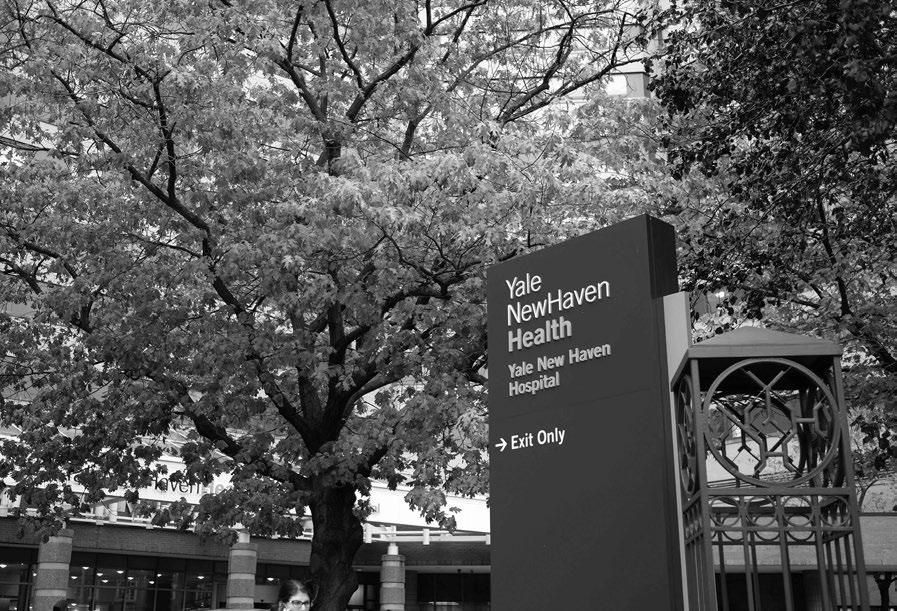
would have required Plaintiff to provide advance notice of his intent to resign.”
The lawsuit adds that Holmes remains in compliance with the non-compete, which bars him from working within 120 miles of New Haven. Holmes argues that his new position in Gainesville,
Florida — approximately 1,000 miles away — does not violate that requirement.
Holmes is seeking $994,000 in compensatory damages for the actual and anticipated breaches of the non-compete agreement, in addition to legal fees and other relief the court may deem appropriate.
initiative striving to regreen New Haven, with 13,000 trees so far
BY MICHELLE SO STAFF REPORTER
At 8 a.m. on a Saturday morning, staff at the Urban Resources Initiative loaded three open-bed pickup trucks with shovels, tarps, axes and buckets.
The initiative began in 1989 as the idea of School of the Environment professor William Burch, who wanted students to gain practical experiences and community-building skills, and has been regreening New Haven since.
Today, the initiative has two main groups that assist with tree planting: Community Greenspace, a city partnership that allows community volunteers to organize environmental projects, and GreenSkills, a jobs program that employs high school students and adults with job barriers.
Colleen Murphy-Dunning, the initiative’s director, told the News that then-Mayor John DeStefano Jr. and the city’s parks officials set
an ambitious goal for tree-planting in 2010.
“They said, but what if we planted 1000 trees? So we went from 50 to 1000,” Murphy-Dunning said.
That number kept rising, and in 2022, the initiative celebrated its 10,000th tree. Recent counts put the total at just over 13,000 trees, with 475 planted this season.
The Yale crew this particular morning consisted of three School of the Environment students, one Divinity School student, one School of Architecture student and one undergraduate.
Through the initiative, Yale students work with locals, including refugees through Integrated Refugee & Immigrant Services and formerly incarcerated people through EMERGE.
Elizabeth Nowlin ENV ’24, a co-manager of the GreenSkills program, took on her role last fall. Since then, it has been a “trial by
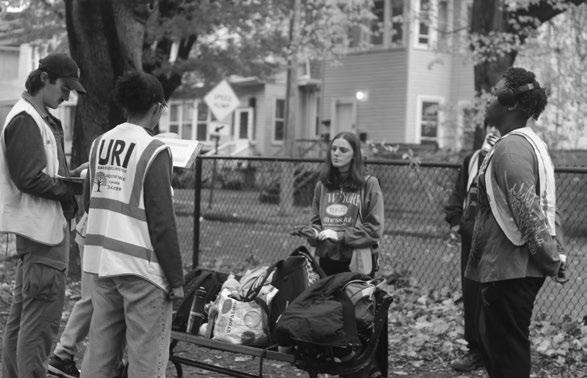
fire,” she said.
“We are a rain or shine crew,” Nowlin said, referring to the cloudy weather. “If it’s just rain, then we trudge on. The kids are very resilient and we have great supervisors who keep them motivated and spirits high with incentives like hot chocolate.”
Students from the Sound School, a vocational aquaculture center, and Common Ground High School, an environmentally focused charter school, are hired through the GreenSkills program. They arrived at staggered hours throughout the morning, immediately putting their hands to work.
At Goffe Street Park, less than five minutes from Yale’s campus, first to arrive are siblings Linnea Loffler, 15, and Leviathan Loffler, 17. Leviathan Loffler has planted trees with the initiative for five seasons — two and a half years — while his younger sister only started last year.
“It’s really cool just to see how much you’re changing New Haven and the difference it’s making,” Linnea Loffler told the News.
As park trees planted decades ago reach the end of their lives, the initiative replaces these city giants with smaller trees in a process called succession planting. As the elders wither with age, the younger trees grow, replacing the original trees as shade-givers in due time.
The initiative planted several trees in Goffe Street Park five years ago. As expected, several trees did not survive, so the crew returned to replenish the stock.
Joi Williams DIV ’27 joined the initiative four weeks ago. She studies religion in the African diaspora, specifically how Black


and Brown women are carriers of religion and stewards of the Earth.
Williams enjoys working with students and feels as though they’ve taught her just as much as she’s taught them.
“I’ve learned a lot about how learning is cyclical,” Williams said. “There’s not one teacher, but we’re all teachers. They teach me so much because I’m new. I don’t know how to do everything, but they’re pros because they’ve been here for so long, and so they’re teaching me a lot, and I hope that I can teach them.”
As the students unloaded trees from the truck, a community member approached Nowlin, claiming the neighborhood didn’t want more trees, because it had plenty of trees already. She cited leaf litter on her lawn and the fees the city charged her to remove it. Nowlin calmly explained that they would only be planting on the field.
Though trees are often viewed unequivocally as beneficial things, there can be such examples of conflicting interests in a shared space. Because the planted trees were on public land, the city did not require resident permission. Regardless,
Nowlin said the initiative tries to be cognizant of residents’ wishes, opting for small-leaved and evergreen plants whose shedding isn’t a concern.
“When we talk about species with people, we’re helping them. We’re educating people to know that there’s many really beautiful kinds,” Murphy-Dunning said. “We ask them, ‘What do you most care about? Is it flowers? Is it fall color? Are you interested in birds?’”
The initiative staff also refer to a planting guide that contains information about shade tolerance, salt tolerance and watering.
The planting day concluded just around 3 p.m., and the new saplings — oaks, maples, honeylocusts — have joined the growing glen at Goffe Street Park. In a decade, the elder trees will have decayed and the young stands will have replaced them in girth and height.
On average, a sidewalk tree lives 10 years, according to a 1978 article in the publication Arboriculture & Urban Forestry.
Contact MICHELLE SO at michelle.so@yale.edu
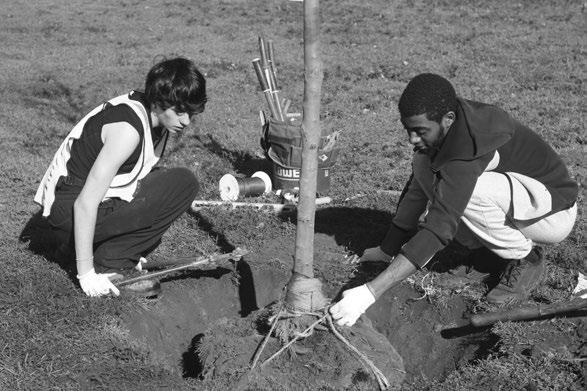
“For me, the cinema is not a slice of life, but a piece of cake.”
ALFRED HITCHCOCK DIRECTOR
BY MELISSA ADAMANTIDI
CONTRIBUTING REPORTER
The Yale Ballet Company will collaborate with the Yale Undergraduate Chamber Orchestra to stage William Shakespeare’s “A Midsummer Night’s Dream” in The Dome at the Schwarzman Center on Friday and Saturday evenings.
Set to Felix Mendelssohn’s score, the ballet reimagines Shakespeare’s tangle of lovers — Hermia and Lysander, Helena and Demetrius — as they stumble through an enchanted forest ruled by the Fairy King Oberon and Queen Titania. Oberon’s servant Puck ensures that chaos reigns through misplaced affection and magical mischief.
“When interpreting this play for a ballet we wanted to keep as many story beats as possible while also adapting the story into dance and what works for our company,”
Valeria Peña ’28, the co-artistic
director and choreographer for the show, said. “We decided to streamline the story due to our company’s size limit. This meant cutting out the play within a play and focusing solely on the two pairs of lovers.”
In this version, Bottom, portrayed by Yala Feikin ’28, is reimagined as a townsperson who accidentally wanders into the forest and is transformed into a donkey rather than a member of an acting troupe.
The production stars Nathan Burns ’28 as Oberon, Camille Chiu ’26 as Titania, Olivia Rosato ’29 as Hermia, Anaum Showkat as Helena, Peña as Puck, Zach Jarvis ’28 as Lysander and Gryffin Wilkens-Plumley ’26 as Demetrius. Mendelssohn’s score will be performed live by the Yale Undergraduate Chamber Orchestra under the direction of Tommaso Bailo ’27, providing the emotional backbone for the piece. Peña explained that the company structured the chore-
BY KIVA BANK AND BRETT PENK STAFF AND CONTRIBUTING REPORTERS
“We got that drip!” the dancers shouted from their starting positions on the stage of the Off Broadway Theater, ready to begin their rehearsal on Monday night. The theater filled with energetic beats as Movement, a K-pop and open-style dance group at Yale, prepared for its semester debut Thursday night.
“It’s more than dancing, it’s a performance,” Movement member Eniola Ajanaku ’29 said. “It’s art.”
The showcase will consist of four performances, at 6 p.m. and 9 p.m. on Thursday and Saturday. The group announced its theme of competitive reality television shows in an Instagram post last week.
The showcase centers around survival shows — reality series in which trainees compete for a spot in a K-pop group — Irene Zheng ’27, one of Movement’s presidents, said. Viewers or judges eliminate contestants each week until a new group is selected to debut.
The showcase is inspired by one survival show in particular, “The Debut: Dream Academy,” a 2023 reality series where the girl group KATSEYE originated.
The performance will also be the debut of Movement’s new members. According to Zheng, the group recruited 10 new members this fall.
She said that many new members saw Yale Movement perform at Dance Jam back in August, a showcase of multiple dance organizations that generated interest in auditioning for the group.
“We’re very excited for the young energy. They’re all very, very excited to be on stage, to be in this space for the first time,” Zheng said.
According to Zheng, the group is hoping to make the show visually
immersive through a variety of mediums.
Zheng said the performance will include video skits in between each dance that have an overarching plot that follows the theme of the showcase as four idols will compete for their debut. The short comedic clips on an LED background will also allow time for dancers to complete quick changes.
“Movement is really pushing boundaries with how this space can be utilized,” she said. “I think we’re one of the only dance groups that actively uses the LED back wall for our background videos, and we also do in-house, very intricate lighting design.”
Zheng said that Movement is also distinguished by their cue calls — phrases they shout at the beginning of each routine to signal to the technical booth they are ready to start.
She explained the presidents will make an announcement before the showcase begins to practice with the audience and help them prepare for the crowdwork that will occur throughout the performance.
Beyond choreography and months of rehearsal, members said the group also provides a space for community and growth. They said the strong sense of community helps spread K-pop culture across the entire Yale campus.
Haeun Rho ’28, a member of the group tapped last spring, said, “I think it’s very nice how people who love K-pop at Yale University got together and get to enjoy this season together.”
Ajanaku said, “It’s just a way for us to escape, and kind of just pull out all the stress after all the hard academics especially at a school like this.”
The address of the Off-Broadway Theater is 41 Broadway.
Contact KIVA BANK at kiva.bank@yale.edu and BRETT PENK at brett.penk@yale.edu .
Performing Arts
Theater “Lost and Found: A Mosaic of Plays” at Nick Chapel Theater, Nov. 15 at 7 p.m., free tickets
“Urinetown” at University Theater, Nov. 19-22 at 8 p.m., paid tickets
Dance
“The Debut” by Yale Movement at the Off-Broadway Theater, Nov. 15 at 6 & 9 p.m., free tickets
“Fame” by Yale Modern Dance Collective at Crescent Underground, Nov. 14 at 8 p.m., free tickets
“Winter Ball” by Yale Ballroom Dance Team in JE Dining Hall, Nov. 15 at 9 p.m., free tickets
“Sabor en Nuestra Sangre” by Sabrosura at Off-Broadway Theater, Nov. 18 at 6 & 9 p.m., Nov. 20 at 6 p.m. and Nov. 21 at 9 p.m., tickets not yet available
Performances
“Fridays @ Five” at The Ballroom, Nov. 14 at 5 p.m., no tickets required
ography around the music’s natural rise and fall, using grand triumphant passages for moments of joy and slower melancholic themes for scenes of rejection and confusion.
“The lovers’ choreography shows a lot of hugs, hand holding and longing gazes to show the audience that they’re in love,” Peña said. “For the comedic elements we added exaggerated and silly movements that made the dancers laugh, and when the dancers are having fun the audience feels it too.”
Co–artistic Director Burns said that balancing creative visions was one of the production’s main challenges.
“Sometimes Valeria wanted something to go one way, and I was thinking of taking a different approach,” Burns said. “But walking and talking through each idea as it came up was the best approach. We’d decide on the overarching theme and divide up the choreogra-
phy from there.”
Burns, who also performs as Oberon, described the ballet’s tone as “drama touched with a hint of humor, like a Disney film that entices a chuckle.”
The production’s technical design also adapts to The Dome’s distinctive layout. With audience seating arranged in a semicircle around the stage, the company is foregoing sets and most props, relying instead on costumes and lighting to create atmosphere.
Peña credited Frida Lopez ’28, the costume designer, and Kiara Warren ’28, the lighting designer, with helping to bring the magic of the forest to life.
Wilkens-Plumley, who portrays Demetrius, noted that the show represents a new era of collaboration within the company.
“This year is much more of a team effort with co-presidents co-artistic directors and a full board
sharing the load,” Wilkens-Plumley wrote in an email. “We are here for scholar-artists; we want you to partake as little or as much as you like, all the way from just attending company class to choreographing a story ballet in your second year!”
The production is supported by the Creative and Performing Arts awards, which are administered by the Council of Heads of College. The Creative and Performing Arts residency offers student artists the chance to bring ambitious projects to life in the Schwarzman Center Dome.
Peña said the most rewarding part of organizing the production has been watching her dancers’ work come alive.
Performances are free and open to the public with registration.
Contact MELISSA ADAMANTIDI at melissa.adamantidi@yale.edu .
BY KIVA BANK STAFF REPORTER
A mystery is in the chilly autumn air and Yale’s hip hop group Rhythmic Blue may be the only detectives able to solve the case. Their mascot, RBertha, has long been out of the limelight, and her brief return to the dance group was cut short by her suspicious disappearance at their fall showcase Wednesday night.
The showcase — titled “RB Who DunnIt” — opened Wednesday in the Off Broadway Theater to an enthusiastic crowd that cheered at every killer twist, turn and popand-lock. The overarching murder mystery theme of the 80-minute show was inspired by the vision of artistic director Tyler Ou ’28 to incorporate the color red into a “dramatic” and “cryptic” plot.
“I wanted to include acting to give the show a little bit more cohesion, but still maintain our identity as a fun, crowdwork-driven show,” Ou said.
Throughout the night, emcees Genesis Browne ’26 and Gabriellie Cabral-Genito ’28 led the audience through energetic skits as they performed the role of detectives to discover which dancer kidnapped the group’s beloved mouse.
Ou said it is a “little known fact” that Rhythmic Blue has a mascot, and he wanted to “reintroduce” RBertha with this theme while also including skits during the traditional emcee breaks.
Tori Browne ’27, one of the group’s executive presidents, said that in past showcases, the theme has not been incorporated into the performance besides the program and the promotional photo shoot.
“I think that keeping the theme in the show itself through emcee
breaks makes it a lot more worthwhile, especially for the artistic director who put a lot of thought into why the theme is what it is,” Browne said. “I hope we are able to choose themes in the future that will allow us to integrate it a lot more into the show.”
The theme was also presented in the photoshoot on Rhythmic Blue’s Instagram page last week to promote the fall showcase. Richelle Chang ’28, the group’s publicity chair, said working on the theme was a “collaborative process” between all board members.
“With this theme, it makes sense that there’s a plot,” Chang said.
Ou said that the change to have a specific script for the emcee breaks was within the group’s “comfort zone” because many members have experience with acting.
Ou, who is also publicity co-chair for Yaledancers, said the use of red in both groups’ November showcase themes was a coincidence.
Rhythmic Blue’s traditions include an introductory video clip at the beginning of the show and a behind-the-scenes video during intermission.
The newly tapped members also customarily start the show following the group opener. This year, the six “RBabies” performed their piece called “Innit,” a mashup of “WNA” by Sdot Go and “WHIM WHAMMIE” by PLUTO and YKNIECE.
“For the audience, it’s a really good way to see our new talent and cheer for them,” Browne said.
“I also think for the babies themselves, it’s really cute to know that they are highlighted at the beginning of the show, when a lot of people’s attention is at its peak.”
Shades of Yale Fall Jam at 53 Wall Street, Nov. 14 at 6 p.m., free tickets
Pitches & Tones Fall Jam at Sudler Hall, Nov. 15 at 7 p.m., free tickets
Yale Dabke Fall Showcase at Crescent Underground, Nov. 15 at 7:30 p.m.
“Bittersweet” ¡Oye! Fall Showcase in Stiles Common Room, Nov. 16 at 7 p.m., free tickets
Comedy Standup Comedy Showcase by the students of CSTD 2300 at Hopper Cabaret, Nov. 14 at 7 p.m., free tickets
Yale School of Music
“Siddhartha, She” by the Yale Philharmonia, YSM faculty artists and Yale Choral Artists with the Yale Opera, Yale Glee Club, and Yale Voxtet in Woolsey Hall, Nov. 15 at 7:30 p.m., paid tickets & free student tickets
Violin by Kyung Yu in Morse Recital Hall, Nov. 16 at 3 p.m., no tickets needed
Yale Repertory Chorus Recital in Battell Chapel, Nov. 17 at 5 p.m., no tickets needed
Cello by Austin Fisher in Sudler Recital Hall, Nov. 17 at 7:30 p.m., no tickets needed
Soprano Laura Miah Ramos Salinas in Morse Recital Hall, Nov. 17 at 7:30 p.m., no tickets needed
Percussion by Andy Akiho ft. Imani
Winds in Morse Recital Hall, Nov. 18 at 7:30 p.m., no tickets needed
Lunchtime Chamber Music in More Recital Hall, Nov. 19 at 12:30 p.m., no tickets needed
“Songs from the Imagination: Music Inspired by the Poetry of William Blake” by Yale Voxtet at the YCBA, Nov. 20 at 5 p.m., no tickets needed
Schwarzman Center
“Magic for Animals” by Liza Toonkel, Nov. 14 at 7:30 p.m., free tickets
“A Midsummer Night’s Dream” ballet, Nov. 14 at 6 p.m. and Nov. 15 at 7:30 p.m., free tickets
“EveryBody Dances” with Yasmine Lee, Nov. 16 at 11 a.m., free tickets
Yale University Art Gallery
“Nusantara: Six Centuries of Indonesian Textiles” exhibit on display until Jan. 11
Hans Hofmann exhibition on display until June 28, 2026
“Keeping Alive the Remembrance” exhibition on display until Oct. 11, 2026
Yale Center for British Art
“William Blake: Burning Bright” exhibit on display until Nov. 30
“Hew Locke: Passages” exhibit on display until Jan. 11 2026
Schwarzman Center
“RUSUNUNGUKO” on display in The Dome Gallery until June 28, 2026
Yale School of Architecture
“Maintaining Impermanence” exhibit on display until Nov. 15
Lewis Walpole Library
“Caricatures, Campagna, and Connoisseurs” exhibit on display until Dec. 23
The group also deviated from some of its traditions in this fall showcase. Typically, the showcase features around 20 pieces, and this year there are only 15 works, including the group opener and closer, choreographed by members. Ou explained that there was more interest this year in signing up for multiple shorter, interlude group pieces rather than solos and duets.
According to Ou, Nneka Moweta ’27 incorporated an original music video into the beginning of her piece, something that has never been done before in a Rhythmic Blue performance. The video showed some dancers lip-syncing in a classroom before they came out onstage to dance to the rest of the song “Sticky” by Tyler the Creator. Moweta and Christian Daniels ’27, the two dance captains, both “made it a point” to incorporate various other styles influenced by African American culture into the group’s choreography, Ou said. This included dance hall, krumping, waacking and voguing in addition to typical hiphop fundamentals performed by the group.
Chang said most of the shows sold out instantly, but she encouraged people who are interested in seeing the group perform to join the waitlist.
“I’m excited for you guys to figure out whodunit,” Ou said. In addition to two performances on Wednesday evening, Rhythmic Blue will perform Friday at 6 p.m and 9 p.m.
Contact KIVA BANK at kiva.bank@yale.edu .
Yale School of Art
“Kitchen Sink” first year MFA showcase on display until Nov. 25
Film & Literature
Public Screenings
“Touch of Evil” screening in HQ, Nov. 14 at 7 p.m., no tickets needed
“The Secret Agent” advanced screening at 53 Wall St., Nov. 15 at 7 p.m., no tickets needed
“We Shall Not Be Moved” screening in HQ, Nov. 16 at 11 a.m., no tickets needed
“The Lady Eve” screening in HQ, Nov. 20 at 7 p.m., no tickets needed
“Wicked For Good” advanced screening in HQ, Nov. 18 at 7:30 p.m., free tickets
Beinecke Library
“Unfolding Events” on display until March 1, 2026
“Textured Stories” on display until March 3, 2026
“All
BY MAYA CHATTERJEE CONTRIBUTING REPORTER
The South Asian Society on Saturday performed Roshni, one of Yale’s largest South Asian undergraduate cultural showcases. Roshni was held in Woolsey Hall and featured performances from Yale’s South Asian dance and music groups, including Rangeela, Jashan Bangra, Kaala, Dhvani and Navarasa. The showcase also presented individual and duet numbers, as well as group acts from each class year. The event’s program noted that the show’s namesake “in several South Asian languages means light and symbolizes positivity and hope.”
Ayshi Sen ’28 — a co-chair of the South Asian Society cultural committee — reflected the sense of positivity and hope in her remarks.
Roshni, she said, “is a huge display of camaraderie. I would say that the energy around the showcase was hard to describe in words. Everyone was so excited, and I know a lot of the dance teams are looking forward to this all year.”
Anjal Jain ’26 echoed Sen’s sentiment. “Overall, the energy is so great in Woolsey. Everyone’s cheering for everyone. All the dance groups are supporting each other.”
Sen explained that the preparation for the event began over summer and required extensive coordination between the society’s board, performance groups and individual performers.
Despite the logistical demands, Sen emphasized that the groups’ collaborative spirit turned the process into an enjoyable endeavor.
Sen also expressed appreciation for the performers, who she said are the heart of Roshni.
“We couldn’t do it without the teams and all of their hard work, and everyone who wants to do individual acts and perform,” she said. “For a lot of them, this is their big fall showcase. For the last two weeks before the show, teams will practice every single day for hours.”
Yale Jashan Bhangra co-captain, Isha Mahadeshwar ’27, described the group’s preparation for Roshni, which included six hours of practice a week. According to Mahadeshwar, Jashan Bangra aims to spread Punjabi culture both on campus and outside of Yale. At Roshni, they performed a high-energy sequence that blended American songs with Bhangra classics. For this year’s Roshni, the team aimed to add new formations to
their dance sequence, “to bring a more modern take to Bhangra,” Mahadeshwar said.
“Something that we really tried to do this year is add a lot more moving 3-D formations into our set,” she said. “They take a lot more time to clean up and synchronize, but I think hopefully it was worth it.”
Mahadeshwar and others described how their performance groups have become meaningful sources of friendship and community throughout their time at Yale.
Jain shared Mahadeshwar’s sentiment about the groups she belongs to, Kaala and Dhvani.
“I remember that when I first came in as a freshman, it was very intimidating for me to find community and spaces where I felt like I belonged. Kaala and Dhvani really provided me with a community that I felt like I could relate to, resonate with, and also make friends through dance and music,” Jain said.
Roshni serves as a means to bring the various groups together to form a collective sense of South Asian culture.
“Coming into Yale and moving away from home, Roshni is the first showcase of seeing South Asian culture being brought to stage,” Sen said. For her individual act — a medley of Hindi songs — Jain
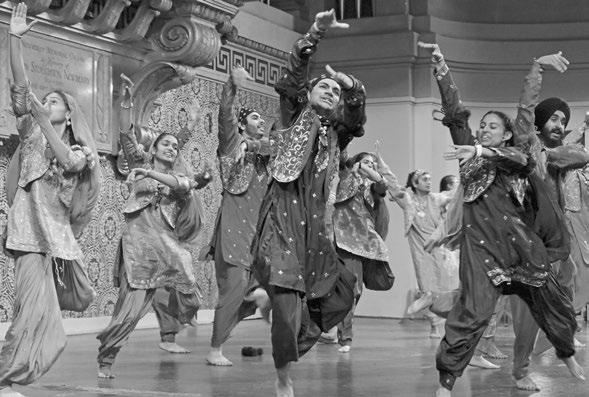
invited Dhvani alum Maanasa Nandigam ’25 to perform with her.
“I asked if she wanted to come and recreate what we had done last year for her senior act. It shows that even beyond Yale, this community still prevails,” Jain said. Sen emphasized Roshni’s inclusive spirit, noting that the event is meant to extend beyond the South Asian community. She described the demographics of the large crowd, which ranged from first-year counselors supporting
their first years to roommates cheering on their friends.
“Even though it is the biggest South Asian cultural showcase, everyone comes regardless of background,” Sen said.
Roshni is one of two South Asian Society-coordinated cultural showcases, the second being Dhamaal, which will take place in the spring.
Contact MAYA CHATTERJEE at maya.chatterjee@yale.edu.

BY HANNAH LIU CONTRIBUTING REPORTER
of Yale alumni filled the home of Samuel Moyn,
Hopper’s head of college, to
the sounds of swing and bossa nova on Monday evening.
The “Before Woodstock: Love Songs of the Early Sixties” concert featured Hopper alumni Jay Gitlin ’71 on piano and Nancy Walecki ’21 on vocals as part of a jazz quintet.
“We’re really enthusiastic for people here to get a chance to
hear this concert,” Gitlin said.
“It’s music that a lot of people don’t get to hear much anymore, and for students, many of them only have a vague acquaintance with these songs, and they’re beautiful songs.”
Opening with “The Girl from Ipanema” and closing on Grammy Award-winning “The Shadow of Your Smile,” Gitlin and the band played a variety of jazz songs including “Lollipops and Roses” and “Will You Still Love Me Tomorrow.”
The ensemble also performed one purely instrumental piece, featuring solos from all four instrumentalists and a “basie ending” — a classic jazz piano progression.
Hopper student Olivia Catayong ’28 appreciated the chance to be able to hear jazz music in a small ensemble setting with alumni from her college.
“After the one song that they sang by Carole King, I turned to Derek, who was sitting here, and I was like, ‘I think this is the best music I’ve ever heard,’” Catayong said. “I really like live music, I like bossa nova, and to
watch this kind of music is really cool. He’s right — you don’t get much of this on campus.”
In addition to Gitlin and Walecki, the quintet consisted of Jim Clark on saxophone, Joe Foster on drums and Steve Taylor on bass — members of Gitlin’s music group Bales & Gitlin Music.
While this was the first time the alumni had performed together on campus, it was an act years in the making.
Gitlin, a senior lecturer of history at Yale, was Walecki’s senior thesis advisor. Walecki, a history major who grew up around her family’s music store, recalled spontaneously playing songs with Gitlin in the Davenport common room during her senior year.
During her time at Yale, Walecki and Gitlin often talked about putting on a concert together. In January, Gitlin reached out to Walecki with the news that the Yale Club of New York City was interested in hosting the pair for a performance in September and proposed the pre-Woodstock era theme.
Walecki eagerly accepted the opportunity to perform with her former advisor, and expressed her gratitude to learn more from the professor post-graduation. After the September performance, Gitlin proposed doing the set again for their college.
“We had always talked about how it would be fun to do a performance in Hopper because we’re both Hopper alumni,” Walecki said. She described their Hopper performance as a “reprise” of the Yale Club act, but with added sentiment: “It’s fun because it’s something we talked about doing for many years.”
Though Gitlin is currently a fellow of Davenport college, Hopper still holds a special place in the professor’s heart, he said.
“It’s really fun for both of us,” Gitlin said. “When I go to Hopper, it still feels very homey and familiar to me.”
Grace Hopper College is located at 189 Elm St.
Contact HANNAH LIU at hannah.liu@yale.edu.
BY SARINA SANGHVI CONTRIBUTING REPORTER
The Yale Record, the campus humor magazine, hosted Emmy-winning comedian Vir Das for a Wednesday evening conversation about his recent book and career.
Moderated by Record chair Devika Kothari ’27, the conversation brought together the Yale community for a discussion about Das’s new memoir, his creative process and his perspective as an Indian comedian who performs globally.
“Everyone can stand to gain from having more vulnerability and authenticity in their lives, and especially with Vir Das, he really was the pinnacle of being authentic and making audiences think,” Zavian Valedón ’27, the staff director of The Record, said.
Das’s recent book, “The Outsider: A Memoir for Misfits,” uses personal anecdotes and humor to explore the comedian’s experience living in India, Nigeria and the United States. His memoir discusses how being a continuous outsider formed his perspectives of belonging and self-acceptance. Early in the conversation, he mentioned that his book is currently on the bestseller list in India.
Reflecting on his journey, Das discussed his experience
previously busking in Harvard Square while doing an acting program at the American Repertory Theater. He said those moments of anonymity before he gained fame helped shape his perspective on being a liminal figure.
He also spoke candidly about his identity as an Indian comedian in the United States, emphasizing the importance of breaking stereotypes and challenging simplifications.
“I just try to be very authentic to my Indian experience, which by the way is very diverse,” Das said.
“There is no one Indian experience.”
Das gave the audience a glimpse into his creative process, explaining that he writes for about three hours every morning, often starting with ideas from his dreams the previous night.
“Ten pages will come from one page, and then I’ll take that one page to a comedy club and go back and rewrite and that eventually turns into one minute of comedy,” Das said.
He noted that when people come to watch comedy shows, they are doing it for the collective experience of coming together to enjoy something, not necessarily just to hear the comedian. If the audience is the instrument and orchestra, Das feels he is, at best, the conductor.
During the question-andanswer portion of the event, Das
discussed his ongoing relationship with success. Despite reaching several milestones, such as writing a book, directing a movie and performing at India’s largest comedy venue, he said he does not see success as stationary.
“If you are always searching for things that scare you, the label of success will never find you,” Das said.
Earlier in his life, Das had originally planned to get a master’s and doctorate in Shakespeare and to become a professor, he said. However, shortly before joining a Shakespeare master’s program at the University of Alabama, he did a stand-up comedy show in Delhi and decided to drop out after two months.
“The second I got off that stage I knew I was never going to get a PhD,” Das said.
After the discussion, attendees lined up for book signing and shared their thoughts on the event.
Many audience members had been following Das for years through social media, his Netflix specials or watching his stand-up performances, and were excited to see him at Yale, they said.
Students who attended the talk said they appreciated seeing a reflective side of Das.
“I really appreciate how he balances real world issues with his comedy, and it was really insightful

to hear him speak on that in this more conversation-based interview,”
Gloria Kunnapilly ’27 said. Kothari said he decided to reach out to Das’ team after seeing that he was scheduled to perform at the Lincoln Center Theater in New York City.
“It was such a shot in the dark, I wasn’t even expecting a response, and thought if we got one, it would be a no,” Kothari wrote to the News. “The next thing I know, they wanted to talk to us, and then everything fell into place.”
According
Kothari, the Yale Record plans to continue inviting artists and comedians to campus. The Record was founded in 1872. Contact SARINA SANGHVI at sarina.sanghvi@yale.edu.
BY BEN RAAB AND WALTER ROYAL STAFF REPORTERS
HAMDEN — Yale lost one sharpshooter this offseason, but it might just have found another.
Sophomore wing Riley Fox ’28 hit three straight threes in the first half against Quinnipiac as Yale (2–0, 0–0 Ivy) dominated the Bobcats (1–2, 0–0 MAAC) 97-60 on Tuesday night. The Connecticut native finished with 13 points on a perfect 5-for-5 shooting line, one of six Bulldogs to score in double figures against the Bobcats.
“The guys played together tonight, we had great contributions from everybody, I was pleased from top to bottom,” Yale head coach James Jones said in an interview after the game.
The Bulldogs are seeking their third straight trip to March Madness this season despite losing two all-Ivy players –– Bez Mbeng ’25, last year’s Ivy player of the year, and John Poulakidas ’25, who led the league in scoring with 19 points per game.
In their first two games, the Bulldogs have looked the part, albeit with a more balanced attack. The Tuesday night blowout win follows a 97–68 rout of Navy on the road in Friday night’s season opener. The Elis have already climbed 37 spots in KenPom. com’s Division I rankings — now sitting at No. 65 after beginning the year at No. 102.
The game started off with a Quinnipiac 5-0 lead, though the Bulldogs quickly fought back to knot the game at 15-15 after seven minutes of action. The teams traded blows for the next four minutes, but following a Keith McKnight layup to give the Bobcats a 25-24 lead, Yale
ripped off a 29-4 run to close out the half. Quinnipiac conceded seven turnovers during the span, which was described by the Bobcats’ ESPN+ broadcast team as “a clinic.”
The second half was more of the same, with Yale slightly expanding its margin and working in more bench players.
As a result, sophomore Jordan Brathwaite ’28 scored a careerhigh 11 points, with nine coming in the second half.
First year Daniel Ogunyemi ’29 scored four points in four minutes on the hardwood Tuesday night. Following his debut performance against Navy last Friday, when he scored five points in three minutes, Ogunyemi currently has a higher career point total than minutes played.
Against Quinnipiac, the team hit 10 of 18 total three-point attempts. Yale’s defense also forced 17 turnovers, leading to just 60 points from the Bobcats.
Strength in the paint
The Bulldogs boast a physical, athletic frontcourt that should be their strength this season.
Forwards Nick Townsend ’26 and Isaac Celiscar ’28 each scored 12 points and grabbed eight rebounds, while 6-foot-10 center Samson Aletan ’27 added 13 points and three offensive boards.
Aletan, the highest-rated recruit in Yale history, was mostly a defensive presence during his first two seasons at Yale but flashed a more complete offensive game Tuesday night, throwing down several dunks and finishes around the rim.
“There’s very few guys as big, strong and athletic as him in the country, much less our league.
We’re glad he’s playing for us,” Jones said of Aletan. Casey Simmons ’26 started on the wing in Yale’s first two games — though he may soon face competition from Fox, who scored 24 in the season-opener against Navy and offers more threat from behind the arc.
Battle for the backcourt
Yale’s biggest uncertainty this season lies at point guard, where
Mbeng started the past three seasons. Trevor Mullin ’27 has the role for now, scoring seven points Tuesday, while Devon Arlington ’26 and Brathwaite have come off the bench. Mullin could face competition from Brathwaite, who knocked down two threes and brought energy to the second unit.
First-year guard Courtney Wallace ’29 also impressed in limited time, looking aggressive on offense with an athletic drive to the basket and a three. Yale will return home for its next two games, beginning with its home opener against Stony Brook on Saturday at 1 p.m. in John J. Lee Amphitheater.
Contact BEN RAAB at ben.raab@yale.edu and WALTER ROYAL at walter.royal@yale.edu.
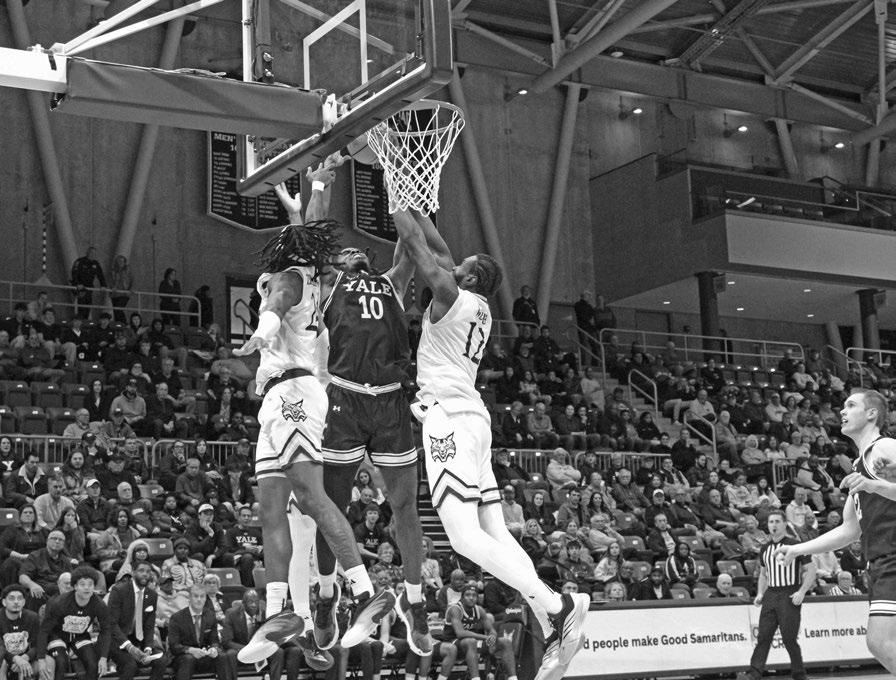

YALE ATHLETICS
Yale will play in its first ever NCAA tournament game on Friday afternoon.
BY AVA JENKINS STAFF REPORTER
For the first time in program history, the Yale field hockey team is headed to the NCAA tournament — a milestone that has sparked excitement across generations of Bulldogs.
The No. 16 Bulldogs earned their historic bid Sunday night and will face defending national champion Northwestern on Friday at the University of Virginia. After a season that included Yale’s first Ivy League tournament appearance and 12 wins — tied for the third-most in school history — players and alumni described the moment as both exciting and meaningful for the team.
“Making the tournament is incredible, it’s everything the team has been working so hard towards and personally is an amazing addition to my senior season,” captain Poppy Beales ’26 wrote to the News. “We know we are facing a really highquality team and it is going to be a battle, but we are training at a high tempo and being very intentional in our preparation.”
Junior back Hettie Whittington ’27 emphasized the significance of the achievement after several years of nearmisses.
“Making the tournament means everything,” Whittington wrote in a text message. “The past few seasons have come to quite abrupt and unsatisfying finishes, without any opportunity for us to play in the postseason.”
Head coach Melissa Gonzalez credited her team’s preparation and mindset throughout the year.
“It has taken a lot of sacrifice, discipline, resilience, humility, and tough training sessions,” Gonzalez wrote to the News.
“For them to achieve such an accomplishment is something to be proud of and something they’ll remember for the rest of their lives. I couldn’t be happier for the group.”
The program’s alumni community also shared in the celebration.
Jan Colarusso Seeley ’82, a longtime supporter and former player, described the championship as a collective
achievement for Yale field hockey.
“This season has been extra special, as the team reached goals never before achieved,” Seeley wrote in an email. “When the team steps onto the pitch, they carry with them six decades of Yale Field Hockey players. I hope they can feel all that love and support, regardless of how the season turns out.”
Luanna Summer ’23 said she has enjoyed watching the team’s growth from afar.
“I think it’s been amazing watching them play this season and how much they’ve improved each year,” Summer wrote to the News. “The coaching staff came in wanting to build a program that was not only at the top of the Ivy League but also nationally competitive — and everyone believed that would happen.”
The Bulldogs (12–5, 4–3 Ivy) will face Northwestern on Friday at 2:30 p.m. in Charlottesville, Virginia. The game will be streamed live on ESPN+.
Contact AVA JENKINS at ava.jenkins@yale.edu
BY DAVIS ZONG STAFF REPORTER
The Yale swim and dive team faces an exciting week ahead as they prepare to dive into backto-back races against Brown and Columbia.
The men’s team has a packed travel schedule for the weekend, heading first to Rhode Island for their season opener against Brown University on Thursday before facing Columbia University in New York on Saturday.
“With travel, hotels, different food and schedules there are a lot more variables to control when on the road,” Noah Millard ’26 wrote in an email. “I think this makes the competition much more similar to our championship meets like Ivies and NCAAs so it is a great practice run and makes the win much more special should
that be the outcome.”
Historically, both Brown and Columbia have been fierce competitors for the Elis. Yale holds a 3-2 overall advantage against Brown over the past five years, with all three victories coming at home. The Bulldogs are now chasing their first away win in Providence. Columbia, meanwhile, holds a 4-1 edge over Yale. However, last year’s dominant showing by the Bulldogs ended a four-year losing streak with a convincing 209-91 victory at home.
“We only get two opportunities over four years to go to the other universities, so it’s always nice to go somewhere new, to hopefully win in their home and their pool,” Konstantinos Zachariadis ’27 said.
The women’s team, meanwhile, is fresh off of a nailbiter of a meet against Brown,
where the competition came down to the wire.
Captain Jessey Li ’26 touched the wall first in both the 100 and 200yard breaststroke events, Grace Wu ’28 dominated the 1-meter dive with a score of 266.33 and Angela Wang ’29 claimed her first individual collegiate event victory in the 200-yard butterfly. Despite earning eight event titles and seven individual wins, the Elis ultimately fell to the Bears, 140-160.
This Friday, the women’s team will host Columbia University at the Kiphuth Exhibition Pool for their home opener. Historically, the Bulldogs have controlled the rivalry, coming out on top in all of their last five matchups.
“Columbia is always a great meet. For me, the excitement comes from performing as a team — hitting our best
performances, supporting each other in every event and seeing how our training translates into real results,” Li said.
Both Yale squads have been training intensely since the start of the year, practicing six days a week, often with double sessions, for about two to three hours each.
“Since September, the captains, Alex Hazlett and Jessey Li did a great job with setting the pace for the teams and being great both in and out of the water,” Zachariadis said. “Our goal this year is to win, so from day one, it was just practice and hard work.”
Even a few months into the season, swimmers on both teams describe a strong sense of community.
“Being a senior this year means I’ve had the privilege of watching the team grow and evolve over the past 4 years.
People are humble and accept feedback, as well as feeling supported by all of those around them,” Millard wrote.
Next week, the men’s and women’s teams will reunite at the Ohio Invitational on Nov. 18.
“Our team strength this year is our depth and our heart. People are showing up every single day — not just physically, but emotionally for each other. This team is hungry, united and really believes in what we can accomplish together,” Li said.
The men’s meet against Brown begins Thursday 5 p.m. in Rhode Island, while the women’s race against Columbia starts Friday, 4 p.m. at the Kiphuth Exhibition Pool.
Contact DAVIS ZONG at davis.zong@yale.edu.
“A
great empire, like a great cake, is most easily diminished at the edges.”
BENJAMIN FRANKLIN FOUNDING FATHER
BY EVELYN RONAN CONTRIBUTING REPORTER
City and state officials gathered at a long-vacant Liberty Street brownfield site in the Hill to celebrate the Monday groundbreaking of a new housing development at the abandoned Electrix Illumination Factory.
Within 18 months, the new complex will stand one block from Union Station, offering apartments for working families, officials said. Mayor Justin Elicker praised the development for its environmentally sustainable and transit-oriented design.
“There’s a lot of other vacant properties we’re looking at. Hopefully, this is the start of a longer journey throughout the city,” he said.
The project involves the redevelopment of the brownfield site into 150 “affordable” housing units for families earning between 30 percent and 80 percent of the area’s median income, according to Seila Mosquera-Bruno, a Commissioner of the Connecticut Department of Housing. The project will be heated and cooled by geothermal energy, according to Elicker.
The development, led by Cortell Development Group and WBP Development LLC, is being financed through a partnership involving the Connecticut Department of Housing, the Connecticut Housing Finance Authority, the Department of Economic and Community Development’s
Brownfield Program and Bank of America, which is serving as both the project’s equity investor and construction lender.
Last year, the city received a $995,600 Brownfield Grant from the state economic and community development department to fund the demolition and environmental cleanup of dilapidated industrial buildings on the Liberty Street site.
Nandini Natarajan, the CEO of the Connecticut Housing and Finance Authority, described new housing as essential for New Haven’s continued development.
“People forget that housing and economic development are very closely linked,” Natarajan said. “Providing this kind of housing is pivotal to the growth of our economy and the people who make it thrive.”
Matt Pugliese, the deputy commissioner and chief investment officer at the state economic and community development department, said the Brownfield program helps cities reclaim blighted land.
“It’s adding to the property value of the neighboring properties by cleaning up this blighted vacant property,” Pugliese said.
“It’s remediating environmental health risks for neighbors in these communities.”
Pugliese said that the state’s Brownfield program is designed to leverage public funds to attract private investment.
“For every public dollar the state

invests, we see almost twenty dollars in private investment for this project,” he said, a “multiplier effect” that, in this case, helped unlock tens of millions in financing from private partners like Bank of America.
Bank of America provided $75 million in financing for the Liberty Street project, the officials said.
“Bank of America deserves more recognition for what they’re doing here,” Jonathan Cortell, the president of Cortell Group, said in acknowledgment of the bank’s 15-year partnership with Connecticut’s housing agencies.
In a press release, Lenny Speiller, Elicker’s spokesperson, framed the project as part of New Haven’s broader push to create 10,000 new housing units over the next decade and to foster more walkable, livable and economically vibrant neighborhoods across New Haven.
“We’re not just constructing a building, we’re laying the foundation for what’s possible when an entire community comes together in service of a higher goal: housing for all,” Elicker said on Monday.
The Liberty Housing Development is located at 10 Liberty St.
Contact EVELYN RONAN at evelyn.ronan@yale.edu.
BY ELIJAH HUREWITZ-RAVITCH, AIDEN ZHOU AND VIA WANG STAFF REPORTERS AND CONTRIBUTING REPORTER
On Tuesday, 14,895 New Haveners voted in the mayoral election, with 84.3 percent opting to reelect threeterm incumbent Democrat Justin Elicker, according to data from the city’s Registrar of Voters. Across the city, total voter turnout rose to 26.1 percent from 24.5 percent in 2023. Elicker won handily in almost all of the city’s wards. His share of the vote was below 75 percent in just three — the Hill’s Ward 3, where he won 72.8 percent, the Annex’s Ward 17, where he won 64.4 percent, and East Shore’s
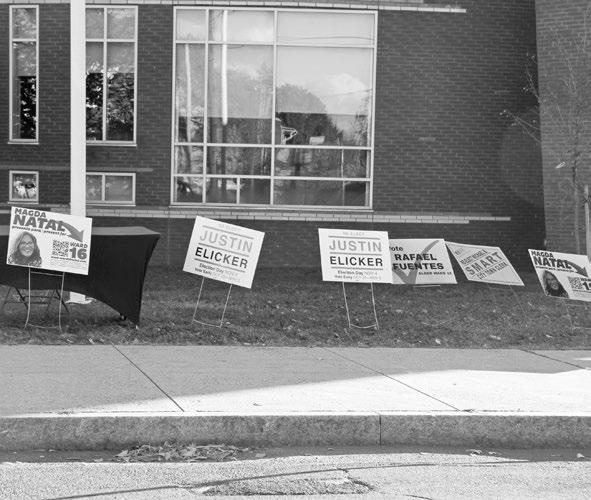
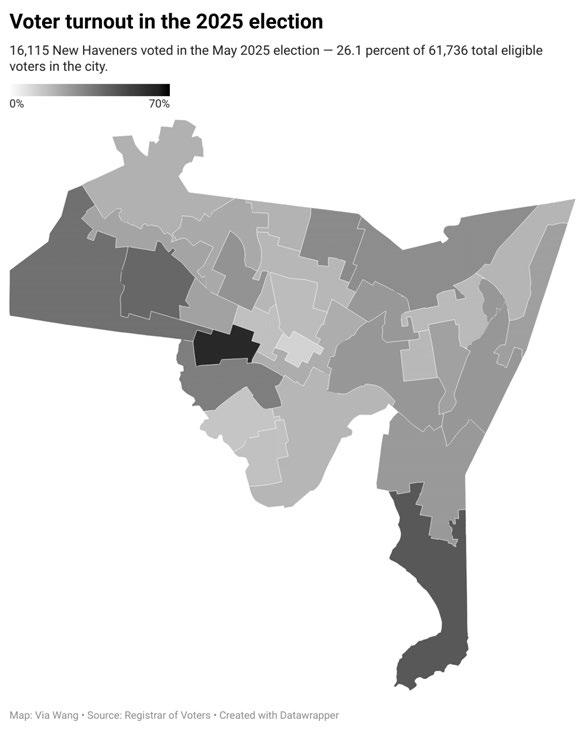
Ward 18, where he won 56.6 percent. Ward 18 saw a higher share of its residents vote for President Donald Trump last fall than any other ward.
In a Tuesday night victory speech at Da Legna at Nolo, Elicker attributed the margin of his victory to his administration’s focus on crime, affordable housing, climate change and his commitment to “fighting back to ensure that we embrace our values and push back on a Trump administration that is attacking the very core of what we stand for.”
Elicker increased his vote share everywhere in New Haven except the Hill’s Ward 3 — which was home to a competitive alder race this cycle marred by allegations of misconduct — and Fair Haven’s Ward 15.
Vincent Mauro Jr., who chairs the city’s Democratic Town Committee, said in an interview the night of the election that the mayor’s win was “a testament to people feeling like, okay, we’re still pushing in the right direction. Is everything perfect? No, absolutely not. But we keep trying.”
Overall, Elicker’s vote share was up slightly from 2023, when he faced Republican and Independent challenger Tom Goldenberg. Since he beat then-three-term incumbent Toni Harp in 2019, Elicker has won with comfortable margins.
Voter turnout — generally low in New Haven — surpassed 30 percent in six of the city’s 30 wards. It was highest in West River’s Ward 23,

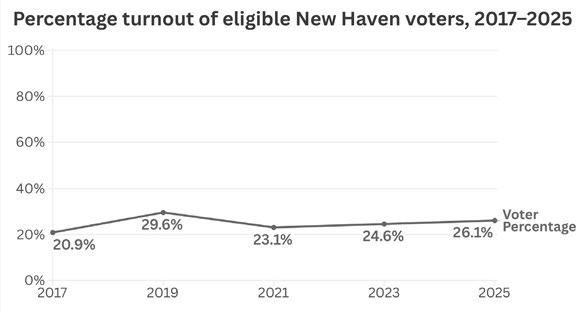
which is represented on the Board of Alders by the body’s president. Turnout has risen slowly since
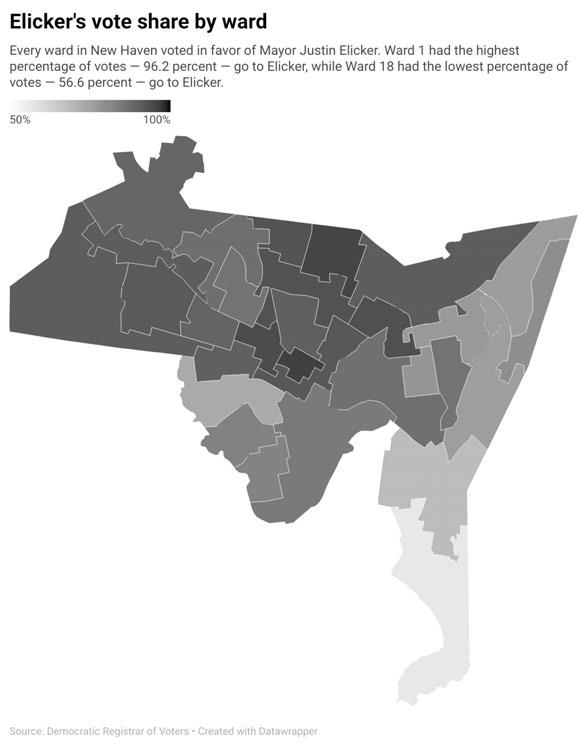
2021. This cycle, it was still down from 2019, when Elicker challenged Harp.
Turnout in Ward 1 — which includes eight of Yale’s 14 residential colleges, Old Campus and many University buildings and is sometimes dubbed the “Yale Ward” — dropped steeply from the Democratic primary in September. In that tumultuous and uniquely competitive race, 36.2 percent of eligible voters cast their ballot. In the general election, that figure plummeted to 10.9 percent. Elias Theodore ’27, who won the primary, was running unopposed. But he aimed to channel the excitement he generated in the primary towards getting Yalies engaged in the mayoral contest.
“If you’re living in a city,” Theodore said in an interview the night of Elicker’s win, “you should know who the mayor is and what they stand for.” New Haven saw little shift in partisan affiliation from the 2024 presidential election. Wards 3, 18, 22 and 30 moved towards the right; all others moved slightly to the left.
Elicker’s Republican challenger Steve Orosco won 15.6 percent of the vote.
Contact ELIJAH HUREWITZRAVITCH at elijah.hurewitz-ravitch@yale.edu and AIDEN ZHOU at aiden.zhou@yale.edu and VIA WANG at via.wang@yale.edu
“Vegetables are a must on a diet. I suggest carrot cake, zucchini bread and pumpkin pie.” JIM DAVIS CARTOONIST
BY KELLY KONG
CONTRIBUTING REPORTER
New Haven held an hourlong ceremony on Tuesday morning at City Hall to commemorate Veteran’s Day. The celebration featured speeches, music, a presentation of colors and the placement of commemorative wreaths at the World War I memorial on the New Haven Green.
The event, hosted by the Mayor’s Veteran Affairs Advisory Committee, welcomed retired Lt. Col. Alison Weir, the executive director of the Connecticut Veterans Legal Center, as its main speaker.
“I appreciate that the city of New Haven, which is not known for a huge veteran population, does go out of its way to celebrate veterans throughout the community,” Weir told the News.
In her speech, Weir encouraged the audience to not only thank veterans, but ask about their time in service.
“If you really want to show interest in a veteran’s service, ask them about it,” Weir said in her speech. “Where were you stationed? What was your favorite memory? Once you get a veteran going, you might find it hard to get them to stop.”
She added that the strength of the U.S. armed forces is its racial, gender and religious diversity.
Former Staff Sgt. Charles Pickett, a member of the city’s Veterans Affairs Committee and the master of ceremonies, served in Iraq and Afghanistan. He said he has been on the committee for
over a decade.
“It’s a pleasure and an honor to put on the town ceremonies every year for Veterans Day and Memorial Day,” he told the News.
The Connecticut Minuteman Composite Squadron of the Civil Air Patrol presented the colors.
Music Haven, a music school in New Haven, played the “Armed Forces Medley,” which combines the official marchpasts of the six branches of the U.S. armed forces.
Sen. Richard Blumenthal flew in the morning of the ceremony to offer his remarks. He spoke about the need to “leave no veterans behind,” maintaining medical care for them at a time when there have been cutbacks on Department of Veterans Affairs services.
“We have a proud tradition of honoring veterans,” Blumenthal told the News. “We should never try to balance our budget on the backs of veterans.”
In July, the Department of Veterans Affairs announced its plan to reduce its staff by nearly 30,000 employees by the end of the 2025 fiscal year, but claimed that “VA performance continues to improve.”
Bryan Standish, the commander of the New Haven chapter of Veterans of Foreign Wars, came to support local veterans and those who served throughout the nation’s history.
“We’re part of the original 13 colonies,” Standish said. “It does make it more special having served and knowing that you are an extension of our forefathers who came a long, long time ago to
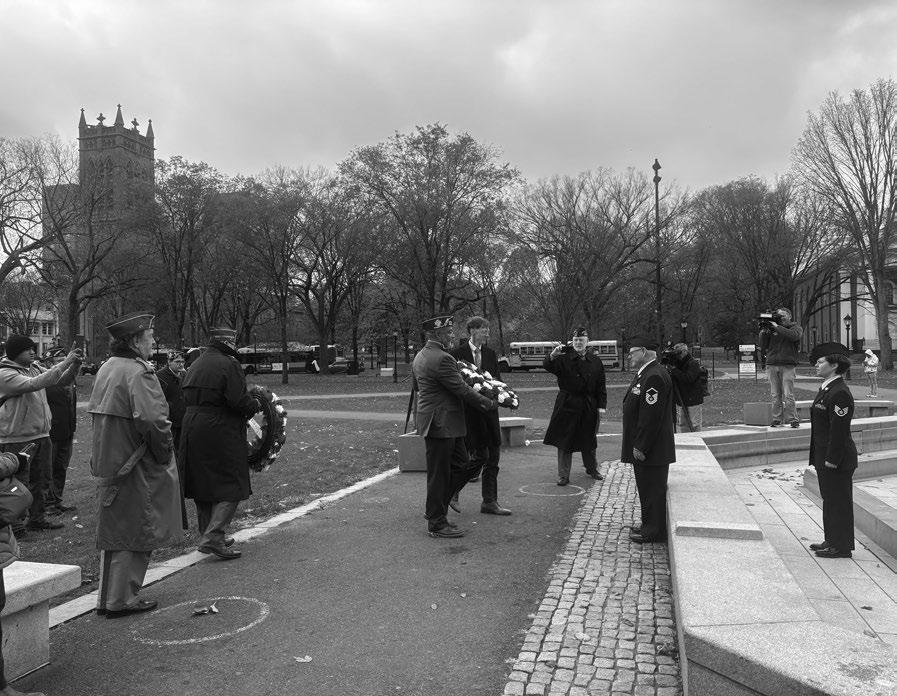
start something that is still going on 250 years later.”
Retired Master Sgt. Cliff Potter led the Pledge of Allegiance and soloist Ruth Rosa sang the national anthem before Mayor Justin Elicker offered his remarks.
Elicker said it was important to commemorate those who have
served in the U.S. military not just on Veterans Day, but also every day by being better citizens.
“That means truly focusing on this liberty: not our individual liberty, but our collective liberty to support people that disagree with us and to support the nation that we all work hard and believe in,”
Elicker told the audience. Veterans Day began as a commemoration of the armistice that marked the end of fighting in World War I on Nov. 11, 1918.
Contact KELLY KONG at kelly.kong@yale.edu.
BY ASHER BOISKIN, LEO NYBERG AND ANAYAH ACCILIEN STAFF REPORTER AND CONTRIBUTING REPORTERS
Students and recent graduates from over 40 institutions across the country gathered at Yale Law School over the weekend and drafted a statement calling for major reforms to higher education.
The “Reimagining Elite Higher Education” conference drew about 200 students, alumni and professors to create a proposed contract for elite universities. The statement accused selective universities of being havens for elites and proposed transparency in admissions and the abolition of legacy preferences.
The three-day conference — organized by the Graduate and Professional Student Senate, or GPSS, and Class Action, an organization seeking to reform higher education — brought speakers and panelists to discuss the history of higher education and the roots of public mistrust in universities.
Seven attendees from Yale, the University of Texas at Austin, Barnard, the Massachusetts Institute of Technology and Stanford interviewed by the News listed frustration about their institutions’ responses to President Donald Trump’s attacks on higher education and curiosity about a new social contract for universities as reasons for attending the conference.
In an interview with the News, GPSS President Saman Haddad LAW ’26 called the event a “massive success.” Haddad said that attendees left feeling “empow-
ered, equipped with organizing tools, and understood the main takeaways from each of the panels.”
In 2024, Class Action successfully advocated for a law that bans universities in California from considering legacy and donor status in admissions. Stanford opted to withdraw from the Cal Grant program, which provides financial aid to California residents, to avoid being subject to the law.
According to the conference’s program, Yale Law School affinity groups and the Yale College Council sponsored the conference. YCC Senate Speaker Alex W. Chen ’28 wrote in a statement to the News that the council had voted unanimously over the summer to support the conference.
“As higher education changes faster than ever, the YCC supports the development of a more equitable path forward for the immense pipelines of power and opportunity that institutions like Yale must use for the good of society,” Chen wrote.
The conference comes as the Trump administration has scrutinized higher education, freezing federal research funds and negotiating settlements with universities such as Columbia, Brown and the University of Pennsylvania.
YCC President Andrew Boanoh ’27 tied the conference to University President Maurie McInnis’ Committee on Trust in Higher Education, saying that he was “excited” for how the sentiments of the conference would “inform” the committee’s report.
On Sunday, Boanoh and Chief
Financial Officer Aaron Chen ’27
introduced a bill to provide $3,000 in “emergency” funding to the GPSS to cover conference costs. According to the bill, the GPSS had “insufficient budgeted funds.”
The senate ran out of time at its Sunday meeting to consider the bill.
‘Recycling the elite’
To kick off the conference, Evan Mandery, the Class Action board chair, said he hoped the conference would produce a “Port Huron Statement for our time,” referring to the 1962 manifesto written by Students for a Democratic Society that called for participatory democracy and social change.
Ryan Cieslikowski, the director of Class Action, said the relationship between private universities and society has broken down, citing President Donald Trump’s proposed compact with some universities to provide preferential funding in exchange for policy changes.
The organizers of the conference provided a draft document called “An Academic Social Contract for our Time” and participants proposed changes with markers on large sheets of paper.
While the “academic social contract” drafted at the conference was not final, it called for larger incoming class sizes, an end to legacy admissions and ethical investments from universities, such as in affordable housing and local businesses.
The draft condemned universities for creating student pipelines to business consulting, Wall Street and Silicon Valley. On Sunday, organizers sported t-shirts read-
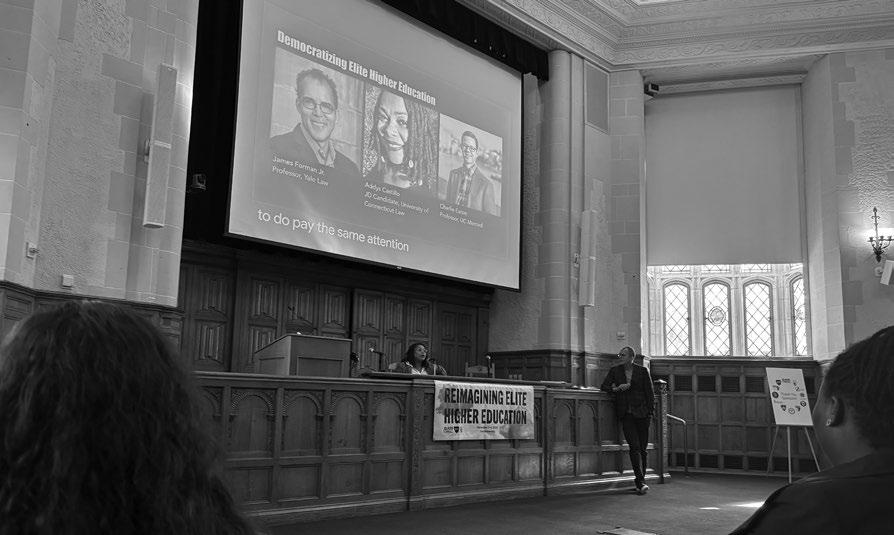
ing, “Is this a college or a country club?” Attendees were given a shirt with the same message in gift bags throughout the conference.
The statement referenced inequity in the makeup of the student body. The draft contract referenced a study by Harvard professor Raj Chetty, which said elite institutions admit more students from the top one percent of earners than from the bottom sixty percent combined.
Haddad echoed that concern, noting that “Yale admits roughly five to six times the number of students from the top one percent of the income distribution as from the bottom 50 percent.”
“One thing I wish people knew is that our admissions systems fail horrifically to understand and value the amount of human capital that exists in that bottom fifty percent,” Haddad said.
Cieslikowski and other conference leaders acknowledged that although the contract from the conference would not get the same national publicity as Trump’s compact, they hope their message can gain traction because it is written by students.
Krasi Staykov, a senior organizer at Class Action, said the contract is a “tool” for students to start thinking about their priorities and demands from higher education. He added that highly-selective universities are “recycling the elite and making them more powerful.”
Emily Hettinger ’26, a conference co-chair and the former YCC Speaker, said Yale encourages careers in tech or finance instead of in public service or education. She pointed to recent blog posts from the Yale Office of Career Strategy, which she said focus too much on tech, finance and consulting. She called for Yale to “compete with McKinsey” with stipends for summer work in the public sector and for the University to celebrate students who pursue public-oriented careers.
“I don’t think individuals are responsible for the extent of the harm,” Hettinger said in an interview. “I think the universities are doing a lot to enable this, and I think these companies have a lot of power, and they’re exploiting students’ anxiety about the future.”
During a Saturday panel titled “A conversation on Fighting for Change,” Wendy Kopp, the founder of Teach for America, criticized universities for drifting from their stated missions. Kopp also expressed concern about students increasingly pursuing lucrative jobs in finance and consulting rather than taking public service paths.
Kopp recounted a conversation with her son, a Princeton student, about whether the university lived up to its motto of service to humanity.
“What percentage of anything you experienced at Princeton has anything to do with that motto?” Kopp said she asked her son.
“His answer was zero,” she said. Debating universities’ role in public life
Participants discussed aspects of the academic social contract in small groups and in back-and-forth exchanges on the large posters. They debated a section of the contract which accused universities of selecting their trustees for their “wealth and power” instead of for their expertise or academic connections. Some argued that the contract should not antagonize trustees, who need to be convinced by it in order to implement the policies proposed at the conference. Others said appeasing trustees is the exact opposite point of the conference.
“There was a moment where I was worried things were getting heated,” Jared Rhee ’27, a conference co-chair said in an interview. “But it wasn’t that things were getting heated. Everyone just cared so much about this discussion.”
Daniel Markovits B.A. ’91 J.D. ’00 restated his concern that schools were similar to a factory instead of a space for “spiritual realignment amid students, a new understanding of what it is to believe or to know something, and a new sense of a person’s own self and their relationship to the world.”
National Urban Fellow Addys Castillo said to the delegates, “Universities take advantage of the fact that students are only here for a little while.” She believes that universities underestimate the difference students can make to bridge the gap between elite universities’ wealth and the impoverished communities that surround them.
“You can’t have a one-sided relationship with a community; both sides need expectations and accountability,” she said in an interview. “No matter how white the ivory covered towers are — everything else is black and brown.” Trump signed an executive order on April 23 to reform the higher education accreditation process to ensure universities prevent unlawful discrimination and ideological bias.
Contact ASHER BOISKIN at asher.boiskin@yale.edu, LEO NYBERG at leo.nyberg@yale.edu and ANAYAH ACCILIEN at anayah.accilien@yale.edu.

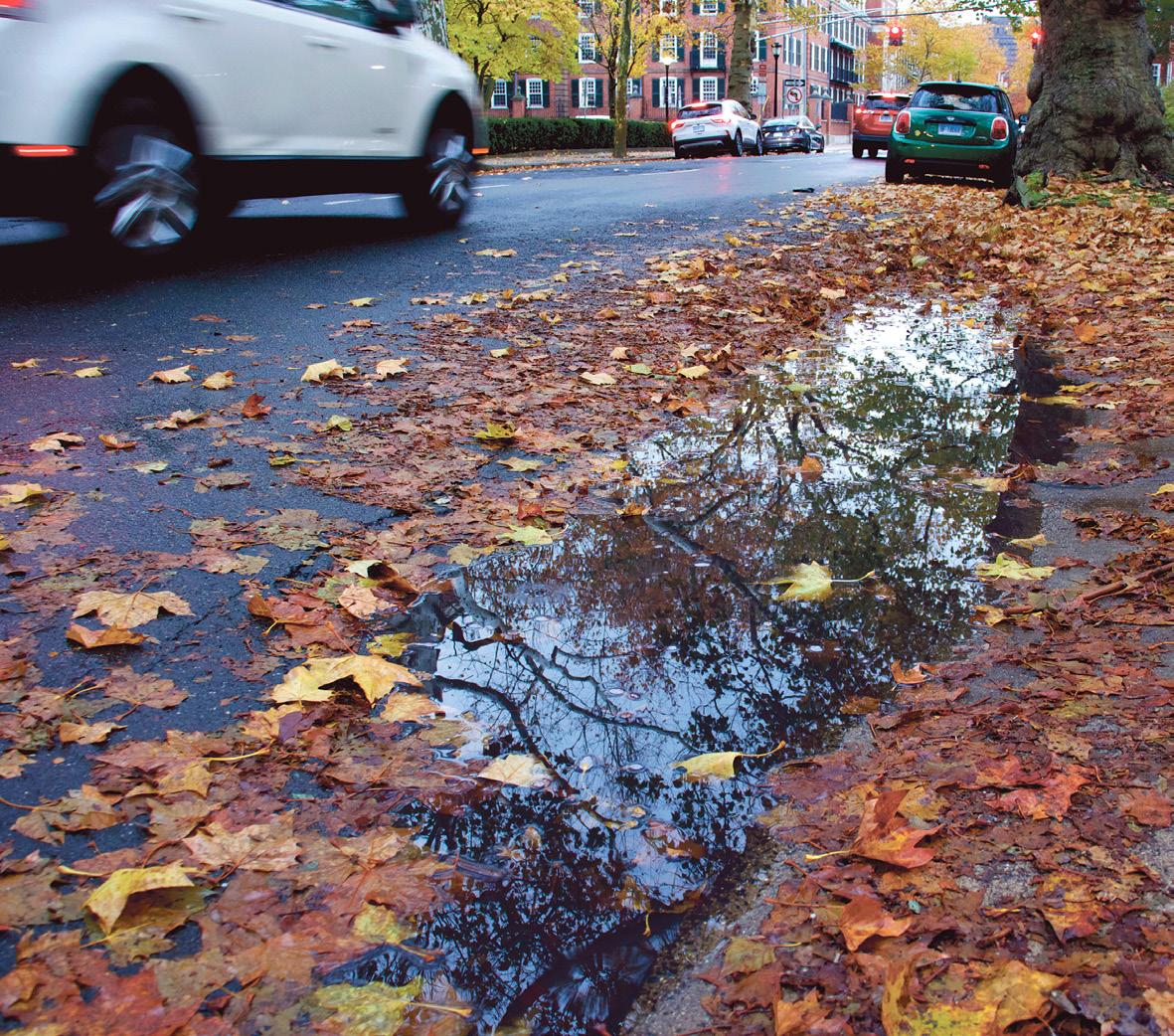

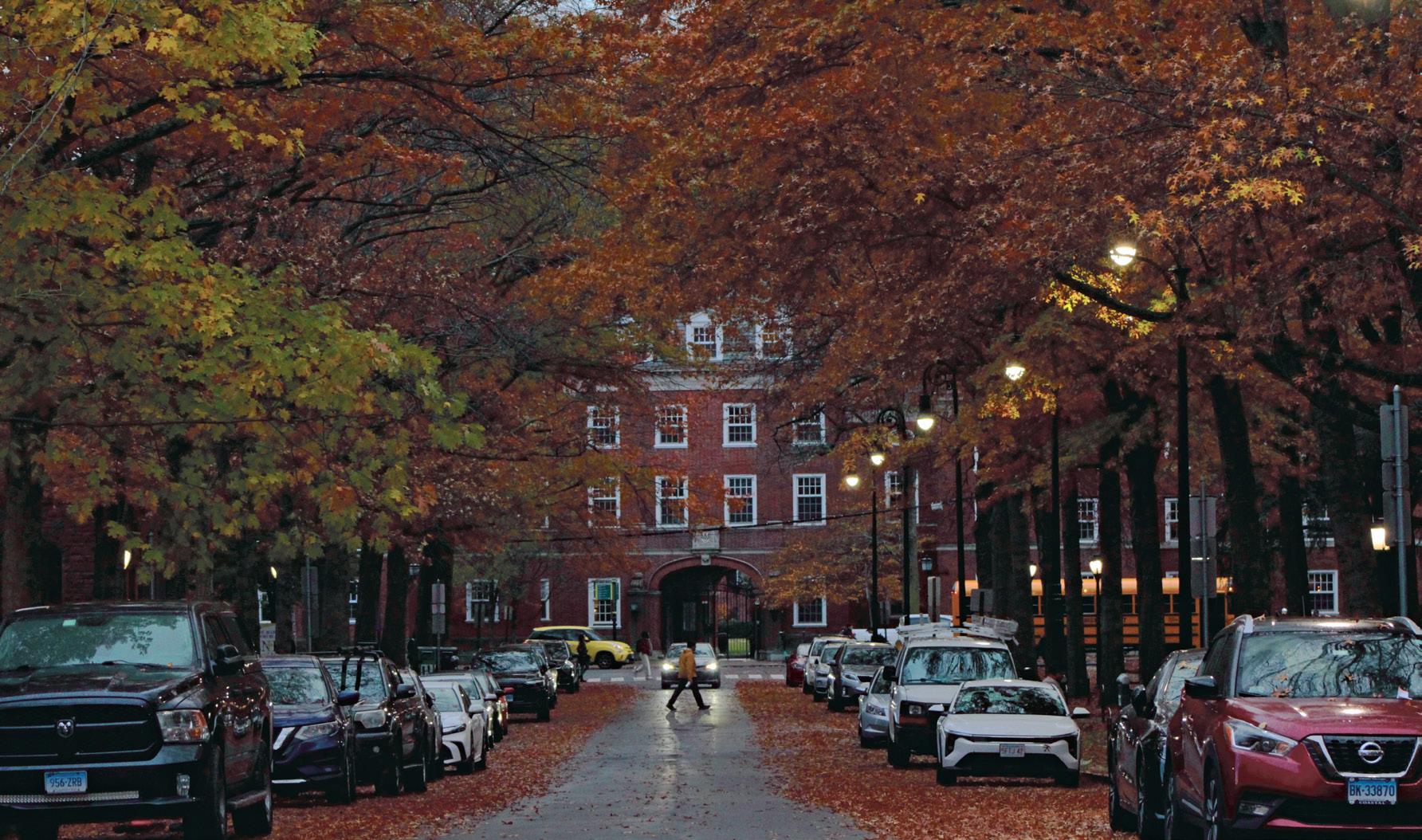
Photos by Abby Assouad and Alex Hong Contributing Photographers

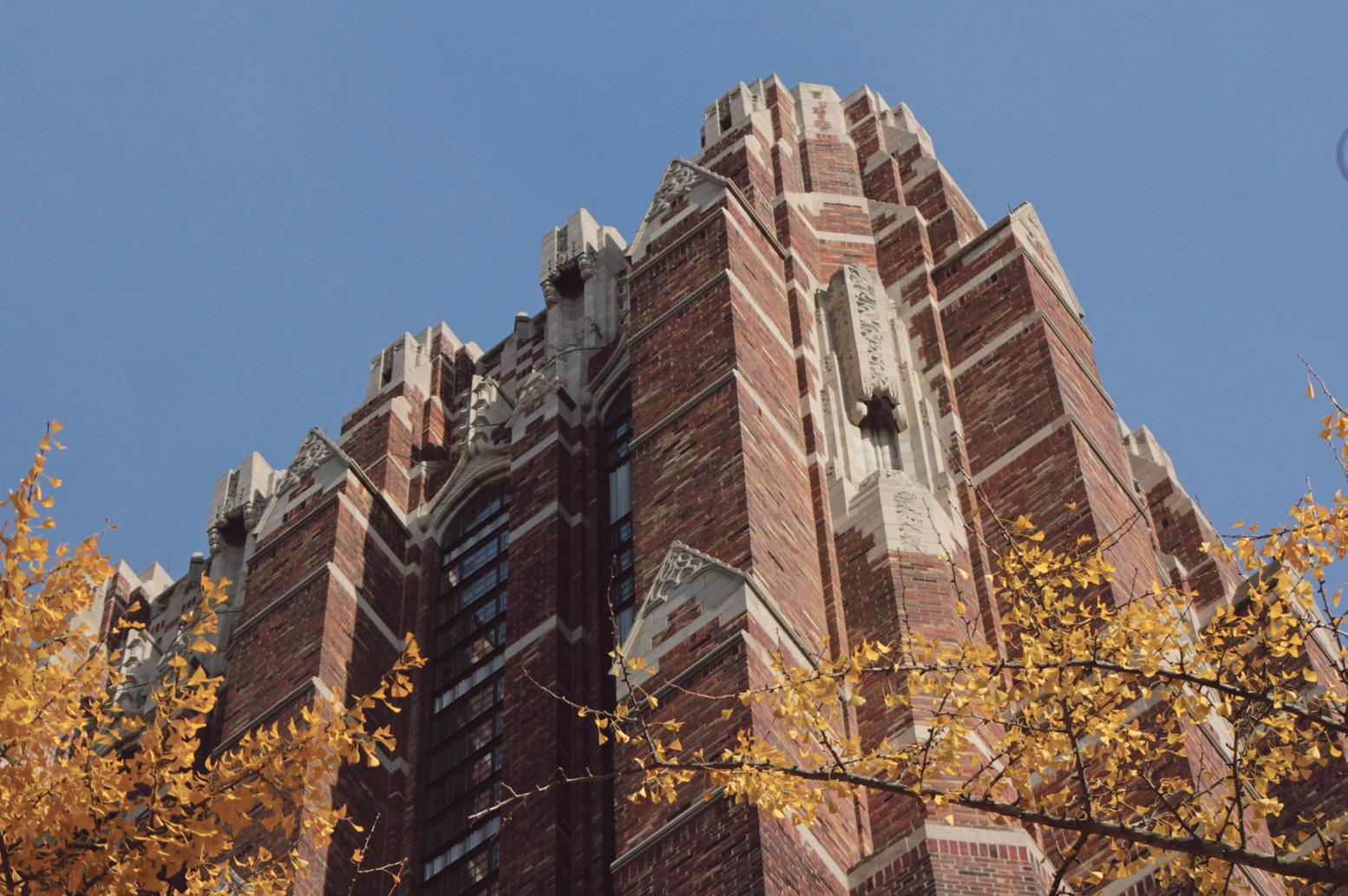
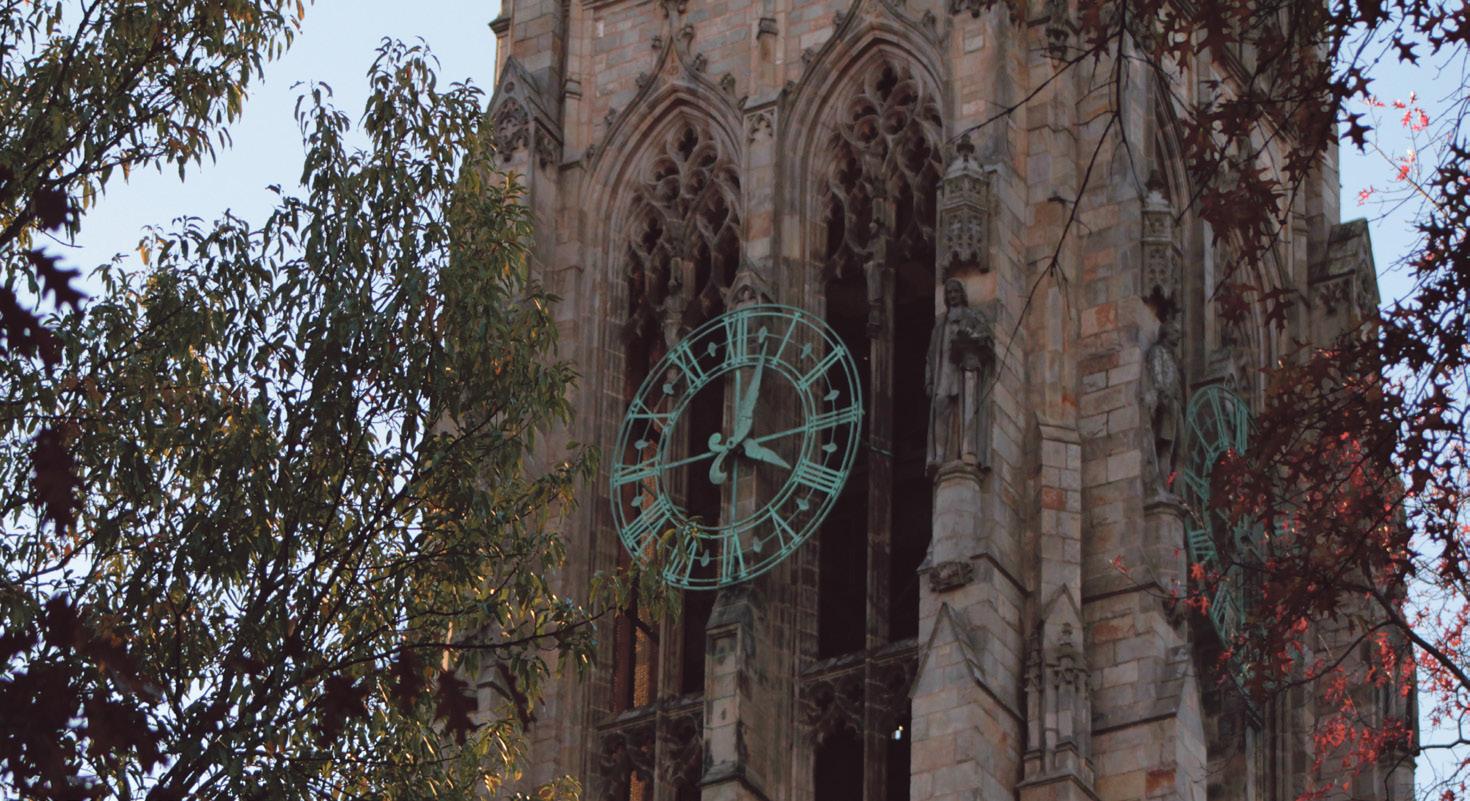
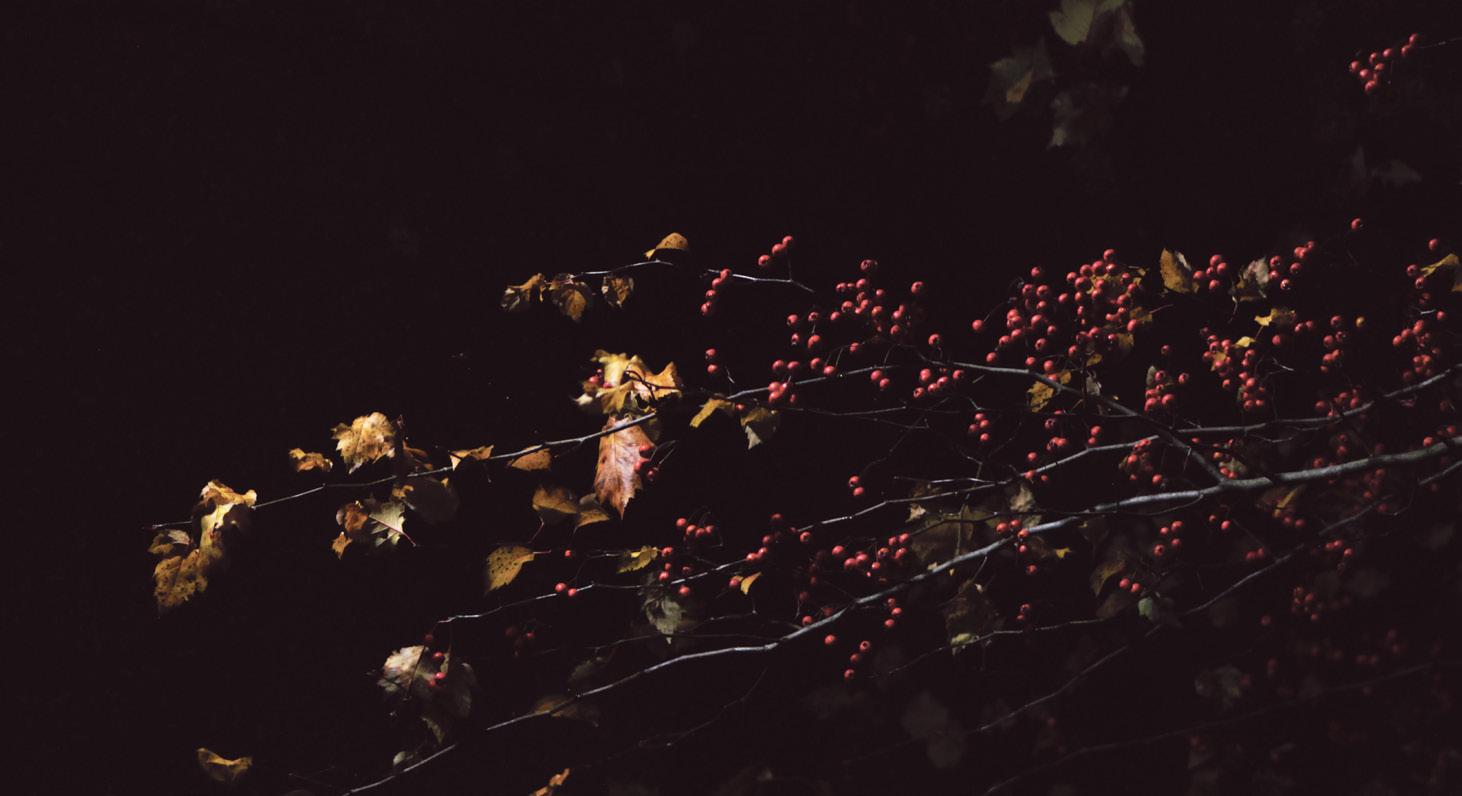




BY BRODY GILKISON STAFF REPORTER
Team 152 (6–2, 4–1 Ivy) will be heading down to New Jersey this weekend to take on Princeton (3–5, 2–3) in its penultimate game of the regular season.
The Bulldogs enter the matchup blazing hot after four consecutive victories, while the Tigers have dropped three games in a row, the last two both being three-point losses.
Every game down the stretch is important for the Bulldogs’ Ivy League championship and Football Championship Subdivision playoff hopes. After Penn’s (5–3, 3–2 Ivy) loss to Cornell (4–4, 3–2 Ivy) last weekend, Yale now sits alone in second place in the Ivy standings, trailing only No. 7-ranked Harvard (8–0, 5–0 Ivy), which has been undefeated this season.
With a win against Princeton this weekend, next week’s showdown between the Bulldogs and Crimson would become the de facto conference championship game.
Taking a look at Princeton
At first glance, it is easy to overlook the Tigers based solely on their record. While they are 3–5 on the year, there are several games to take note of on their schedule. In their second game of the year, they beat Lafayette (7–3, 5–0 Patriot) 38–28, a team that is in first place
in the Patriot League this season. Additionally, they dropped a game earlier in the season to a very good Mercer (8–1, 7–0 SoCon) team, which is currently in first place in the Southern Conference.
Princeton played a challenging non-conference slate, and if not for a comeback win by Cornell and a close three-point loss to Dartmouth (6–2, 3–2 Ivy), the Tigers’ record could look dramatically different.
“Our league has a lot of parity, we have played eight teams, and six of them have been ranked or receiving votes and two are in the top 10,” Princeton head coach Bob Surace said to a local Princeton newspaper. “Five of the games were more than winnable. But being close, the margins are really thin. We just have to continue to tighten up on some of the errors we are making, whether it is me, whether it is players. It just needs to come together.”
As far as skill positions go, Princeton hasn’t quite found its “go-to” guy this season. Taking the majority of the snaps at quarterback is Kai Colón, who averages 191 yards per game through the air, and he has thrown for nine touchdowns and five interceptions thus far. Colón ranks second-worst in the Ivy league this year among qualified passers, with a 129.2 passer rating. On the ground, the Tigers are also searching for an answer. Princeton has used a committee of backs this year, averaging 120 yards per
game and notching 15 touchdowns running the ball in their 2025 campaign. On the other side of the ball, the Tigers have been getting outrushed by nearly 40 yards per game by their opponents and have surrendered 4.5 yards per carry with 18 touchdowns allowed.
How the Bulldogs can win
Taking into account Princeton’s rush defense vulnerabilities, Josh Pitsenberger ’26 could build upon his career day from Yale’s last game by continuing to attack the opposition on the ground. With the improved chemistry of Yale’s offensive line leading to gaping holes at the line of scrimmage, Pitsenberger hasn’t been the only Yale running back racking up yards for the offense this season. Senior back Billy Daal ’26 has also accumulated over 300 yards on the ground while averaging an astonishing 5.9 yards per carry. Using the two backs together, the Bulldogs could be able to overpower Princeton’s run defense and take control of the ground game early on.
“Every year, we face adversity in the form of injuries, this year being no different,” center Leo Bluhm ’26 said in an interview. “I credit our success in the run game to our programmatic standards that prepare us for sudden changes.”
While Yale’s ground game has been the focal point of its offense all season, the Bulldogs’ air attack has also been above average.
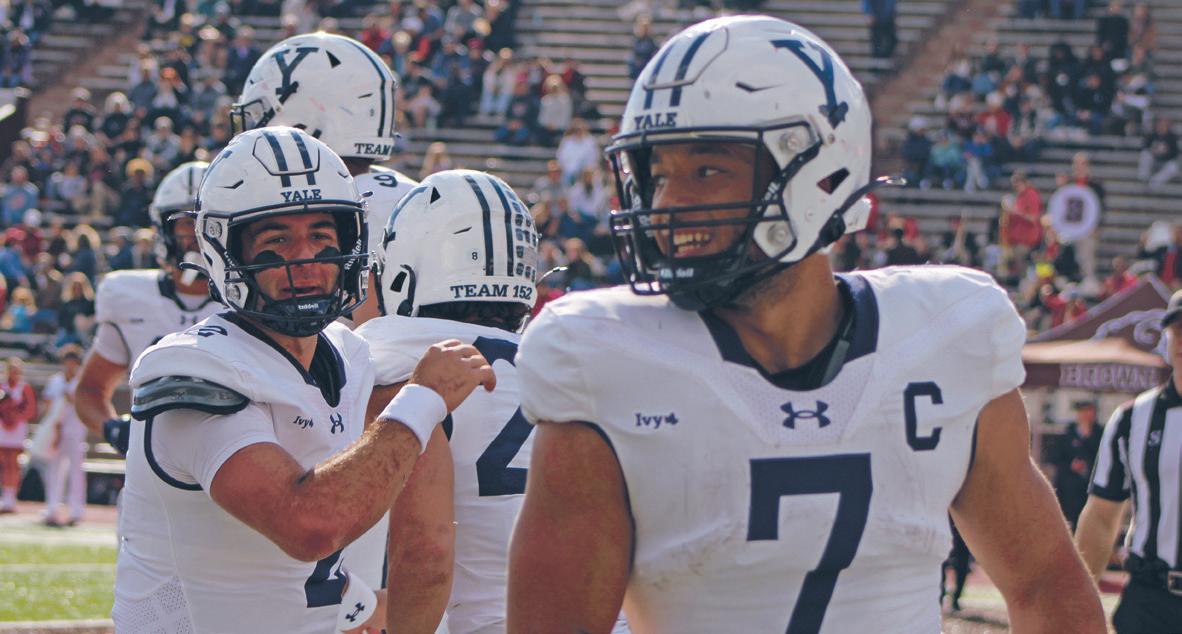
Quarterback Dante Reno ’28 has exceeded expectations in his first year with the team, ranking as the second-best signal caller in the league with a 148.9 passer rating, trailing only Harvard’s Jaden Craig. Reno has thrown for just over 200 yards per game at a 66.2 completion rate, as well as tossing 14 touchdowns and a league-best four interceptions. Part of Reno’s success has been due to the breakout season of wideout Nico Brown ’26. Brown, who was injured all of last season, has hauled in 687 receiving yards and is tied for a league-high nine touchdowns. Brown has had a co-star this season in Jaxton Santiago ’28, who is also having the best year of his Yale career.
Santiago has 480 receiving yards and four touchdowns of his own thus far in 2025. Against the second-worst passing defense in the league, look for Reno and company to air the ball out against the Tigers this weekend. On paper, Princeton does not seem too tall a task for the Bulldogs to handle, but there are no easy wins in the Ivy League, particularly in the season’s final weeks. Yale will need to play a clean, wellexecuted game before moving on to next week’s opponent. Kickoff is slated for noon on Saturday.
Contact BRODY GILKISON at brody.gilkison@yale.edu.
BY AUDREY KIM STAFF REPORTER
The Yale women’s ice hockey team (5–2, 2–2 ECAC) will return to Ingalls Rink on Friday to drop the puck against their longtime rivals, the Harvard Crimson (4–3–1, 2–3–1 ECAC), before taking on the Dartmouth Big Green (2–5–1, 2–3–1 ECAC) on Saturday.
“Coming back from our off-weekend last weekend, the team is definitely excited and prepared to play for some league points that are up for grabs,” forward Gracie Gilkyson ’26 wrote to the News.
The Bulldogs have played their last three games on the road, with a loss to Cornell (7–0, 4–0 ECAC) and wins over Colgate (5–6–1, 1–2–1 ECAC) and Saint Anselm (7–6, 7–1 NEWHA).
Both Harvard and Dartmouth play in the ECAC with Yale, which means that coming away from this weekend with a pair of wins would dramatically boost the Bulldogs’ conference ranking. “Getting points in this conference is always a challenge as anyone can win on any given night,” Gilkyson said. “The standings are usually pretty tight so getting wins when you can is so important, especially considering there are Ivy league points on the table.”
Currently, Dartmouth and Harvard both sit ahead of Yale on the ECAC leaderboard. However, both teams have two games in hand on the Bulldogs.
In the latest USA Hockey/ USCHO Women’s Hockey Poll, Yale rose from a national rank
of 13 to ten, marking the team’s fourth week of being ranked in the top 15.
While Harvard and Dartmouth are both unranked in the USA Hockey Poll, both teams each have two wins in the ECAC this season, a competitive conference with six of its 12 teams currently ranked the top 15 in the nation.
“Both our opponents this weekend are tough and play a gritty game. The traditional Yale vs. Harvard rivalry is always something we look forward to as a team as the competition level seems to ramp up a little more,” Gilkyson wrote.
In program history, the Elis have faced off against the Crimson 55 times, and in those matchups Yale has recorded 15 wins, 35 losses and five ties.
This season, the Bulldogs have shown that they can perform under pressure and are capable of rising to the occasion when taking on a tough opponent. So far, they’ve clinched two impressive overtime wins against Princeton (4–4, 4–2–1 ECAC) and Colgate (5–6–1, 1–2–1 ECAC).
Yale is currently on a two-win streak and has only fallen to two teams this season, No. 7 ranked Quinnipiac (12–1–1, 4–1–1 ECAC) and No. 4 ranked Cornell, in a game in which the Bulldogs outshot the Big Red 39-21.
“We’ve had a great 2 weeks of practice, with a strong focus on 5v5 team play,” Gilkyson wrote.
“The off-weekend allowed us to sharpen up some of our details and now we’re just eager to play some ECAC games again.”
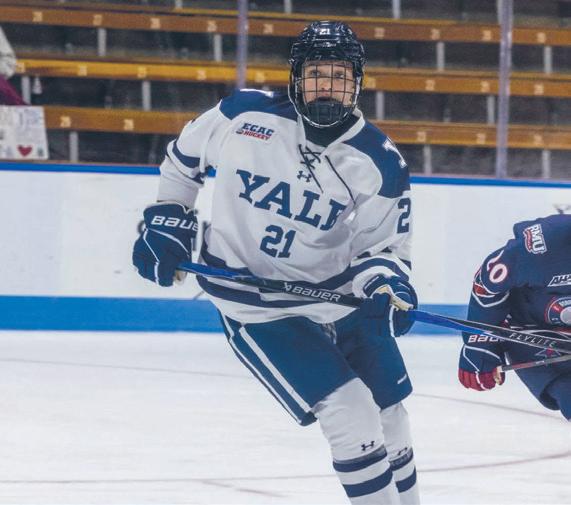
Yale will face off against Harvard this Friday at 6:30 p.m. at The Whale. Contact AUDREY KIM at audrey.kim.ajk234@yale.edu.
BY LIZA KAUFMAN STAFF REPORTER
The men’s hockey team (2–1–0, 2–0–0 ECAC) will head to New York for a weekend of ECAC matchups against Colgate (2–7–1, 0–2–0 ECAC) on Friday and Cornell (2–2–0, 1–1–0 ECAC) on Saturday.
“We’re working hard everyday to just keep getting better. Iron sharpens iron, so it is great when we practice hard, everyone gets better,” forward Micah Berger ’28 wrote in a text message. “Coach always says win today, so it’s just about that.”
Yale will face Colgate at 7:30 p.m. on Friday in Hamilton, N.Y., before taking on Cornell at 7 p.m. Saturday in Ithaca. Last November when the Bulldogs hit the road to play the two schools, Yale walked away with a weekend sweep. The Elis will now seek to replicate last year’s strong success.
Yale enters the weekend after two major upsets at Ingalls Rink, defeating then-No. 5 Quinnipiac (6–3–2, 1–1–0 ECAC) 4–2 last and Prince-
ton (2–2–0, 0–2–0 ECAC) 2–1 last weekend. The Elis’ victory over the Bobcats snapped Quinnipiac’s seven-year win streak over Yale, earning the Bulldogs first victory in the War on Whitney since 2018. The Bulldogs then rode the momentum from Friday night into Saturday night against Princeton. Zach Wagnon ’28 netted the overtime winner, securing the Bulldogs’ first triumph over the Tigers since 2023. Following the team’s weekend sweep, goalie Noah Pak ’28 was named ECAC goalie of the week after leading Yale to victories. He blocked 41 shots and allowed just 1.49 goals per game, posting a 93.2 save percentage. After strong performances from offense, defense and special teams, the Elis will seek to build on last weekend’s victories and add two more tallies to their win column against Colgate and Cornell, two schools with strong hockey programs.
“I think it’s just about turning the page and getting right back to work,” Berger wrote. “The weekend was
awesome, but it’s so early and we go one game at a time.”
Colgate will enter Friday night’s game on a five game losing streak. The Raiders started off the season with two games at No. 3 Boston University (5–5–1, 3–3–0 Hockey East), falling 2-6 in the first game and tying the second 2-2 before losing in the shootout. Colgate then lost to Canisius (5–4–1, 1–2–1 AHA) in the Raiders’ home opener before picking up a 5-3 win the second night of the homestand. The Raiders kept up the momentum as they beat No. 10 University of Maine (6–3–1, 3–1–0 Hockey East) 3-2, but then fell 2-3 in overtime the next night. This loss started Colgate’s five game losing streak, as they dropped games to RIT (7–2–0, 4–2–0 AHA) 1-3 and 1-4, Dartmouth (4–0–0, 2–0–0 ECAC) 1-4 and Harvard (2–1–1, 1–1–0 ECAC) 5-6.
Sophomore forwards Jack Brandt and Max Nagel are the Raiders’ top scorers, each tallying five goals, while Brandt, Isaiah Norlin, Ryan Sullivan, Michael Neumeier and
Daniel Panetta have each notched five assists. The Raiders’ goaltender Reid Dyck has an 87.0 save percentage, having given up 21 goals so far this season.
After Colgate, the Bulldogs will play at the home of the defending ECAC Champions, the Big Red, currently ranked No. 20 by USCHO.com.
Last season, Cornell defeated Yale 5-1 in the opening round of the 2025 ECAC tournament, then downed Colgate 4-1 and 3-0 in the quarterfinals, beat No. 12 Quinnipiac 3-2 in overtime in the semifinals, to finally triumph 3-1 over No. 18 Clarkson in the Championship Game. Following the team’s ECAC title run, Cornell earned a berth to the NCAA Tournament, and the Big Red beat No. 1 Michigan State 4-3 before falling to No. 8 Boston University 2-3 in overtime in the regional final.
This season, the Big Red are 2-2. Cornell opened its season with a 1-2 loss and a 3-1 victory at No. 13 UMass (7–4–0, 1–2–0 Hockey East) and then defeated Harvard 3-1 before falling to Dartmouth 1-2 last weekend.
The Big Red will play Brown (1–3–0, 1–1–0 ECAC) on Friday night before facing off against Yale on Saturday.
On the Big Red’s roster, two firstyears have already made their names known. Forward Giovanni DiGiulian has been an asset to Cornell’s offense, scoring three of Cornell’s eight goals this season. In the net, first-year goalkeeper Alexis Cournoyer has been a steady presence between the posts, with 87 saves and a 95.6 save percentage.
For Berger, the key to Yale victories this weekend is staying calm under pressure and cleanly executing plays.
“For us it’s about keeping that up and making sure we stick together as a group no matter what happens in the game. Playing to our identity and playing our style of hockey,” Berger wrote. “No changes, business as usual. It’s about us.”
The men’s hockey team has 29 players on its roster.
Contact LIZA KAUFMAN at liza.kaufman@yale.edu.
FRIDAY,NOVEMBER14,2025
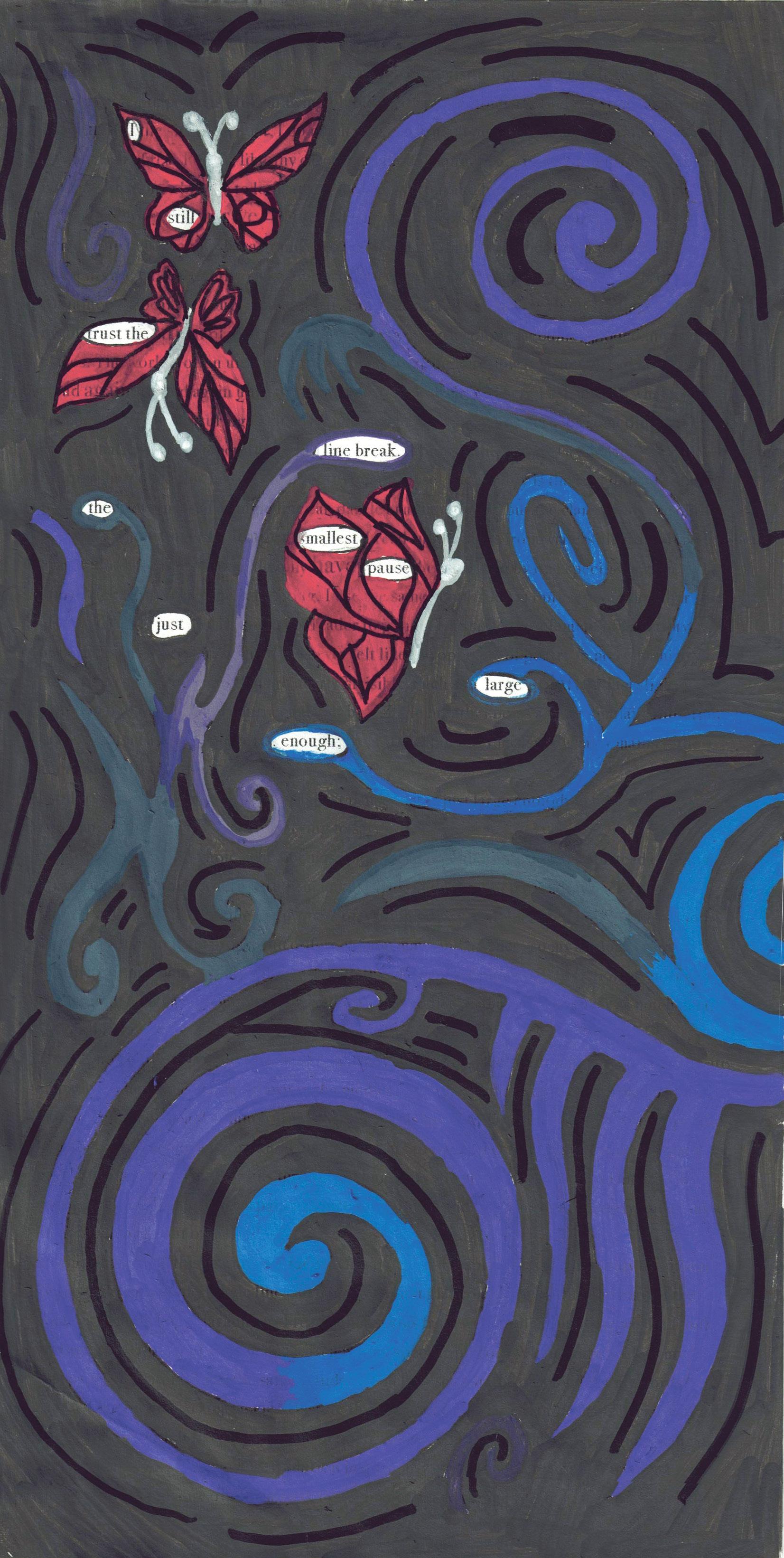
Writing a poem is like drawing blood. As a phlebotomist, I find the vein, steady my hands and clean the site. As a poet, I do much of the same. I never rush, just continuously watch for the flash of red. Poetry, like any careful, methodical practice, involves attention. What one notices, what one chooses to look at and look away from and how gently one handles what may unexpectedly arrive — these make up the process of writing poetry. Some write because they have grand theories about art, but I write because I feel certain moments are far too tightly packed for prose to carry them. A poem lets me take a small container — a beaker, a cup, a paper boat — and see what it can hold without spilling: a combination of words, characters, images and a couple metaphors added in various places. The work is often unglamorous, with fast drafting but slow revision. I read my work aloud again and again until the language stops wobbling. Then, I ask myself, what is my poem actually measuring? Is it an experience or grievance — or perhaps something more conceptual, like the temperature of a room or the shape of a silence? Editing sharpened this instinct for identifying
purpose. Hospitality is the first duty of a poem. Yes, the cleverness of a single line can dazzle at a first glance, but the clarity and care of the poem as a whole linger far longer. I read submissions from writers all around the world; I look for lines that could only have been written by one specific person. When I turn back to my own pages of writing, I use the same standard: Am I present on the other side of my words? Am I asking the reader to join me?
Despite this element of humanity, or perhaps because of it, science has never felt like the opposite of poetry to me. Chemistry asks you to notice changes that are nearly invisible, such as a solution just slightly clouding or a reaction warming a chamber by a single breath. Poems ask for similar calibration. In the lab, I measure what reacts. Writing poetry, I measure what remains — the afterimage of a reaction.
So my perspective is simple. The poem is where I can recenter my attention. Instead of being an escape from the world where I study in lecture halls and labs, poetry is a way back to it.
Which is why I still trust the line break. It is the smallest pause that is just large enough to hold, for
a moment, what someone is bravely trying to say. I found it difficult to describe the process of writing poetry until I learned how to draw blood. Poetry is different from prose, and different from math and science, so my analogues for creativity or problem solving were useless in this descriptive endeavor. In fiction, a short story is unbound. You have so much space, and with that comes the burden to convey as much detail as possible.
There’s no context for poetry. Instead, I’m trying to convey a feeling — it is a project of ultimate empathy. When someone sits down in the medical reclining chair to have their blood drawn, I have to be in their mind as much as my own. Will this hurt? Are they nervous? It’s disrespectful to poke into someone without knowing the answers to these questions.
In the same way, as a poet, I tap into the vein that runs through all humanity. It sort of hurts, and God knows I’m always nervous. But just like a patient, once I breathe in and close my eyes, I barely notice my life force flowing out of me.
Contact LEONARDO CHUNG at leonardo.chung@yale.edu
// BY BEATRICE BARILLA
Is there any good New Haven thrifting? Depends on what you’re used to. For me, a native of the South Carolina strip malls, Goodwill was the gold standard. In comparison, I’d say yes, thrifting here is pretty sweet. But if you’re part of Yale’s New York City population, well … I’ll give a taste of my experiences and leave it up to you to decide the answer to that question.
2nd STREET
Ah, yes. The newbie New Haven thrifter would perhaps think of 2nd STREET first — not second, if you catch my drift. This was my position some months ago, when I had not yet gone thrifting here and needed some retail therapy to cure my homesickness. It was an appealing site: close-by, two-tiered, big selection. I found some items that I did love (and did buy) but was a little put off by the downstairs section, where items sported hefty price tags.
The only real offense was a chunky, flower-embroidered sweater that I loved but that had a nice big hole in its side. And they would not give me a discount. Twenty bucks for a sweater I basically have to knit myself is not the steal I wanted.
To me, this reflects one of the bigger problems in the secondhand clothing world — isn't the point to encourage reusing clothes and making clothing more affordable? Why, then, has thrifting become an expensive hobby? Why are we unwilling to bargain so that the clothing isn’t wasted? Lately, a thrifted item feels like a status symbol
rather than a way to navigate an overpriced and oversaturated clothing market. That being said, 2nd STREET isn’t bad; it’s just not somewhere I’ve been compelled to revisit.
Audubon Street pop-up thrift market
Towards the beginning of the semester, Audubon Street became a thrift market. Like many, I dug through piles of clothes heaped on the ground, scoured countless racks and lost my friends in the overstimulating crowd.
My finds: a silky dress, a tulle skirt and a pair of jeans.
Unfortunately, while many items caught my eye, so did their prices. Yet again, it was evident that thrifting has become a hobby for the elite. Sure, the piles might have something promising for not too much, but I still felt like the whole ethos of thrifting was lost in the sea of students hungry for the best find. In order to find something affordable, I literally had to scavenge on the ground.
MINIPNG
I found this little gem on one of my walks out to the Coffee Pedaler. It’s a bit out of the way, but I didn’t mind the walk after sitting through class all morning.
The one-room shop definitely had more of its own character than some of the bigger stores, and I found one sheer layering top that I fell in love with. It was pricey, yes, but at least I understood why. Small businesses often have to charge more to stay afloat in a corporate market, so I can have some empathy for the comparatively
higher prices. Rent is expensive. If you’re looking for a more curated collection, rather than the cheapest deal, it’s one of the more unique spots I’ve happened upon. I can’t say I’d have the money to go often, but I would prefer spending 20 dollars there than on a sweater with a hole in it.
Student pop-ups
Here it is, the single best thrift in the city: student sellers. I’ll wait while you roll your eyes. The best deal, best items, best interactions I’ve had are with students selling their own clothes. Let me explain.
A couple weeks back, I found my friend’s sister selling her clothes on the path between Jonathan Edwards and Branford. This was a refreshing thrifting experience. I think the essence of thrifting — finding something that feels both personally new and affordable outside of a corporate system — comes back into focus through a more personal interaction with the seller. Looking at someone else’s clothes and being able to silently — or loudly — communicate, “OK, we’re both broke,” and then make a deal that suits everyone cuts down on anxiety. There is also an assurance of directly helping someone by buying their clothes. So, student pop-ups win in every category. As long as there are students, there will be good thrifting in New Haven.
Contact BEATRICE BARILLA at beatrice.barilla@yale.edu.
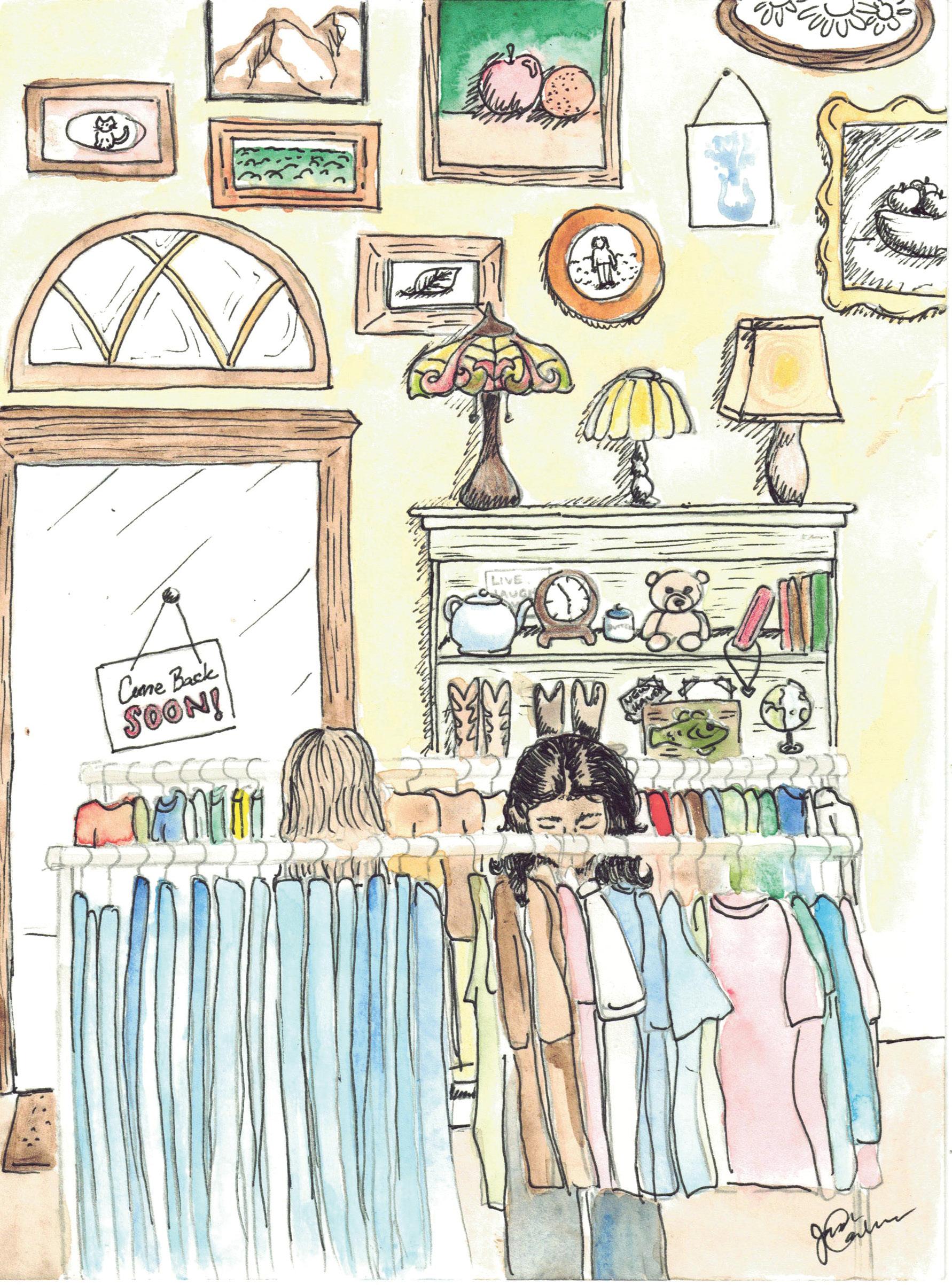

// BY INEZ CHUIDIAN
How many kids do you want? Are you bisexual? On a scale of 1-10, how important is sex in your relationship? Do you mind if your partner does hard drugs?
The Yale Marriage Pact presents itself as a series of intrusive questions that many of us have failed to consider. It’s an interrogation of preferences we didn’t know we had and a questioning of our upbringing. To some, it’s a stupid survey we tried once our freshman year, but to others, it’s a wholesome way to meet faces we might have never crossed paths with in our time at Yale. If anything, it’s an undeniable meet-cute that no couple would object to: “How’d we meet? We were each other’s marriage pacts.”
Whatever this algorithm may mean to us, it must mean enough — because time and time again we find ourselves sitting at the back of the classroom, clicking through a blunt questionnaire, fantasizing romantically about the future as we debate: “Question #27: Would I marry a conservative?”
The form lands in our inboxes like clockwork. And without fail, every fall, we troll our answers and exaggerate our preferences. We roll our eyes, then broadcast our match’s initials like breaking news, scouring Yale Facebook for their major. Though no student would ever admit it, behind the black and neon interface of this survey lies a small thrill in the idea of finding a perfect stranger across campus — someone whose perception of you remains completely untainted.
Maybe that’s why we keep filling it out. I think that we as students have more faith in serendipity than we think. Amidst the impossibility that we all seem to perceive in Yale’s dating scene, there is certainly a portion of us who hope for this pact to mean more than the myth of the Yusband — for this matchup to be a reconciliation with the fact that our circles here are fluid and there will always be someone we are yet to meet. After all, the Marriage Pact is just one of many games we play with fate. From sorority blind dates to AI dating sites on Fizz, we toy with the idea of a perfect match more often than we’d like to admit. To come to college in search of a partner while your peers author novels, win national championships and found startups feels almost like an insult to ambition. Why bother? Because, I’d argue, the Marriage Pact deserves more than a laugh and a Fizz post. As someone who didn’t fill it out, I’d go as far as to say this algorithm and violation of personal information represents the spontaneity we lack in our day to day. Yale students are stubborn. We have a life plan, we’ve made friends and we’re on track for our degrees. Rarely do we stray from our Google Calendars to share a meal with someone out of routine — and our mockery of traditions like the Marriage Pact reveals that. We’re risk takers, but only in theory.
So go on a date. Make a friend. Get a coffee. The Marriage Pact has passed, but let this be a reminder of the serendipity and spontaneity it evokes within us. Too much of our lives are fixed into gridlock — so why not leave a few parts of it up to fate? And who knows? Worst case, you’ll leave with a story and maybe, just maybe, an answer to question #27.
Contact INEZ CHUIDIAN at inez.chuidian@yale.edu.
As a photographer, capturing someone else is scary. I talked to portraitist Seoyoon Kim to find out how she does it.
// BY MARTIN PERALTA
I have always found it unusual to ask someone if I can take pictures of their face. Surely, I cannot expect to ask someone, “Hey, can I take a photo of you, from the shoulders up, and can you, you know, keep the facial expression you have right now?” and for them to give an honest reaction — or any reaction at all.
That is my fear: that I will not be able to capture someone in a way that they will appreciate. Especially once they have some stake in the way they look in the image.
But people do love candid photographs. Not the kind of candid where a friend is asked, “Hey, will you take a candid photo of me?” Real candids. There comes an implicit request when you ask someone to take a photo of their face: Try to look different. Switch up your face and pose so that I can take a picture where you look exactly as I want you to.
Once the subject is an active participant in the photograph, their reaction becomes unpredictable. I can take a picture of someone and find it visually appealing, but they might not feel great about how they look. Take away the pressure of trying to look a certain way, and people find joy in seeing themselves.
These are some of the millions of considerations I have running through my head about portraits, because photography seems to me to be more unpredictable. I am, therefore, in awe of anyone who can silence this cacophony of worry and simply manipulate a face in all of its detail. Portraitists are the most fearless artists of all.
What reason could one have to paint a portrait?
In an effort to investigate this question, I interviewed my friend Seoyoon Kim ’29 because I knew about her art and wanted to look into her thought process.

I found her outside the Silliman Courtyard wearing red Onitsuka Tigers shoes that she got from Korea, a green-and-pink skirt with a tie-die-like pattern, a beach top, a green sweater and a lot of jewelry from thrift stores. I wanted to ask her about this fearlessness that I believe portrait artists have, and I wanted to know what it means to create a face of one’s own as opposed to capturing one exactly as it is. I was coming out of a critique of my own photography, where I got a much-needed wakeup call about creating context. Essentially, I was told by a mentor that the way I put the subject in focus should communicate the context of my thought process
prior to pressing the shutter button. I think I am improving at planning out a shot beforehand.
The same thought is involved in Seoyoon’s painting. She makes a note to put specific features into focus. If you want to capture someone’s happy moment in time, there are certain symbols that should enter the mind. A warm smile or eyes that are wide open.
“You don’t have to capture every detail, just the important things,” she told me. “Or just like capturing the essence of the person, especially if you know that person better, there are things that you know you can bring out by drawing faces.”

I had to ask Seoyoon about what she considers in the curation of drawing facial expressions, because her work consists of a lot of faces. Her ancestry heavily impacted her ethos.
“I think Korean culture is so critical of how you look, and I just think growing up in that environment made me aware of it,” she said, “not as in an evaluating way, but in appreciating the different features everyone has.”
Her portrait art is powerful in its celebration of many features, and it purposefully rejects the idea of perfection or cultural norms and beauty standards of how one should look. Maybe when one person feels like they are undesirable, they can take a look at the portraits of people who look like them and feel comfort in their traits being reflected.
I believe that in the same way people can draw and reflect people’s unique traits, there is a similar reason why people like candid pictures. Even if they weren’t focused on being perfect, they still like the way they look. They are happy to catch a glimpse into their authenticity.
What experiences influence the art?
I take pictures because I am in a place and it occurs to me to take a picture of that place. The story behind the image is grounded in that moment in time. I have a picture of a building on Valencia Street in San Francisco that I took while helping my sister move out of her apartment, and I remember the distinct beauty of the buildings that form the streets in the Bay Area. The extremity of the environment helped me sympathize with my sister as she undertook a move to the East Coast to continue school, not knowing that a year later I would make the same transition. She never had me take her picture as she moved. Maybe, as I have told myself since, that’s because she was trying to avoid looking back. Ideas and “existential debates in high school” are what motivate Seoyoon to create. Seoyoon shows me her art, and I see the ideas that inspired her.
“It came a lot from the things I read, and the classes I took,” she told me as she described her work. “I really am fueled a lot by discussion, and I didn’t want to be in a place where people are only into art, and here, there’s a diverse range of people you can gain inspiration from.”
Three months ago, I had never had access to so many discussions or viewpoints about
something like portraiture or storytelling. There are so many people I get to talk to here at Yale, and I have discovered areas where my life and interests intersect with theirs. As I begin to look back, pictures of my friends here together mean so much more to me than a simple reminder that we once met.
My own critique of my photos is that my reasoning is only visible to me; the experience is hidden from everyone else.
Wanting to find a photo of my sister right before she moved, I searched and found in my camera roll a picture of her looking down and petting our dog. I usually get photos of her looking away, but I interpret her gaze in this particular photo as ambiguous. Perhaps she looks forward to changes in her life, or maybe she really didn’t want to look back. Maybe if I had taken the time to capture her face at the moment she left, I would have an image that assured me that moving across the country was a decision I was also ready for. The missing detail in the face reminds me that life is different for everyone, and I make my own experience.
What comes next?
One of Seoyoon’s most recent projects was for a studio art class called Visual Thinking, where artists were tasked to make prints using solely mark-making with mediums like charcoal and eraser.
At the time of the assignment, she was “feeling particularly homesick,” she said. She drew Harkness Tower on a sheet of paper covered in charcoal, using an eraser to mark the people in it. She recognizes “the process of familiarizing yourself with a new environment and how uncomfortable that could be,” through the techniques of the painting, starting by completely changing the canvas, to slowly “marking out” different people and experiences.
“It’s very subtractive,” she said. I have never shot a profile in my life. But there is something about the curating facial detail — it is a responsibility that falls to those who wield pens, or brushes or whatever form of capturing that is around.
On Thanksgiving, it will be just my sister and me in Atlanta. She loves riding her bike in Piedmont Park, going out to shows and hanging out with people she cares about. Now that we are both situated, far from home, maybe I will take her picture.
Contact MARTIN PERALTA at martin.peralta@yale.edu .
// BY CIELO GAZARD
The Rock and Roll Hall of Fame has a problem. Depending on who you ask, the problem can be a variety of things. The Rock Hall’s bias toward acts in the English speaking world. Its inclusion of pop and hip-hop musicians in more recent years. The lack of women and people of color inducted, or the major rock acts continually snubbed year after year. While some of these arguments are genuine and valid critiques, I think the concept of a music hall of fame is counterproductive.
Music is not a sport. No winners, no losers. Obviously, there are hierarchies in regards to success — who sold more records, who is deemed more “influential.” Is that the Rock Hall’s justification for its existence? To be a metric of musical importance?When the Beatles formed in the early 1960s, their ultimate goal wasn’t to be inducted into a hall of fame chosen by so-called “rock experts”— mainly industry executives and music journalists who wrote for Rolling Stone Magazine — or have their memorabilia on display in a museum in Cleveland.
But what do musicians or bands gain from being inducted into the Rock Hall? Quite a bit, as sales and streams for artists increase after being inducted. Some bands extend their tours following the bump in media attention. In a 2011 piece about the Rock Hall for the New York Times, Janet Morrissey writes, “While winning a Grammy often helps one album, a nod from Cleveland can lift
an entire back catalog.”
So, if there is a monetary incentive for getting in the Rock and Roll Hall of Fame, why won’t the Hall induct musicians who didn’t see commercial success in their heyday?
Dissenters often point out the lack of women in the Hall. Of the over 400 musical artists inducted, only 76 are women. Only one all-female rock group — the Go-Go’s — has been inducted. Why aren’t all-female groups who came before them getting their flowers?
The Rock and Roll Hall of Fame has a physical location: a museum in Cleveland, Ohio. If the museum intends to educate visitors about the history of an entire genre of music, it must recognize the many groundbreaking women who often go overlooked in the history books. Additionally, any telling of the history of rock music without mentioning its black musical tradition is not only incorrect, but inherently racist. The Rock Hall must take a stand against those who think the genre is a white, heterosexual boys’ club.
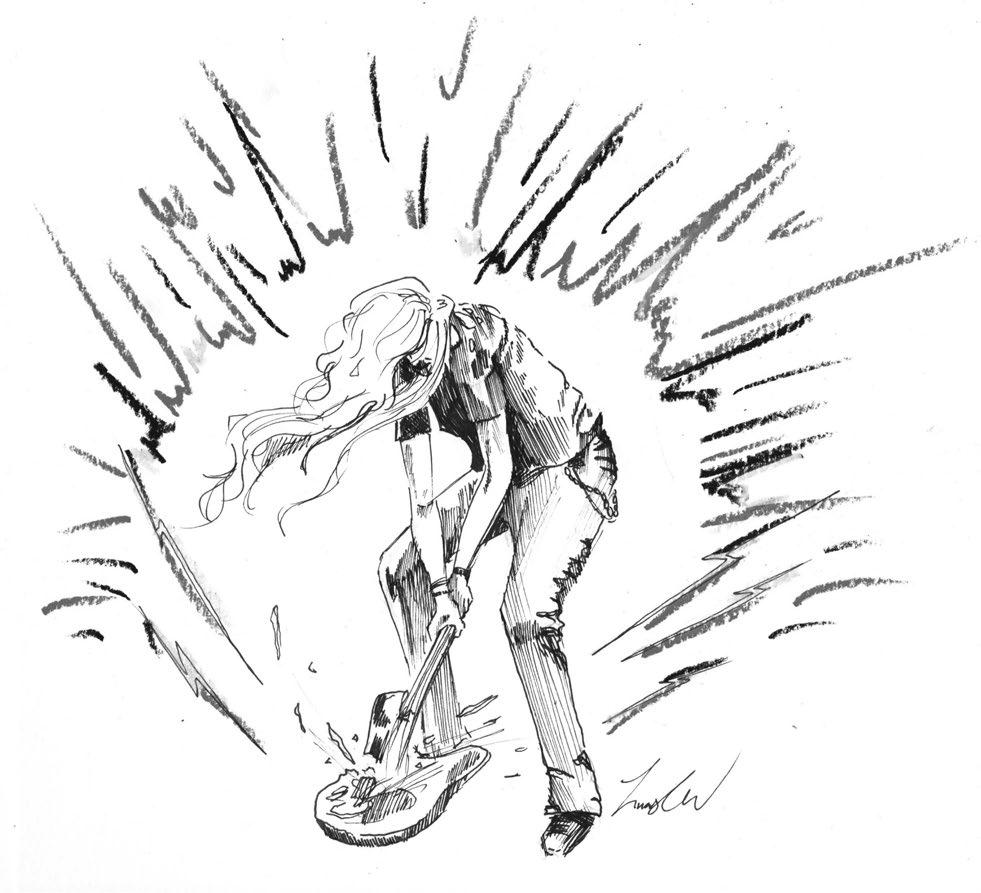
including Jay-Z and Missy Elliott, point to rock and roll as being more about the attitude than it is musical conventions.
Elvis Presley has little in common sonically with acts like the White Stripes, but no one would deny that these acts both fit the definition of “rock and roll.”
On the question of genre, some criticize that the Rock Hall has included one or two hip-hop acts every year for the last decade. Many of these hip-hop artists,
In a shock to no one, the Rock Hall’s co-founder Jann Wenner was let go from the board in 2023 after calling female and black musicians not “articulate” enough to be interviewed for his book about the so-called all time greats in rock. Is this who we’re letting dictate importance and “the greats”? Who is to

say who is more worthy of praise than others? No two people’s music tastes are exactly the same. We as a society need to stop making music a contest over who outsells whom, or who has more Instagram followers than whom. Let musicians be musicians. Tell the whole story of rock and roll, not a watered down version pleasing the lowest-common-denominator boomers. Rock and roll is alive and kicking. And maybe it doesn’t belong in a museum. Contact CIELO GAZARD at cielo.gazard@yale.edu.
I am utterly incapable of associating songs with their names. At a Playboi Carti concert last Saturday, I was
unsurprisingly unable to produce titles for the songs I’d recited from start to finish in the Uber en route.
It’s not that the connection between song and title doesn’t exist, it’s that it only goes one way. Give me a title and I’ll reproduce my favorite songs wordfor-word, but give me a song and all I get is a memory.
Halfway through Carti’s set, I heard no more than the first three synth notes of “Like Weezy” before I was transported back to the first time I listened to the track. Instead of the skull-crushing chords pounding from the gargantuan concert speaker system, I remembered hearing tinny, muddied bass from a borrowed airpod as I walked through a statue garden with a friend.
On a run later that weekend, a playlist gem set my pace: Quevedo’s and Bizarrap’s “Music Session.” I felt the Minnesota sun — from three summers prior — on my back for a total of 3 minutes and 19 seconds.
Time travel, it seems, is possible — not through some quantum-tech that exists only in Science Hill dreams, but through meticulously-curated playlists and platinum albums by favorite artists. For many, this time travel is a subconscious act: My mom tunes the car’s radio to the “70’s on 7” station for an early-childhood throwback. Music-by-the-era tells outsiders, like my Gen-Z self, about the zeitgeist wayback-when. For my parents, Simon & Garfunkel and The Velvet Underground transport them to their childhood
// BY STEPHANIE ALTSCHUL
homes, their elementary school best friends and the very first album they purchased with saved-up bus money. Emotionally, too, we’re transported. Speaking personally, and perhaps embarrassingly, I’ve shed more tears to Ken Carson than I have to Jeff Buckley — mixed in with a very reasonable amount of Lana Del Rey and Joni Mitchell. Guilty pleasure songs, as well as those that might not fit in a perfectly curated Late-Night Blues playlist, are not foreign to any music lover.
As a society, this knack of ours is applied in a few ways. More than associating our own music with past experiences, we ascribe meaning to the taste of others. “Performative males” listen to Clairo and Beabadoobee, while a taste aligned with Playboi Carti’s Opium label may be associated with traits such as evilness or manipulation. These are entirely common, unbiased views and in no way reflect my own opinions of Carti-listeners. Surely. This time last year, I spent a monstrous amount of time pondering the “soundtrack to my life” for college applications. I looked through my current aural fixation playlist and landed on Lauryn Hill’s “Everything is Everything.”
Admittedly, I’ve moved on to a different soundtrack. I listen to different songs daily and am, also daily, associating these with new memories, new people and new feelings. “Everything is Everything” might not be the soundtrack for my entire life, but I know that twenty years from now, I’ll listen on a whim and be transported to the fall of my senior year in high school, sleeping in and collecting songs for a, now stagnant, high school throwback playlist.
Contact STEPHANIE ALTSCHUL at stephanie.altschul@yale.edu.
Matt Weinberger’s lens has become the velvet rope of downtown New York.
// BY CODY SKINNER
Is there any good New Haven In today’s New York City nightlife circuit, being in the hottest room is one thing — ending up in a Matt Weinberger frame is another. His flashy, sultry portraits of stars like Charli XCX, Julia Fox and Sabrina Carpenter — shot from the hip in crowded half-lit corners — now circulate as the visual shorthand for the city’s party scene. Posted to his Instagram @mweinbergerr, his photo albums are the spiritual Social
Register of this decade.
A meme posted on the Instagram account @ Nolitadirtbag asks: “If a person goes to a party and doesn’t get on Weinberger’s grid, did they even go to the party?”
I first recognized Weinberger’s work online after seeing him at several New York gatherings — always easygoing, weaving through packed rooms to get his shots. He’s become a fixture of the city’s nightlife,
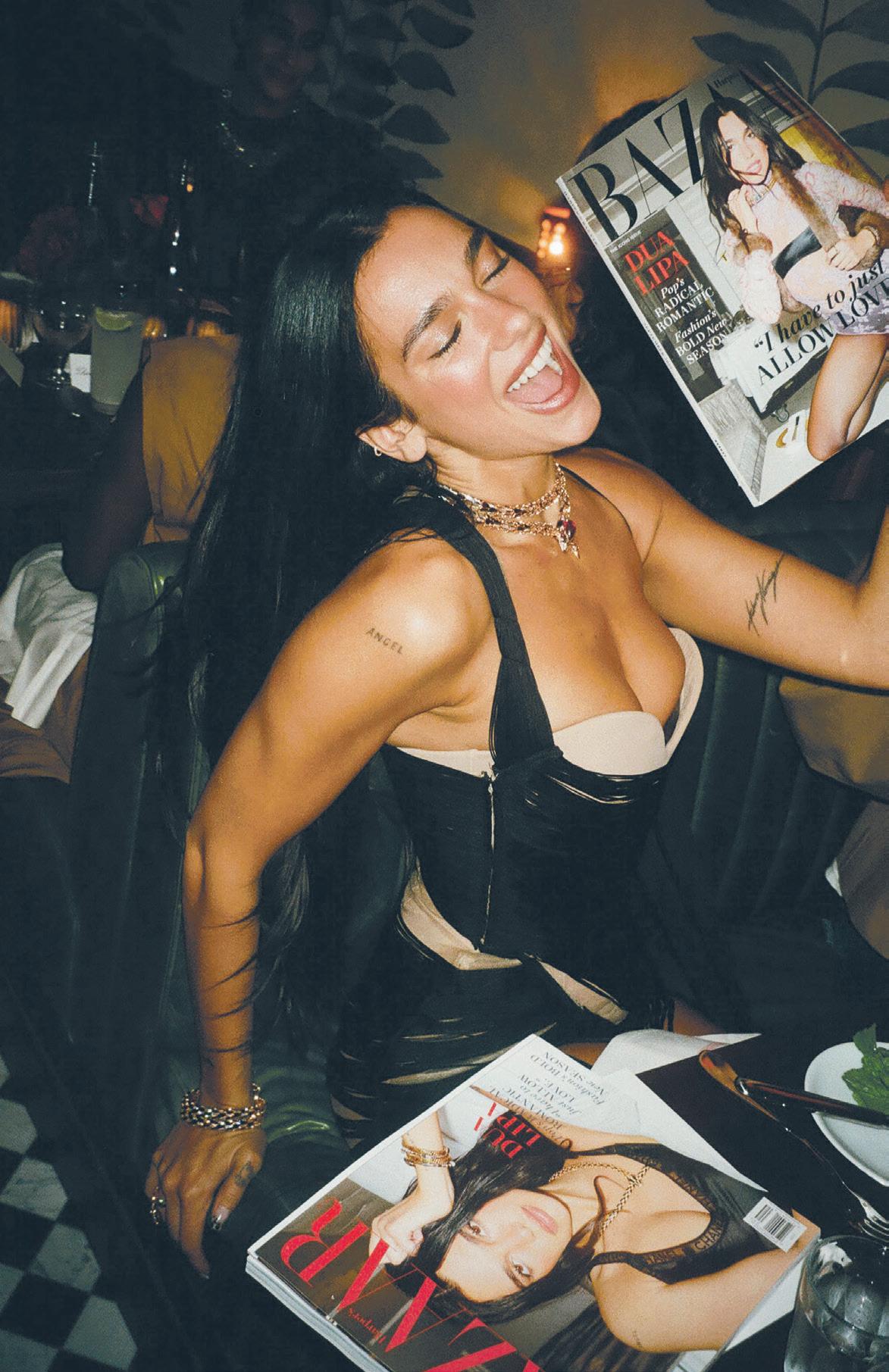

showing up at every party and event. A culture has formed around his growing archive — not just those angling to be included, but onlookers scrolling to see who was. He features celebrities, who draw attention to his feed, alongside regular partygoers, who become part of the visual record. In New York’s party scene, being photographed by him has become a quiet signal that a person — and a moment — belongs to the culture of this era.

“IF A PERSON GOES TO A PARTY AND DOESN’T GET ON WEINBERGER’S GRID, DID THEY EVEN GO TO THE PARTY?”

To understand his process, I sat down with Weinberger on a virtual call.
“The role of a nightlife photographer,” Weinberger explains, “we kind of take on the role of curator, as far as the mythology of how things are remembered.” By moving through all corners of the city’s social world, he aims to capture “a whole broader cultural moment.”
Weinberger treats every image as an editorial choice — less about glamour than preserving an honest snapshot. His photographs,
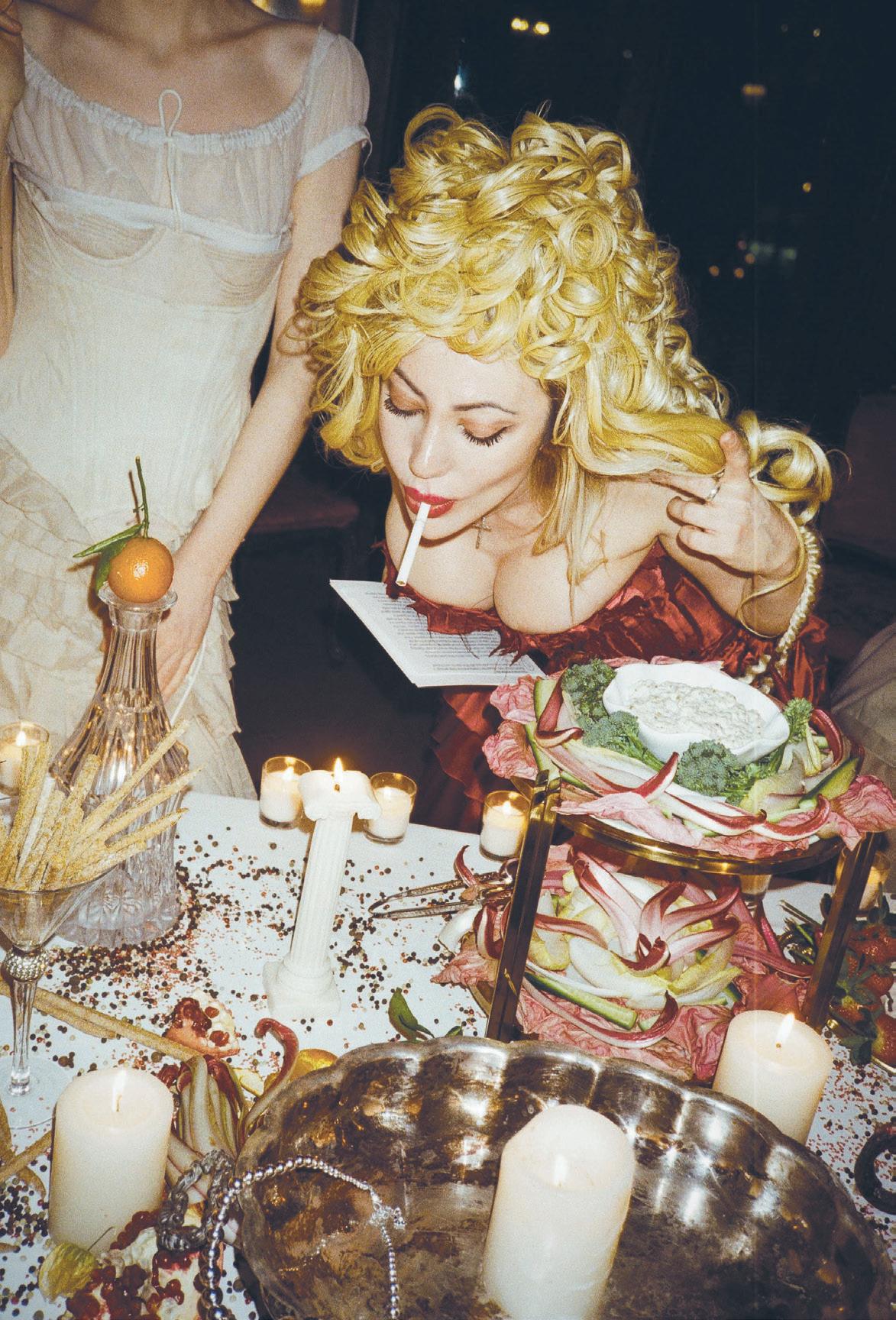

now shown in galleries across the city, define the visual canon of the 2020s and reframe the archival role of the party photo.
Weinberger’s relationship to nightlife began not in clubs but in art books. Raised on the Upper East Side, he studied art history at the University of Wisconsin-Madison. After the pandemic, he returned to New York, camera in hand, as the city’s social scene regained momentum.
“Something I had read about and looked at in pictures were images from Studio 54, from CBGB, from Warhol's
factory, and there were all these bygone eras of New York,” Weinberger recalls. “I missed, like, the best time to be in New York ever.”
Although he knew every generation looks back nostalgically, he also sensed we may be living through our own renaissance. “My thought was like, yeah, these things are probably happening, I just don't know about it. But in 20 years, when we look back at history, we'll see who becomes the whos and the whos and the whos — you know, the people of relevance.”
WEEKEND RECOMMENDS: WEARING YOUR SUNGLASSES AT NIGHT

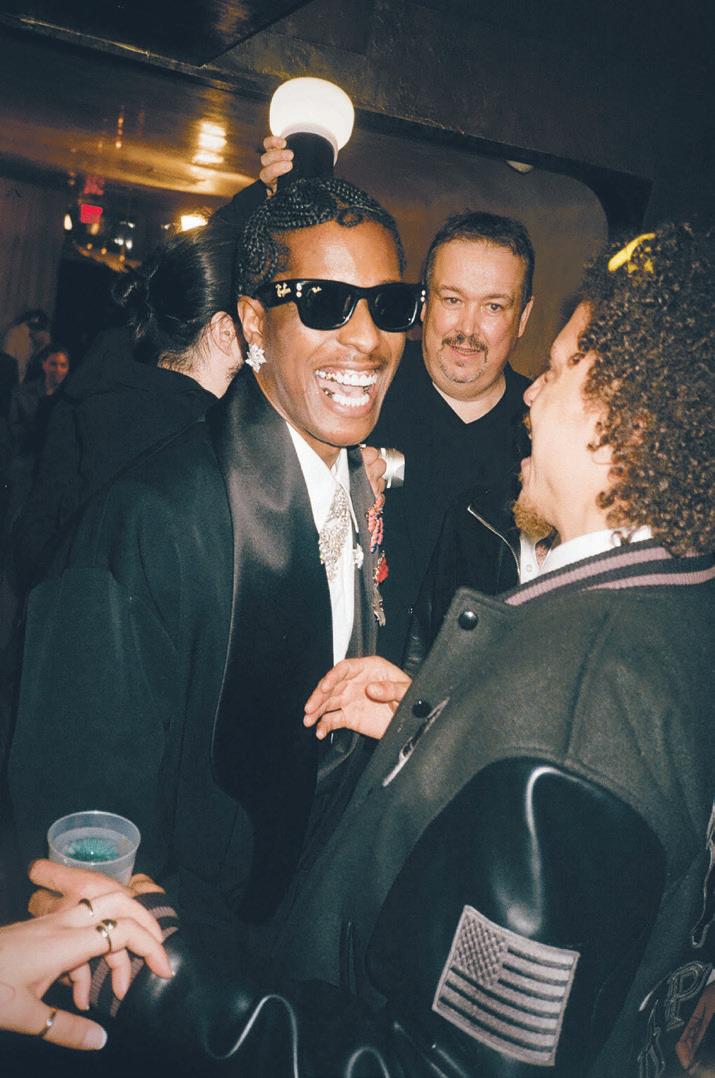
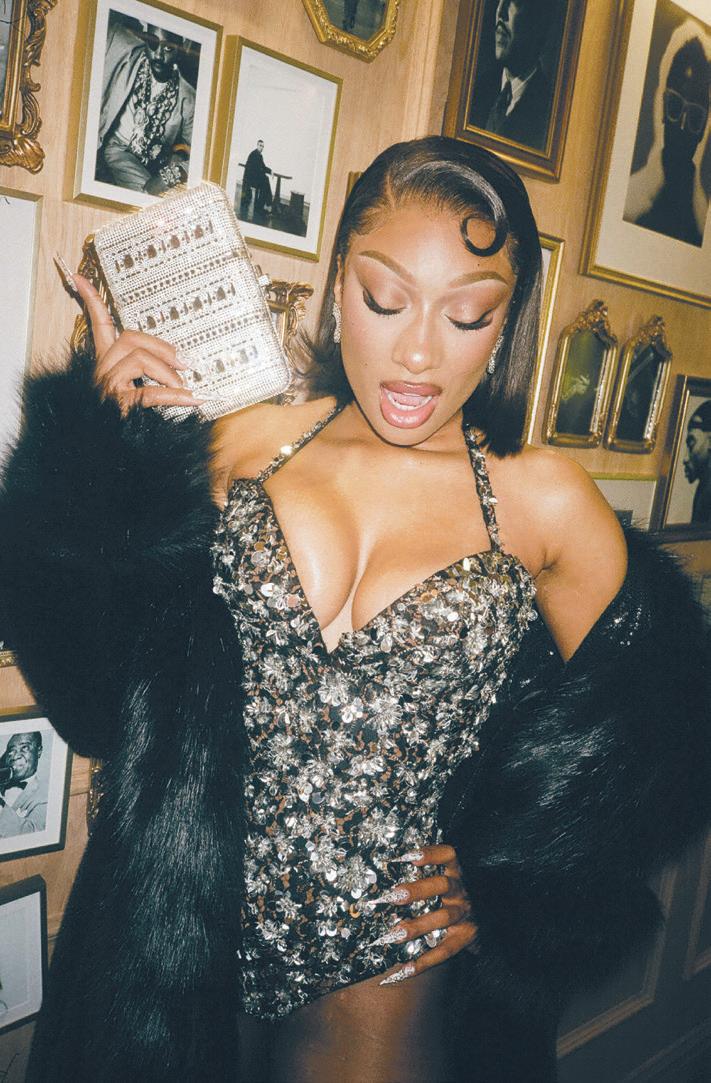
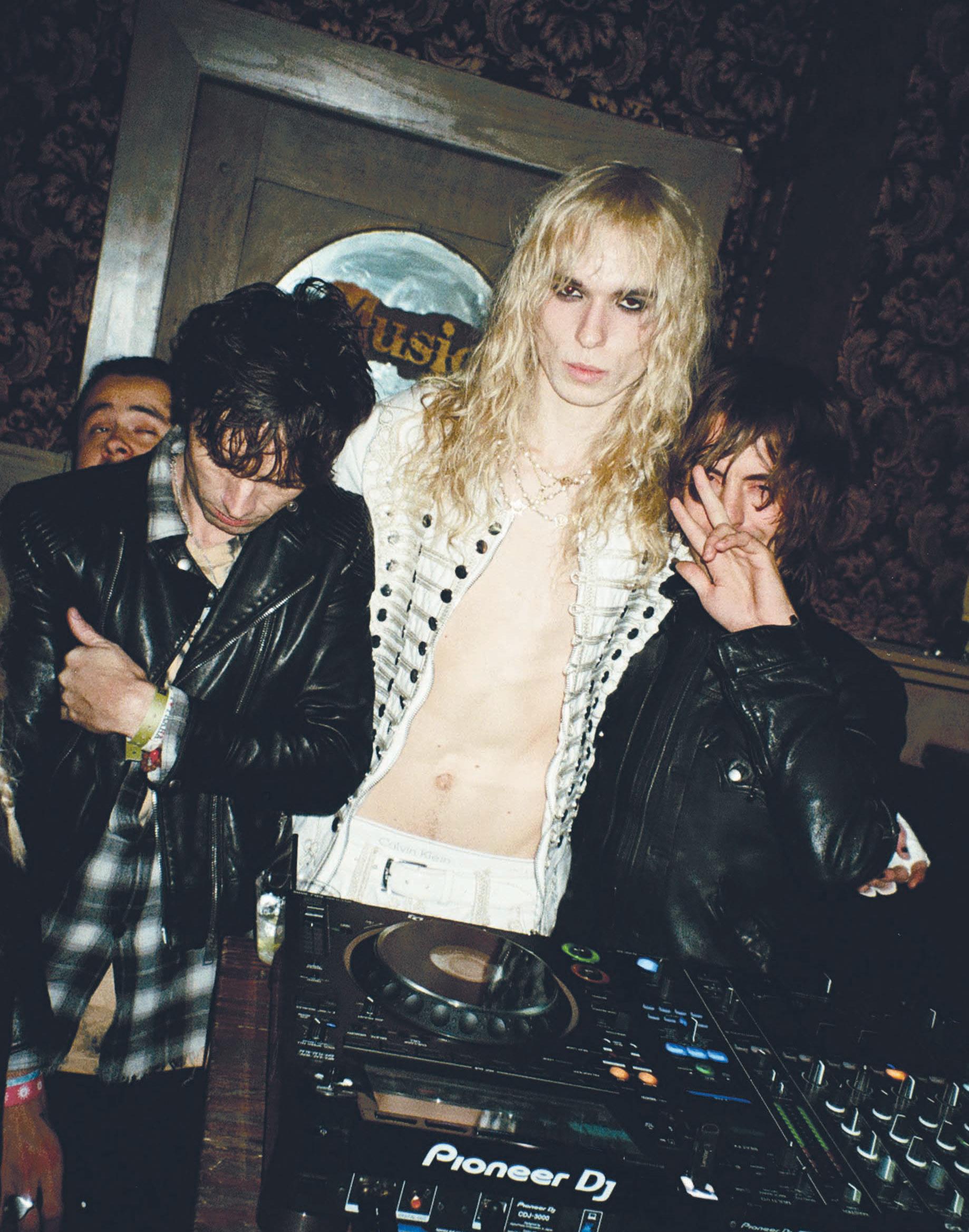
What separates Weinberger from paparazzi is trust. In a space where images can be misused, his access is earned with persistence, respect and restraint. That pact keeps doors open, helping him build relationships with celebrities and gain entry to spaces that usually shut cameras out.
His work is grounded in a photographic lineage. Weinberger shares a downtown studio space with The Cobrasnake, aka Mark Hunter, and stays friendly with NYC and Los Angeles photographers like Myles Hendrik and Tyrell Hampton.
“There’s nothing greater than if I’m photographing something or someone or some moment, and there’s a million other, not a million, but like tons of other people photographing the same
friends, artists and regular partygoers — who form New York’s creative underground. He says Hunter’s catchphrase, “YOU’RE A STAR ON THECOBRASNAKE.COM,” reflects his belief in equal treatment, giving everyone the chance to become the focus of their own shot.
Weinberger says photographing people who aren’t known feels most important, but for his practice, celebrities are essential too.
“When you have a known face and a known individual, they are markers of a time and place in culture and in history, and then to put normal people next to them, having the celebrity there provides the context and provides the kind of esteem needed to then elevate all the other images in that moment.”
Weinberger seems acutely aware of the role he plays, within his niche and beyond. With that comes an awareness of risk — once an image
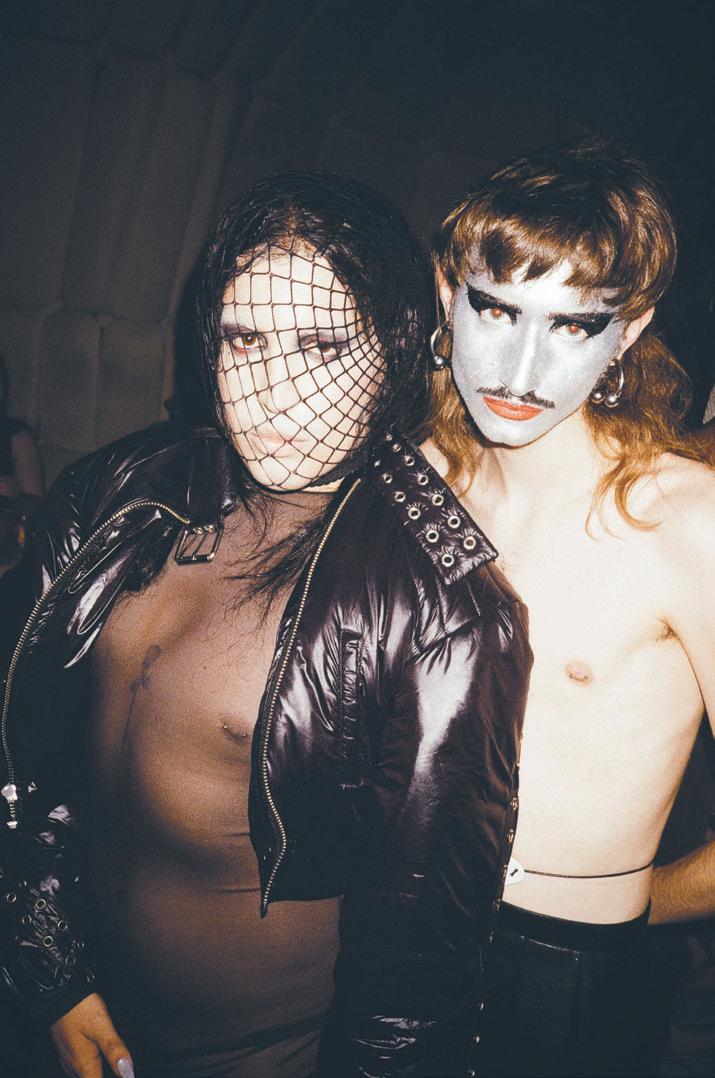
thing,” Weinberger explains, “it sort of validates that what I’m doing might be the right thing and that what I’m documenting is worth documenting and will enter the cultural canon.
Weinberger describes his approach as “improvisational photography,” unscripted shooting without environmental control. Unlike studio portraiture, where lighting and composition are pre-planned, nightlife is unpredictable and Weinberger embraces that as part of the image.
He divides his work into true candids, portraits and what he calls “performatively candid shots” — where subjects know they’re being photographed but act unaware.
“I think it’s actually very important to note, when you have a camera, versus having an iPhone, the way people react to that is different. When you take out a point-andshoot film camera, I think that people are a lot more at ease than if you're doing an iPhone photo,” Weinberger adds. “It's just a whole different vibe and energy.”
Weinberger plans to release a book about his philosophy on photography called “Seen or Not Scene,” and hopes to show more of his work in physical spaces.
Although celebrities appear, Weinberger centers the nonfamous —
enters the public sphere, it can take on unintended meanings.
At the latest Paris Fashion Week Saint Laurent show, he photographed Hailey Bieber, Zoë Kravitz and Charli XCX, not realizing that Rosé — of BLACKPINK fame — sat just beside them, her shoulder barely visible on the side. When the image ran, some fans assumed the crop was deliberate.
“All of these people, like her fans online with the magazine that published it, were, like, getting mad at this magazine, saying, ‘Oh, you're intentionally excluding Rosé,’” Weinberger recalls, explaining that the moment became “this whole big thing that people were assuming was a highly thought out, politically motivated way of putting down this musician. And for me, it was something I did without much thought, where I was just doing a photo of the people I knew.”
Weinberger’s photography — glossy, flash-lit and full of recognizable faces — is a historical record in real time, preserving art and connection. He’s part of a lineage of photographers who’ve ensured that these scenes, however fleeting, are documented into a larger cultural memory. In that sense, there’s a humanism in what’s going on both in front of and behind the camera.
Weinberger ended our talk on a thoughtful note, saying, “This sounds so cheesy, but don't do drugs and alcohol in excess, because I’ve seen so many really great people with a lot of potential throw it all away because of addiction and problems with substance abuse.”
Though brief, the comment reflects a genuine care for the spaces he photographs and the people who inhabit them. He embodies that New York myth of beating down every door. In a culture obsessed with virality and “industry plants,” his success feels refreshingly earned. And perhaps there’s a moral to his story — to showing up again and again — that we can all learn from.
Contact CODY SKNNER at cody.skinner@yale.edu.